#panels are from 'Superman: The Last Days of Lex Luthor'
Text

I'M SORRY WHAT. WHAT.
Superman is a walking fMRI?? You're measuring the BOLD contrast in real time?? You're an EEG?? You're measuring the electrical charge of neurons??
Leaving the ridiculous overpoweredness of that aside, this is just not how it works! You can't criticize polygraphs for being unreliable because they measure pulse rates or skin conductance responses, which are just an indication of arousal states and not valence; they can indeed mean intense reactions for a myriad of different reasons, not just anxiety induced by lying. And then, present yourself as a more exact measuring instrument for lying, because the same argument regarding unreliability applies to amygdala activity! It isn't active just for fear or threat, it's part of a much bigger neural circuit and contributes to so many other psychological processes. For instance, there's many studies showing that amygdala encodes emotion more broadly, not just fear, and is highly important for conditioning and creating habits. And don't even get me started on dopamine, it's one of the most important neurotransmitters and its signalling is similarly related to many brain regions, circuits and processes-- including motor control, emotion processing, memory. You can't just say "Aha, dopamine in this guy's brain, he's lying!" when the guy might just be existing.
I haven't been this annoyed since Snyder's introduction of the drug Diaxemene, that apparently makes a psychopath's amygdala more active and suddenly cures their lack of empathy. I'm not even gonna start rambling about that one.
#this rant was brought to you by a long suffering comic fan who's also a neuroscientist :)#Mark Waid I'm in your walls#panels are from 'Superman: The Last Days of Lex Luthor'#which minus the pseudoscience I've enjoyed A LOT#the C/lex is so strong in this one holy shit#rants.txt
32 notes
·
View notes
Text
Newish Comics:
Batman #146: okay so this story is finally actually picking up from where The Gotham War left off, with the same fault lines still in place. This is good actually! I am very soft that Damian's determined to keep believing in Bruce (especially as they're also spending quality time together over in Batman & Robin). Also I'm still enjoying Vandal Savage being annoying (sorry not sorry).
Birds of Prey #8: This comic is being written for queer women who like reading about women and I for one salute the entire team for their (fan)service. Excuse me. Several of those Barda panels and Dinah screaming for Barbara are going on my iconic list immediately.
Blue Beetle #8: Roma quits, Oo’li has a crush on Jaime, Jaime finally finds out Brenda is working for Victoria, and Victoria just gets even more on-page evil. I can't believe this is the last storyline we're getting before this gets cancelled, dammit.
Shazam! #10: I had to stop to howl with laughter about every third panel of this. Do yourself a favour. Read Shazam! Darla’s flying with Hoppy on a Pegasus. Freddy just got his licence and bought the Shaz-van! Also omg the lettering for the dragons!
DC’S Spring Breakout! #1: A mixed bag.
The Harley Quinn and King Shark story certainly happened (and I've read better versions of it).
The Batman and Mr Freeze story was quite predictable but sweet. Hit all the right notes in the space awarded to it.
MegFitz had a World's Finest Teen Titans story it felt, well, very MegFitz. She was writing characters in roles rather than writing the characters. On the upside Garth actually got to be the hero, so that made me happy.
The Metal Men story I honestly couldn't judge on characterisation but it was workmanlike. I was amused by the random Atlantean surfer.
The Katana story however was GOOD and delightfully creepy and just really fun Tatsu writing. Highlight of the issue for me.
The Lex Luthor story was incredibly funny in that Lex is there complaining about the damned aliens and how "The forces against us grow in number by the day" with a picture that includes Kon. I'm pretty sure you don't remember why that's hilariously ironic at this point, Lex, but Kon was very much your own fault here. (Lex also saying to Jason 'having trouble digging yourself out of the grave? Skill issue!)
J'onn story! J'onn getting screwed over again by Batman protocols! (This isn't nice, J'onn had one of the worst protocols of the lot, and all I can think is that this far, FAR milder route of attack is Bruce realising how far the other plan was over the line). But the dual shapeshifter fight scene was quite fun. This was probably my second favourite.
The Superman and Jimmy story was...fine. Why is Manchester Black alive and annoying people? This just felt mostly like lead in to current stories (whatever is happening with Zod and Absolute Power).
The Warlord #46: this week in the Lost World of Skartaris Travis is still hunting Jennifer’s trail when he and Shakira end up in a fight with a dinosaur.
Travis gets knocked around, but Shakira is so badly injured that…Death comes to claim her!
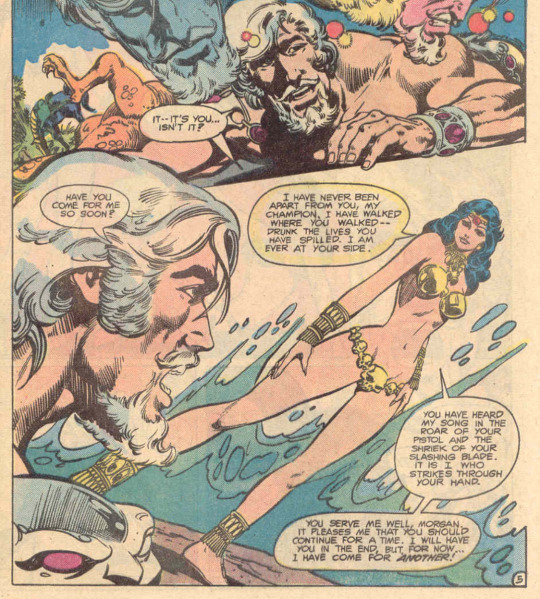
I have never been apart from you, my Champion. I have walked where you walked — drunk the lives you have spilled. I am ever at your side.
Travis then follows Death trying to convince her to return Shakira, into a cavern in hell.
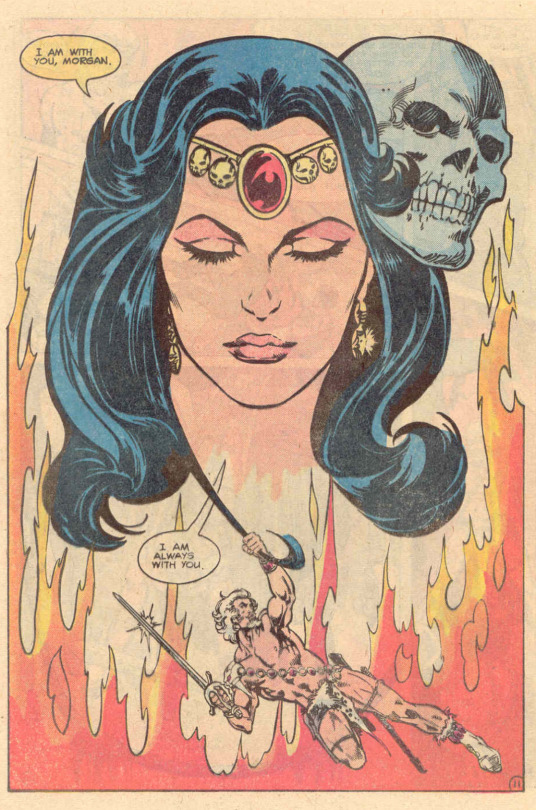
I really like this art for Death?
In any case, Travis negotiates with her to get Shakira back and trades her 10 years of his life.
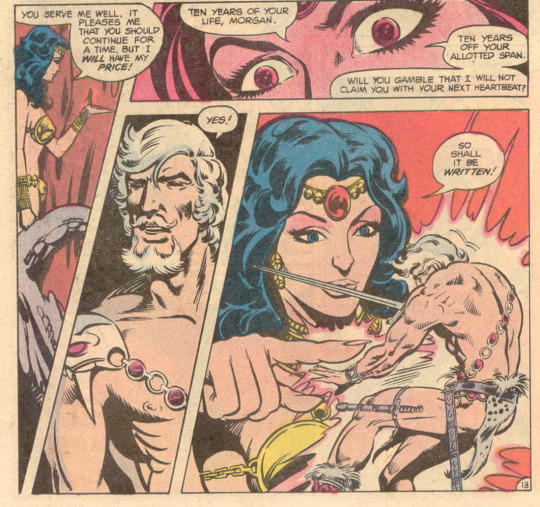
And Travis and Shakira return to Skartaris. Both alive.
Meanwhile Jennifer arrives at the mysterious tower of the ‘master’ of the hunchbacked man who has been leading her.
14 notes
·
View notes
Text
Just read: Superman Secret Origin
Hi! First time doing this, sort of just my review and thoughts on a piece of media I just consumed. Disclaimer: I'm no expert, just a guy who likes comics.
So, last night I ticked Superman: Secret Origin by Geoff Johns and Gary Frank off my 2023 reading list. For years it's been a book that I've wanted to read, I just never had a large enough desire to buy it outright or ask for it for Christmas. After seeing a few panels shared on Twitter I decided since it's so short I might as well finally get through it via DC Universe Infinite and here I am!

Wanted to immediately share that I absolutely ADORED the first three issues. Clark's relationship with his family and his introduction to Metropolis are such great moments that had me grinning the entire time. The book takes a more simplistic approach to Clark's early life drama with his parents by sort of just... not doing it. Aside from learning he's from Krypton, Clark fully embraces the Kents, and the Kents do the very same and it's all so wonderfully written.
I particularly LOVED Clark's relationship with his Father, having grown up in a rural part of the United States myself it's really heartwarming to see how they interact and how much Pa Kent reminds me of people in my family.
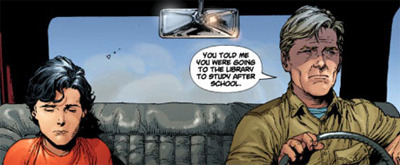
Another great element of the book is the art. Since reading Doomsday Clock back in high school, I've felt that Gary Frank illustrates my ideal version of Clark Kent and he absolutely delivers here. The timid and shy-farmboy-turned-confident-protector is evolved so smoothly through Frank's art and I'd argue that the book is worth checking out for the art alone.

Clark's relationships with the people around him are really great too. This book perfectly, albeit simplistically, introduces us to all of the important players in Clark's life along with his role in theirs. The staff of the Daily Planet makes up such a fun and close-knit cast of workers that perfectly bounces off of Clark.
So yes, as far as the good of the book goes there's a lot to love! The art is incredible and Clark's relationship with the cast around him comes naturally and is written with care the entire way through. For me, this book feels like the perfect modernization of the Christopher Reeve Superman origin. Also, for somebody like me who struggles to stay optimistic, I really appreciate the optimism and hope that a good Superman book can bring to me and this book adequately meets that bar too.
Now, onto the not-so-great stuff. I wouldn't say there are necessarily bad qualities in this book, but there are parts that seem underbaked or lackluster compared to other modern Superman origin stories. I feel like it's important to view a piece of media through the lens of what we received rather than what wasn't there, but with Superman's 80-year-history and the role he plays in the world that he's a part of, there are some missing elements that I really wish were explored here.
For the record, many of these comparisons I'm making come from my appreciation for Superman: Birthright, which is another book that I really enjoy.

An element of the story that I don't necessarily love is Lex Luthor. In this story Lex is absolutely rotten from day 1 with no humanity or real redeeming qualities, he's sort of a jerk the entire way through. That's fine of course if we're referring to adult Lex, but since a decent amount of the early chapters covered Lex's origin I really wish we got some more humanity like we did in Birthright.
Is Lex Luthor being a tragic villain necessary to Clark Kent's development? Not really, but that layer adds so much to their relationship.
Another issue is an apparent lack of Clark interacting with the world outside of the United States. What I feel is a great part of Superman is the fact that he's committed to the protection of the world entirely, not just the United States. Birthright and even Man of Steel extensively showed us Clark traveling the world and learning more about life in general. Superman should be just as capable of saving somebody in the middle east as he is of saving somebody in Metropolis. This isn't to say that Clark's good morals can't be founded exclusively in his upbringing in Smallville, but there's a great deal of appreciation when you think about how Superman actively learned about everybody in the entire world and how he could best suit their needs.
Along with that, I honestly sort of missed Clark's relationship with Krypton in this book. This is a weird sentiment coming from me, in Birthright, Man of Steel, and All-Star I honestly lose a little bit of interest when there is a lot of time committed to Krypton, I personally have just never been super in tune with that part of his lore. All this to say that the bare minimum that this book does to establish that Clark is Kryptonian honestly left me wishing for more. And though the idea of Superman being an alien is explored in this story, I would have liked to have seen him be more in touch with his heritage.
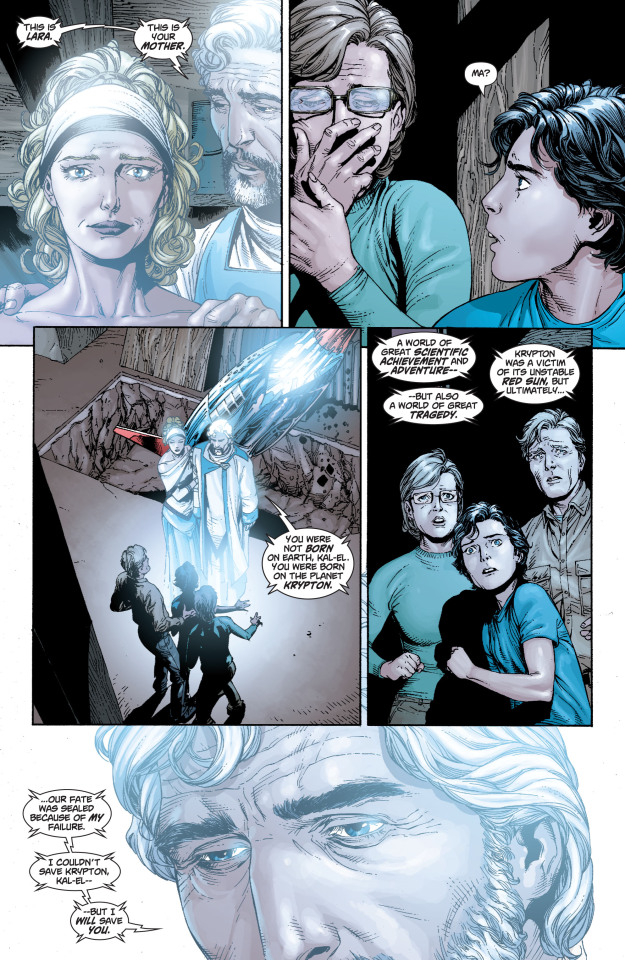
To conclude, this is a book that I absolutely enjoyed, I especially loved the earlier chapters. That said, I believe it has shortcomings in the way that it doesn't give other elements of Clark's life proper depth and attention. If I were to teach a non-comic reader Superman's origin story I'd probably refer them to this, it's a simplistic but heartfelt take on the Man of Steel's origin story. Though, I feel like if somebody was interested in the more nuanced ideas that Superman represents I'd definitely suggest Birthright or even All-Star as a starting read for the character.
Arbitrary grading scale: 7/10
#superman#kal el#clark kent#lois lane#metropolis#dc comics#comics#comic books#comic art#geoff johns#gary frank#lois and clark#jimmy olsen#perry white#superman secret origin#smallville#lex luthor
4 notes
·
View notes
Text




All Star Superman (Grant Morrison & Frank Quitely)
Issues #1-12
Read February 2024
Story: 6.5/10
So I may have made a mistake. This is my first Grant Morrison comic book and it shows. Maybe one day I will return as I explore his work more and have a new perspective and appreciation, but as of today, I don’t get it. This is not to stay I don’t understand the story, because I feel like I grasped the themes and characters and plot, but I don’t get Grant. This story has a pretty cool plot, Superman approaching his death but has to accomplish feats, that sounds awesome. However so much of the series is spent wandering and meandering, some stories last multiple issues while others are wrapped before the end of the issue and needed more time. The book has shining moments, the alternate supermen from the future especially the one with the bandages or the finale. Lex Luthor was done to perfection and is easily one of the best versions. With this said those moments are so few and far between and they are scattered among oceans of nonsense pseudoscience text bubbles that make me crazy.
Art: 4.5/10
Respectfully, I hate this art. I think it’s scratchy, unclear and lucid. Which you can argue fits grants writing but not in a good way. I don’t think any panel or page really stood out to me as a highlight. Towards the end I found some cool art but it was mostly related to the situation Superman was in and less in the execution of the art. I never believed in his Superman and I never enjoyed his Clark. The character designs were cartoony and childish at points. The backgrounds and detail were simplified and flat. I know people enjoy his art and more power to them it just didn’t less than nothing for me.
Special Notes:
- I hated Jimmy Olsen in this
- Who the hell is the rainbow suit guy, and not to mention so many weird golden age type characters. I’m no expert but Grant didn’t even attempt to catch the audience up
- The issue with the face wrapped Superman is by far the best issue and one of the best in Superman history
Overall Rating: 6/10
I can appreciate the gravity of this work. I know how important it is to so many people and how monumental for the time period it was. And there is a chance that down the road in my life I find this work again and I appreciate it more, only time will tell.
1 note
·
View note
Text
Excerpt from "East of Eden" for Kon-El Week
I'm not nearly ready to publish, this thing is like 130k and not finished, and I intend to do some real big kid editing when the rough draft is done, BUT it is Kon-El Week so I figure that's occasion enough to show a 2k work snippet. The fic is basically Lex raising Conner Luthor. In this clip, Conner, 15, has very recently found out that half is DNA is Superman's. The story will be Clark/Lex, and have a major Conner-becomes-Superboy plot arc.
Also, the reference to "Geoffrey, the Federal Judge's son" is my small nod/Easter Egg to one of my fanfiction heroes, @rageprufrock, whose blood, sweat, and tears (and years) produced my favorite Conner Luthor of all time in the beautiful, epic, "Conflicts of Interest" series. Thank you for your Conner, and I hope my clone boy has half the light and life of yours.
*************************************************************
Excerpt:

Good Morning, Metropolis
Conner cracks his eyes open, early dawn light spilling over his bed covers, the same room he’d woken up in almost everyday since he can remember.
They’d had to stay at the hotel for two days while Rico and his crew cleaned up and repaired the penthouse, and they were still working, because not only had Conner destroyed the penthouse windows, but every window and piece of glassware on the top three floors of LexCorp Tower. They didn’t have an explanation for Rico but he never asked questions because Lex kept him busy with all of the Superman-related damage in the 30% of Luthor-owned Metropolis.
Conner has long-ago accepted that he lived kind of a freakish life, even compared to his Excelsior classmates: Kit’s maternal grandfather founded a hair-care empire worth $800 million dollars; Peyton’s father owned some retail conglomerate worth close to a billion; Taylor’s father was Jeff Bezos’ cousin, and so was proximately wealthy; oh, and there was Geoffrey, the Federal Judge’s son, who was the “poor one” with an estate value totaling just under ten million.
Last week Kit had waved the glossy cover of Forbes in Conner’s face, asking him whether he “whacked off into a pile of money every night before bed, or into his solid gold toilet?”
Kit had never been inside of a grocery store, either, so Conner told him he could fuck off, and also the secretly-planned joyride to Gotham in the Porsche was now permanently cancelled.
That had been last week, but it felt like years ago, now. Because that bickering conversation was before Conner had found out he had no mother; before he found out his father had lied to him his entire life; before he found out that half his DNA came from fucking Superman-- which Dad had said he couldn’t ever, ever tell anybody about, no matter how cool it was.
Cool, and brain-numbing, and sort of sad, because Conner didn’t have a mother.
Conner didn’t have a mother-- was the only single human (half-human) on the planet who didn’t have a mother-- everybody had a mother! Even Superman had a mother!! And so, in a way, Conner was even more freakish than Superman-- an alien! From outer space!
It was funny, because it’s not like he’d had one before. His father had always answered Conner’s questions about his mother with evasive half-answers, “you don’t need to know her name”, she was a IVF donor, a surrogate, she “wasn’t a mother in any real sense.” But Conner had always assumed that he had, you know, an X-chromosome from a human female-- that genetically he was at least in lockstep with his peers.
Once when he was ten, in a bid to flush out more information, Conner had asked his father “What if my mother gave me some freakish hereditary disease?! What if I have Huntington’s or something?! What if I’m a paranoid schizophrenic?! WHAT IF I HAVE HEMOPHILIA?!”
His father had calmly reassured Conner that LexCorp doctors had conducted a full panel of genetic tests on him as a baby, and that he “couldn’t be healthier than if he was engineered.”
He can almost appreciate just how spectacular an example of “lie by omission” it really was.
Conner stretches his toes, glancing over at his bed stand, and the file laying on top of his phone. The file with old printouts dating back to 2002, before Conner was born. Not even born, but... “attained successful fertilization?” Ugh. There were charts and lab notes, detailing every step of Conner’s conception, dates with concise little observations like “embryo viable” and “rate of cellular mitosis normal”. In the file, they didn’t even call him by his name. He had a designation-- “CNR-15”. A namesake so depressingly desolate that Conner hadn’t gotten out of bed for half a day.
And it was sort of a bummer, too. Superman at least had cool powers, like super-speed and super-strength, and laser vision, and he could fly! So far the only thing Conner could do was cry hard enough to break windows. It was just his luck that the half of DNA he got from his super Dad was the lame half.
He grabs for his phone and clicks it open, pulling up the selfie photo from Saturday night. He stares at it, zooming in and out with a pinch of his fingers. He didn’t even look real-- he looked big and bright and made up-- the deep blue spandex, the S-shield shining and proud over his chest like one of King Arthur’s knights, the red cape falling regally from his broad shoulders.
“Clark,” he whispers, feeling the shape of the name in his mouth, bookended by the harsh ‘K’ sounds and the last voiceless, coronal stop of the T. “Clark..Kent. Clarkent. Clark Kent is Superman. Superman is...” my Dad, he finishes wordlessly. He finds it hard to say out loud.
Conner reaches out a finger, touches Superman’s big smiling face, noticing the sharp, slightly crooked incisors, which Conner had had before the braces in middle school. They had similar noses, too, he thinks. And the hair of course.
People had always said, you must look like your mother. Besides the eyes there wasn’t much there, which used to make him sad. He’d wanted to look like a Luthor, not the nameless egg donor who hadn’t even bothered to leave a name, much less a birthday card or an explanation.
Of course. None of that was relevant anymore.
The truth is mapped out in front of him, right here on his phone, and it’s spelled out in the file with charts of sequenced DNA, labeled neatly with abbreviations Conner doesn’t understand. There are photographs of what his father had called his maturation chamber, progress shots of a little floating tadpole Conner, then a peanut-sized blob, then fingers and toes, then something resembling an actual human--
Half-human.
Conner’s thoughts are cut off by three efficient raps at his door.
“I’m UP--”
Mercy pokes her head in the door, probably making sure he was decent.
“That doesn’t look like ‘UP’ to me.” She pushes into the room. “Let’s go, your Dad’s almost off his conference call--”
Uh oh. She’s got that gleam in her eyes.
“Mercy- DON’T, I’m getting up-- HEY!”
The bottom covers and sheet yank cruelly up and off, and the soft little cave of warm air is rudely invaded. Conner scrambles up, regrouping to tuck the comforter back under his feet.
“You know one day you’re going to do that when I’m naked under here and traumatize us both,” Conner grumbles, throwing his phone on the stand. He swings his legs around but waits to flip the covers back from his lap.
“Do you mind--”
Mercy snorts but turns, squaring her shoulders. “Nothing I haven’t seen before.”
Right. Not weird at all.
“Actually--” he calls from the walk-in closet, pulling a school uniform from its hanger. “About that-- if I was born in a lab, then you didn’t really change my diapers, did you?”
He pulls the slacks up, and peeks his head out to glare at the dark-haired bodyguard.
“I met you when you were three, and you were still shitting your pants.”
“Oh bullshit--”
He and Mercy have this thing about cursing in front of each other. His Dad used to make him put $20 in the swear jar because cursing was both ‘unattractive and a sign of the unintelligent.’ But Mercy always laughed when he said ‘fuck’ so he’d made a point to say it as much as possible from the time he was little and she’d caught on.
The buttons on his shirt go all crooked, and he has to start again.
“So-- you remember the lab?”
He hears her fingers still from whatever she was messing with on his desk. “I do.”
He finished with the buttons and steps out of the closet in socked feet, pulling the tie across his shoulders.
“Well what was it like?”
She turns, putting down the Batman action figure. “It was a lab. It was very clean.”
“Well that’s... illuminating.” He grumbles, and pulls the ends of the tie even. Fat end over skinny end-- “I’d like to go see it soon.”
She shook her head. “The lab was destroyed a few months after we took you home.”
Balls. The tie got twisted around somehow.
“What happened?” he yanks the knot loose.
“Your father burned it down.”
“He torched his own lab?!”
Mercy purses her lips in kind of a wry smile. “No. Your other father.”
“SUPERMAN burned down my lab?” he drops the ends of his tie. “Was he trying to kill me?!”
Mercy laughs, and slaps his dumb hands away from the tie. “Here, give it up.”
“Thanks,” he grimaces. “Why’d he burn it down? Did he use his laser eyes?!”
“He wasn’t trying to kill you,” she slips one end under the other. “Chin up-- he knew you were with us already. I think he was worried Lex was trying to replicate the process. And yes--” she smiles. “From the looks of it, he used his ‘laser eyes’.”
Mercy tugged the knot into place, tucking his collar down, smoothing the edges.
“It’s just--” there’s a strange tightness under his ribs. “It’s weird he didn’t come say hello. Right? Even if they had some kind of agreement, or whatever.”
Mercy’s eyes get all soft, the way only Conner can manage to make them.
He sniffs, tugging at his shirt cuffs. “I think I lost my cufflinks.”
She finds them immediately, underneath the copy of Infinite Jest split open and bookmarked by the flat glass surface of his desk.
“They were trying to protect you,” she grabs his wrist, matching the ends of the first little purple and gold piece. “Both of them.”
“Seems like an excuse.” He switches arms.
“Well he’s got his little red panties in a twist about you now.” She slips the other piece into place.
“Mercy, that’s weird--” he turns. “Where are my shoes?”
“Under your bed. What do you want for breakfast?”
“Hmm...” he sits on the bed, fishing out the shiny black oxfords. “Can I have French toast?!”
“An undignified choice,” she grimaces, but pulls out her phone to ring the kitchen staff in the LexCorp restaurant one floor down.
“And delicious!” he flips the second shoe from hand to hand like Mr. Rogers, which he used to watch on TV with Mercy in the long, golden afternoons in the living room before Dad came home from work. Sometimes she’d let him switch it to the five o’clock news, which always ended with a segment called ‘Today with Superman’ about the day’s exploits-- and sometimes the pretty news anchor Melissa Brunner would have caught a quick interview with Superman himself and asked him cool stuff like what his favorite food was (Mom’s meatloaf with ketchup) or his favorite color (anything but green) or if he was a dog or a cat person (definitely dogs).
Mercy plucks his school blazer from the back of his chair and holds it up so Conner could slip his arms through.
He turns and she tugs it into place, briefly rubbing her thumb across a pin bearing the Luthor family crest. “All ready?”
Conner ducks his chin, holding the fabric out to see. “Maybe I should get one of those Superman pins, huh?”
“It’s your funeral.” She rolls her eyes, and holds open the door, sighing impatiently while he spruces his hair into place with a little gel.
“God, you’re worse than Kit.”
Kit. With the hair-care empire. Hardy HAR-HAR.
“Don’t be such a bit--”
She gets him into a headlock long enough to mess up his hair and elicit an undignified squeal, dragging him out of the room and down the hallway, his fingers still tacky from the gel.
“Goddammit--” he tries combing his hair back down. It really threw his “artfully messy” look off equilibrium and into the “slob” end of the spectrum.
As soon as they hit the hallway her face shifts back into “professional Mercy” mode, as it always was around his father.
His father, who was waiting for them in the kitchen, a phone pressed up against his ear. He looked up, waving them forward with one hand.
“Conner,” he pulled the phone back, chin tipped up. “Sit down, we need to talk.”
#Kon-El Week#Conner Kent Week#Superboy Week#Conner Luthor#Clex#fanfiction#WIP#superman#lex luthor#Mercy Graves#east of eden fic
55 notes
·
View notes
Text
On Supergirl
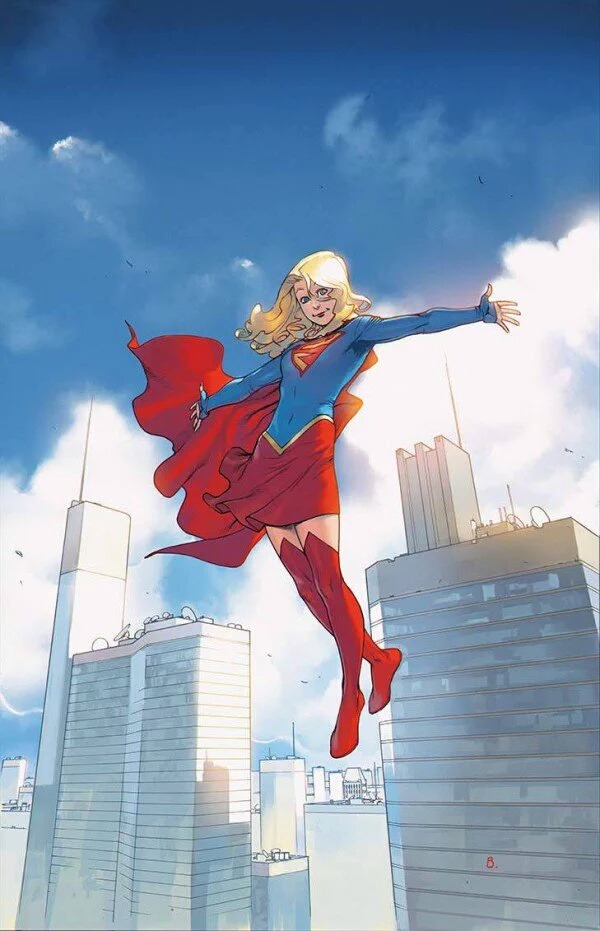
Figured I should put up my thoughts about Kara in the wake of her first film appearance being announced, and the final season of her TV show fast approaching. Short version is: Kara is very cool and DC needs to stop messing with her.
My Introduction to Kara
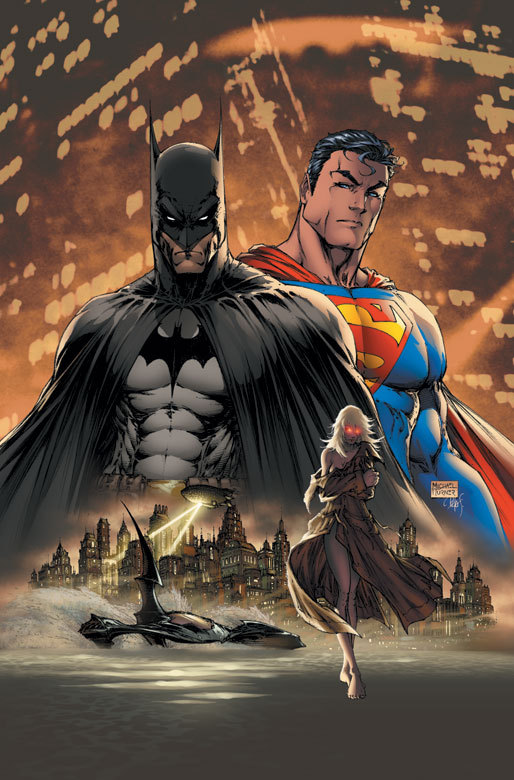
I was introduced to Kara the way most millennials/Gen Zers were I imagine, via the Loeb Superman/Batman arc which brought the traditional Kara Zor-El Supergirl take into Post-Crisis continuity, after years of DC attempting to have a “Supergirl” without violating the editorial mandate that Kal needed to be the literal “Last Son of Krypton” (an example of one of the dumb ways DC fucked Kara over). Story goes that one day Dan Didio was in line at the Superman ride at Six Flags (I love that ride even though it’s stolen my glasses every time I’ve ridden it, even when I left them in a locker!). The ride had signs that talked about various Superman characters. Didio was reading the entry for Supergirl where it talked about her not being Clark’s cousin but instead some weird merge of alien shapeshifter, angel, and human girl, and he realized how fucking stupid that was, and he went back to the office and told Loeb to bring Kara back.
Years later I would also be standing in line at the Six Flags Superman ride (probably at a different park location but who knows?) as a youngster and would read the new Supergirl sign that trumpeted that Superman had a cousin who shared all his powers, an update reflecting the new Loeb origin. I thought she sounded pretty cool, made a note to see if my library had any Supergirl stories next time I visited, then got on the Superman ride and promptly lost my glasses like an idiot because I wanted to take them off while I was riding and pretend I was changing from my “disguise” into Superman mid flight. My dad grounded me for this afterwards, but it gave me a funny story to tell at family get togethers and isn’t that what Six Flags is all about?
A month later (and with spiffy new glasses), my mom dropped me off at a new library next to where she worked, and they had one of the best Superman collections I’ve ever seen to this day. I was in heaven and while reading every Superman book I could find (I couldn’t check them out because I didn’t have a card, my mom’s card didn’t cover the area the library was in, and my mom wouldn’t have checked them out anyway since comics were “too violent”), I found the trade collecting Kara’s new origin. I read it and I thought both she and Superman were really cool, and Batman was a punk who had to beat Darkseid by cheating, the loser. Turner’s art to my young eyes was the best I had ever seen, and the panels got engraved into my brain.
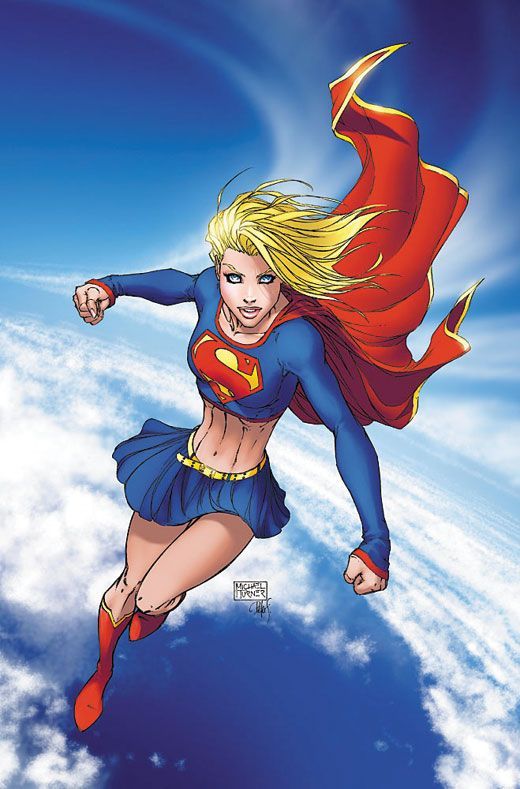
I still get downright nostalgic whenever I see Turner Superman or Supergirl stuff. I also got my parents to rent the animated movie adaption of the Superman/Batman arc from Blockbuster (remember those?), and that sealed the deal. Seeing Kara hold her own against Darkseid convinced me she was as cool as her cousin. Next time my mom dropped me off at the library next to her workplace, I went looking for Supergirl stuff to read. I found the first volume of her new volume by Joe Kelly taking place after the Loeb arc and dove in.
It was... weird. 5 years later I might have enjoyed it but at the time I was majorly put off. Kara took a secret identity for a day and then ditched it because it was “stupid” and the kids bullied her. She was always getting into fights with Kal, and there was this weird plot that I couldn’t follow about how her dad had sent her to kill Kal, maybe or maybe not? Also she could grow crystals which I thought was dumb, and said she was stronger than her cousin which I couldn’t buy for a second given he looked like he was carved out of marble, and she looked like she relied on sunlight instead of food. I put the volume back on the shelf and kinda gave up on reading the character after that for a while.
I followed her via the DC wiki updates just like I did Superman, and everything I read seemed dumb and convoluted. She was split in two, moped around a lot, made out with an alternate version of her cousin, and basically just flopped about the same way the rest of the Superfamily did during the 00s. Nothing made me think I had made a mistake dropping Kara until I read the latest update to her wiki page.
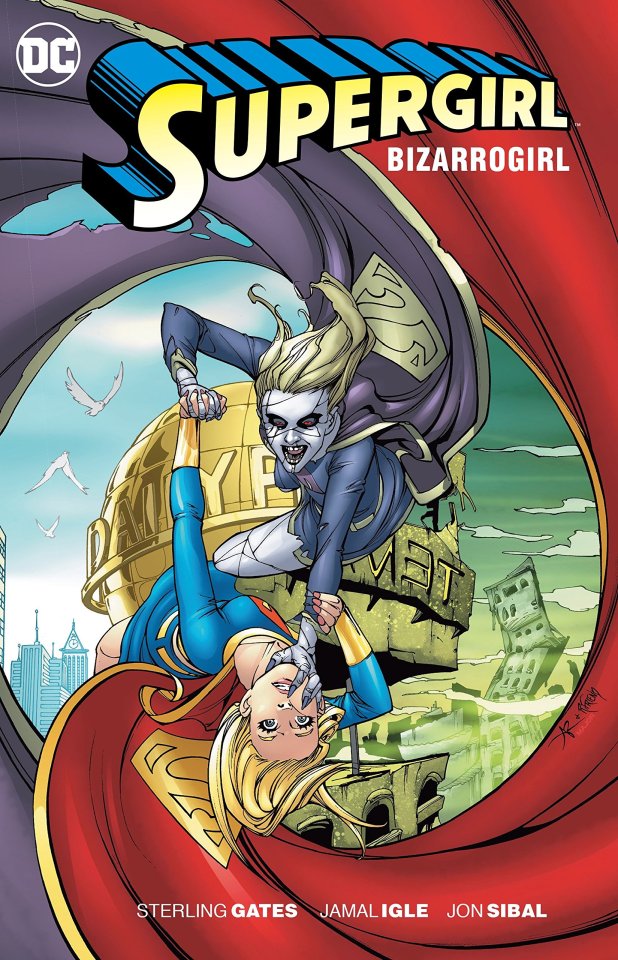
I was super into what I was reading about the Busiek/Johns era of Superman online. Lex was back and making a big revenge scheme that involved all the other Rogues! Old Superman Rogues were getting revamped and made cool again! Johns reintroduced Brainiac and made him a big threat, with Kal and Kara teaming up to fight him! Busiek was revamping Prankster and telling big ambitious Superman stories! For the first time in a long while, the consensus on the Internet was that Superman was good again. My “home” library had zero Marvel books and no Superman or Batman books, all their DC stuff was Flash or Green Lantern, mainly written by Johns. Insane to think back on now. My hopes that because Johns was involved with Superman, Superman books would show up at my library were fulfilled. They started bringing in Busiek and Johns collections, and someone there also ordered Sterling Gates’ first volume of Supergirl, and I checked everything out since I was old enough to have my own library card, and my parents were worried more about the violent video games I was playing rather than comics.
I read everything and loved it. I also really liked Gates’ take on Kara. She was still an imperfect teenager but she wasn’t insufferably angsty or constantly fighting with Kal. She was going to give the secret identity another try and Lana had “adopted” her. It’s funny remembering how I enjoyed all that given my current thoughts on how Kara should work, but it was great at the time. I liked Gates introducing new foes for Kara, some classic Superman Rogues adapted for her like Bizzarogirl, others crafted specifically for her like Reactron. Gates’ basically rekindled my enjoyment of Kara the same way Busiek & Johns rekindled my enjoyment of Superman.
Of course it ended terribly like everything Superman-related seems to.
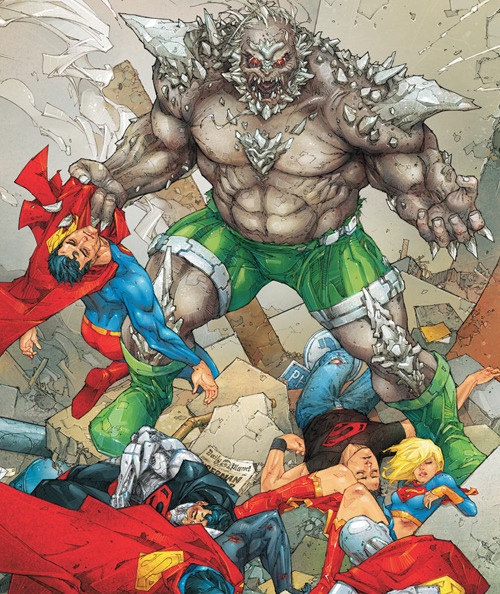
I’ve got a whole post I want to do about New Krypton and what came after. In short that is the most blatant example of “hitting the reset button” that I’ve ever seen. All the potential got wasted, and afterwards everything except Lex’s Action Comics stuff just didn’t appeal to me. Gates got booted off Kara for Nick Spencer who ended up leaving himself later, a promising Teen Titans line-up with Kara on it didn’t happen, and the last proper Pre-Flashpoint Superfamily story was a crappy team-up with Doomsday against Bigger Doomsday (thank God for Cornell’s final Luthor/Superman confrontation at least). When news of the reboot arrived, I was honestly happy. The Superline needed an enema.
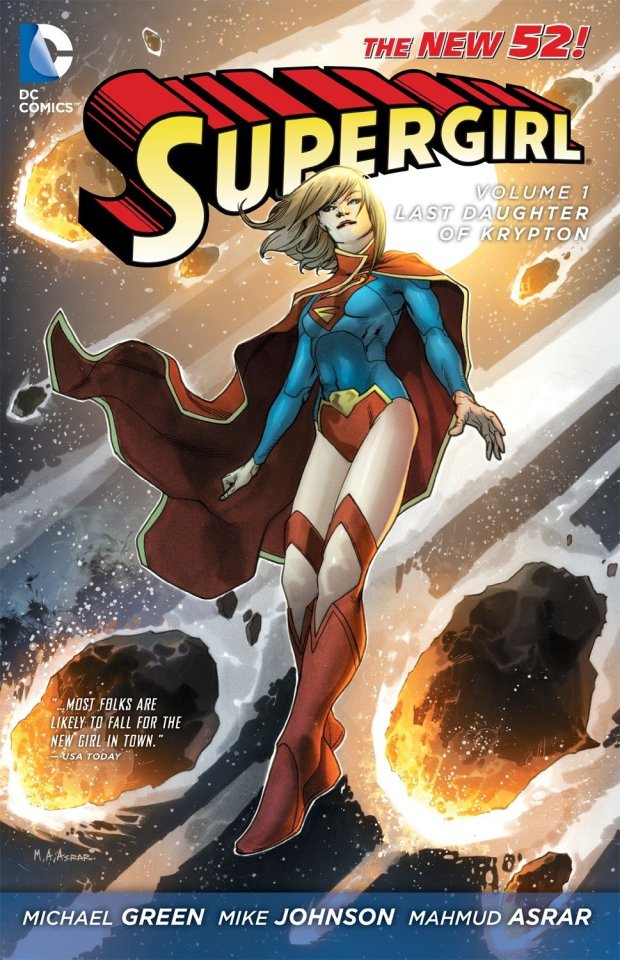
Controversial opinion time: I liked New 52 Supergirl. It’s weird because a lot of the stuff I hated about Kelly’s run was here, and a lot of the stuff I loved about the Gates’ run was not. This was angry, moody, emotional Kara again, fighting with Kal and not fond of Earth. But I was in my teens at this point, and I didn’t want happy go-lucky Superman or Supergirl. I wanted my heroes angry, scared of the future, ready to go out there and smash some cars. Morrison’s Action Comics was 100% my jam (still is once I really understood the deeper meaning beneath the work) and this Kara felt like a natural fit for this universe. Plus we got Asrar on art and that guy made it damn pretty to look at, lots of cool science fiction stuff going on, even with the dumb H’el storyline.

I loved all the new Rogues Kara got. I loved her new Fortress under the ocean. I loved how traumatized she was by the loss of Krypton, that she wanted more than anything to go home, that her cousin was like a stranger to her since they had been apart for so long. I found all of that incredibly relatable. A lot of the New 52 Supergirl stories might have been schlock but it was my type of schlock damnit, and I enjoyed it!

I kept with her New 52 series all the way through the Red Daughter Saga (which I loved). As someone who grew up on Johns GL (since that was the only comics my home library had), seeing a Supercharacter join a Lantern Corp was the hypest thing ever. I loved the finale about Kara finally letting go of her anger and losing the ring while smashing her foe into the sun, it was incredibly cathartic for me as an angry teen myself. I finally stopped following her series sometime after since I was no longer enjoying the Superline or really DC as a whole. It wasn’t until I heard that New 52 Superman died and the “old” Superman was back, that I checked back into DC.
DC Rebirth & How I Think Kara Should Work
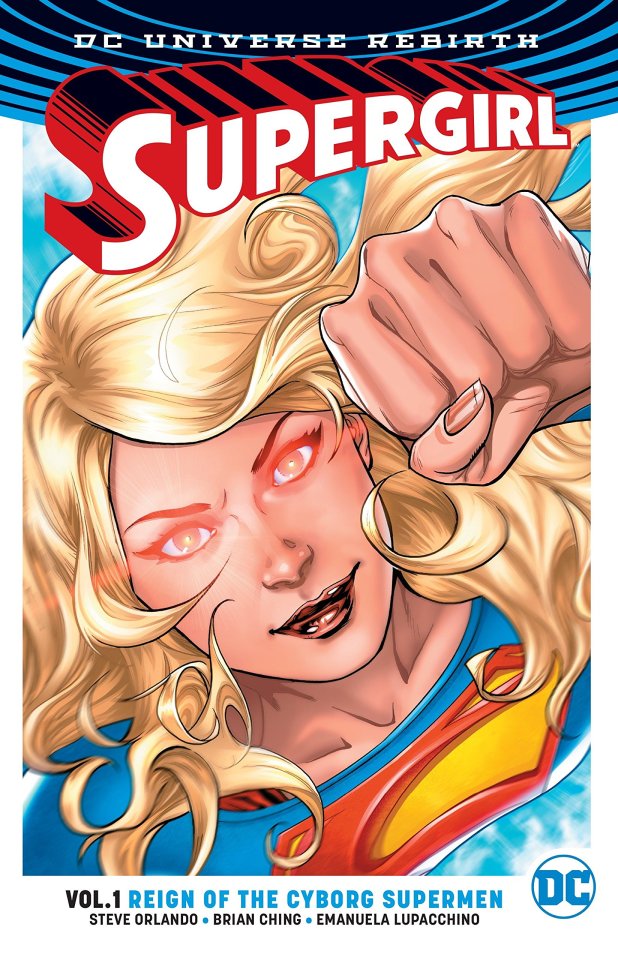
I did not enjoy Supergirl Rebirth, and I think I’ll talk about my problems with it alongside how I think Kara as a character should work since the two are related. A pet peeve of mine that has formed over the years is this: I don’t like it when Superfamily members get turned into Clark clones. Kon wearing glasses and going to Smallville High. Kara going to high school and being involved in journalism. Jon more or less being written as a copy of his dad personality-wise. I hate that kind of stuff because it’s boring. What’s the point of a Superfamily if everyone is just copying Clark? It also doesn’t fit the characters especially in Kara’s case. Why the hell does she want to be a journalist? Were there journalists on Krypton? I don’t remember ever seeing one! Shouldn’t she want to be, I dunno, a scientist? That seems to have been the El family tradition, wouldn’t she have been groomed for that?
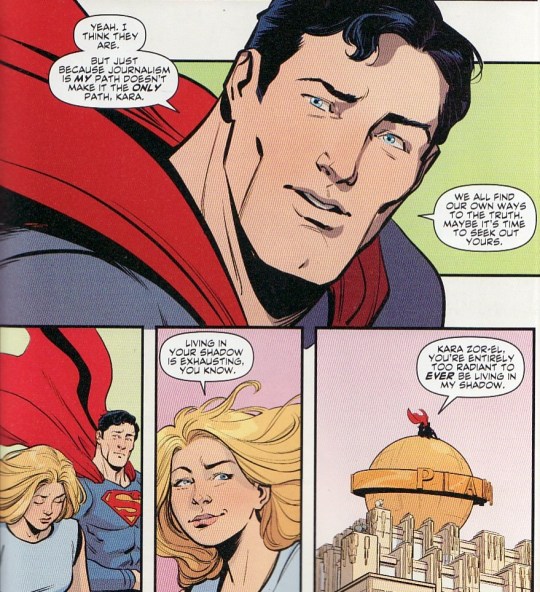
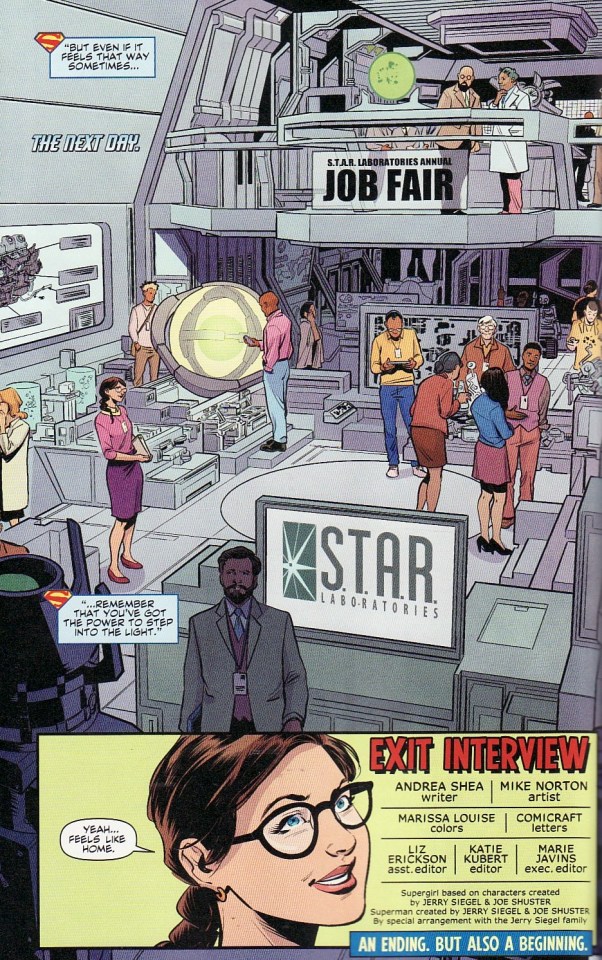
This one-off by Shea is honestly the only acceptable outcome for Kara going into journalism for me. She realizes she’s just copying her cousin and switches to something she wants to do. So Orlando copying the show, which already basically turned Kara into an expy of her cousin, just did not appeal to me at all. What had worked for me under Gates way back when was not clicking for me this time. I wanted to see Kara embody the principles of the S-shield in a different way than her cousin did. So I really enjoyed when Rebirth ended and we moved into the Bendis era with Andrekyo relaunching the title as Kara in space.
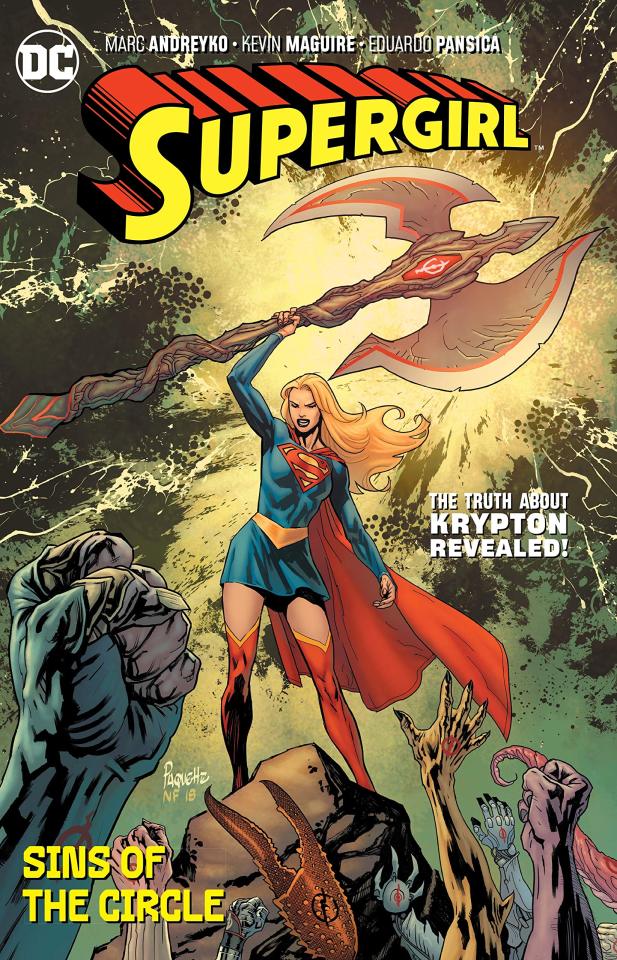
Kara in space has always felt like a good fit for me. Unlike Kal I’ve come to believe that Kara really shouldn’t be all that fond of Earth. For him it’s home, but for her it’s just where she ended up after her real home got destroyed. I think Kara works well as a sort of nomad, occasionally making stops back home to Earth to check on her cousin, but otherwise? She’s more comfortable out in space than she could ever be on Earth. Out in space she can be Kryptonian (which is what she should think of herself as in contrast to Clark being torn between his Kryptonian biology and human upbringing, and Jon/Kon identifying as human), be her true self, not have to pretend to be human to fit in. Kara founding a moon refuge was one of the best ideas for her that I’ve seen, I would love if DC made her Future State refugee center on the moon canon. I’m excited for more Kara adventures in space with the upcoming Tom King story.
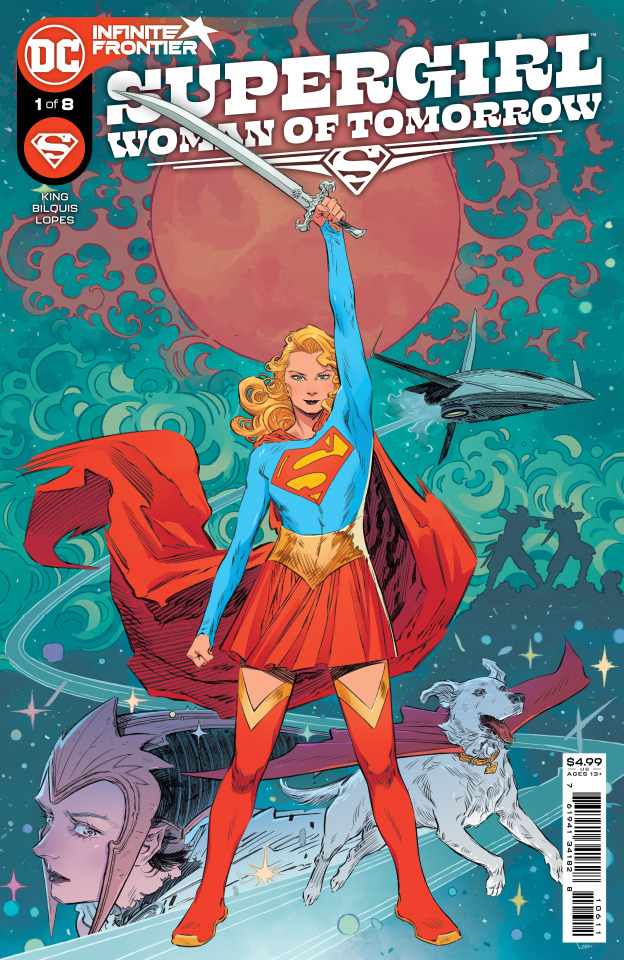
Also love that her and Krypto are getting tied together, if they don’t want to use Krypto in Superman’s stuff, let her have him! Bring on cosmic adventurer Supergirl!
Personality & Other Traits
Kara to me should be more hot-tempered than her cousin. All the Superfamily members should have a temper in my opinion, I see that as the “Deadly Sin” of Superman and his family. But while Kal is like a simmering pot that will explode if it’s left cooking for too long, Kara is like dynamite. Light her fuse at your own peril because she will go off on you.
I also like the idea of Kara being rash. Kal’s got a maturity that came from over a decade of having to live with Lex Luthor constantly getting away with all his evil schemes. He’s patient because he’s been forced to be. Kara? If you ask for her help she’ll give it, but beware because she doesn’t really care about the long term impacts of her decisions. She’s an invulnerable teenager after all.
Really liked that Venditti Annual where Kara got tutored in history by a reincarnation of Hawkman. Kara having a passion for history is a neat trait, would be nice to see her teach Kal or Jon some Kryptonian lore, or have her lead a Kryptonian holiday celebration for the Superfamily because she’s the only one who remembers how to do it.
Sexuality wise I know a lot of people ship Kara and Lena on account of the chemistry between the two in the show. I haven’t watched the show myself but I’m fine with making Kara bisexual, the Superfamily could use some LGBT+ rep, and Lena hasn’t done anything of worth as a villain, so undo that and throw the two together. If we’re letting Harley and Ivy get away with murder I think we can let Lena off the hook too, undo the Ultrawoman weirdness and put the two together. Could be fun seeing the two building that moon refuge together.
All in all I think Kara is a great character who is a stronger embodiment of the immigrant experience than even her cousin in some ways. I hope King does a good job with her, she’s treated better than her cousin on the film side, and that overall the 20s are a better decade for Supergirl than the 10s were.
43 notes
·
View notes
Text
Is It Really THAT Bad?
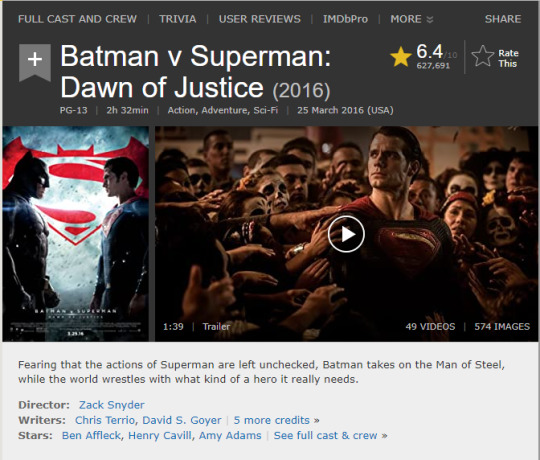
How many fucking times must I talk about this movie?
I feel like this movie doesn’t need an introduction. Everyone knows this film. Its reputation precedes it. It didn’t bomb and it’s not generally considered one of the worst films ever made (at least on the level of films like Robot Monster or The Cat in the Hat), but this movie is easily one of the most divisive films ever made. This film has generated enough arguments that, if we harnessed the energy of all the flame wars it has caused, we could probably power the entire world until the heat death of the universe.
With the impending release of Zach Snyder’s bloated redo of Justice League, I’ve decided to go back and ask myself of this film here… is it really that bad?
THE GOOD
Here comes the most uncontroversial opinion: the action scenes in this movie rock (or at least two of them do). The standouts are the titular showdown, which almost makes sitting through the rest of the movie worth it, and the epic warehouse fight Batman gets into, which is like something straight out of the Arkham games. It’s so good. And aside from that, a lot of the cinematography in the film is good. The film knows how to look good, though unfortunately it does end up being a lot of style with little substance.
youtube
On the subject of Batman, I think Ben Affleck is a great and inspired choice. I certainly think he’s worthy of standing alongside Batmans like Clooney and Keaton, easily embodying both the Dark Knight and Billionaire Playboy aspects fairly well, though the writing does not always handle him quite as well as it should (we’ll get to that soon enough). Henry Cavill, while still a rather dour Superman, is as good as ever as Superman, and Gal Gadot as Wonder Woman was a great choice here, especially since she didn’t have control so that she could insert anti-Arab racism, like some DCEU movies.
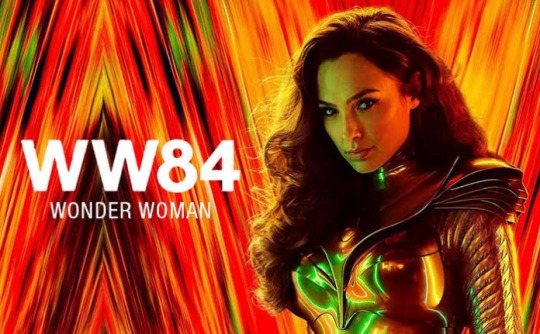
Perhaps one of the movies most impressive feats is how, in an uncharacteristic moment of brevity, it manages to condense the backstory of Batman into the prologue, getting it out of the way and not making us sit through yet another Batman origin film. This is literally the only thing the movie has over the MCU; where that franchise just has the character Spider-Man inexplicably in existence without even a hint of his origins, they just get Batman’s tragic backstory out of the way so we can see him beating the crap out of people. If more superhero movies want to take this route and just condense the backstory into an opening montage like this, I’d be down for it.
THE BAD
I really could just say “most of the movie” but that’s such a cop out. Let’s actually look at the problems. Let’s work our way up through the things from least problematic to most, shall we?
The best place to start is what Zach Snyder did to Jimmy Olsen.
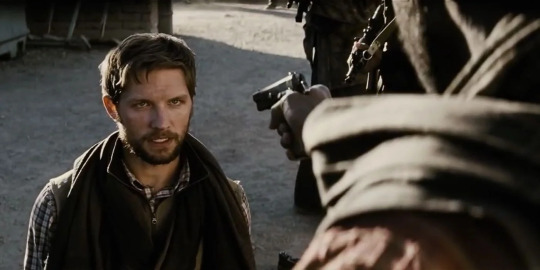
Jimmy Olsen is made into a CIA spook who is brutally killed early on, and yes, that was Jimmy Olsen. Snyder put him in to shock audiences with his senseless murder, and also because he felt the character had no place in his series. Does making Watchmen just turn people into joyless husks who like to horribly bastardize iconic characters? Jimmy Olsen is ultimately a small microcosm of the film, but he is the sum total of everything wring with the early DCEU. He is bleak, soulless, and shows a critical lack of understanding about the comics and why people enjoy them.
Now let’s move on to the more exciting problem to discuss: the villains. I don’t even think it’s worth wasting much time discussing what’s wrong with KGBeast. While it is kind of interesting they’d think to use the guy at all, the fact he never dons the costume and dies by the end of the film is unfathomably lame for a character named KGBeast.
Now, onto the main antagonist, and the most infamous part of the movie: Lex Luthor.

Lex Luthor is horribly, horribly miscast. Jesse Eisenberg is a great actor for sure, and he’s effective in movies like Now You See Me, The Social Network, and the Zombieland films. But here he is being asked to play one of the most diabolical cunning geniuses in comic book history, and rather than play him as such, he plays him like a cartoonish twit. This Lex is utterly unrecognizable as Superman’s greatest foe. Does anyone think Lex Luthor would send a jar of piss to someone as a joke before he blows them up? That’s more something the Joker would do on an off day. Lex is not cunning, not intimidating, and not diabolical in the slightest, and yet there are moments where Eisenberg’s acting chops shine through and Lex, for a moment, is almost engaging. Luthor really suffers the way Doctor Doom tends to in film adaptations: the filmmaker clearly doesn’t get why people like the villain, and decide to do some weird, unique take that will only cause to alienate fans.
But perhaps the worst of them all is Doomsday. Doomsday has exactly one claim to fame, and that’s killing Superman, so as soon as he shows up if you have even a passing awareness of the character you know how the movie is going to end, which robs the film of tension for its last battle. The fact he also appears with little buildup and doesn’t have any characterization doesn’t help; Doomsday is just the Big Gray CGI Blob that superhero movies try and pass off as a final boss for the heroes to fight. This has worked precisely once, in Iron Man. The Incredible Hulk and Venom did not make it work, and this film is nowhere close to being in the same ballpark as Venom.
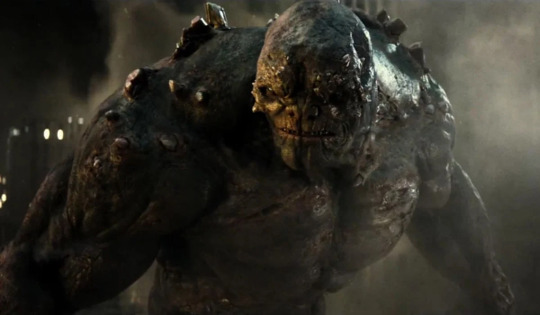
By and far the biggest problem, though, is the movie’s incredible length and its very existence in the franchise at this point in time. This is an epic superhero crossover in which two of the biggest comic book characters of all time fight and then team up… And it is the second movie in a franchise. While they do a good job of establishing Batman rather quickly, Wonder Woman comes out of nowhere. And then at the end, Superman ‘dies.’ We have had one single movie prior to this to make a connection to the guy, and yet here he is getting a temporary comic book death with no buildup whatsoever that we know is going to be reversed sooner than later because the movie telegraphs this to us.
Imagine if, instead of building up the character over the course of a decade and putting him in all sorts of different stories, the MCU went right from Iron Man to Endgame. You go from a simpler, character-driven piece to a massive crossover where a hero dies right away, and it doesn’t give anyone time to care. Tony Stark had multiple films worth of characterization under his belt before they threw him in a crossover, let alone killed him, but Snyder expects you to give a damn about a Superman who just started his career in the previous movie of a franchise.
And the ass-numbing length of the movie is no justification. Even before the director’s cut came out this film was a slog, and the director’s cut really does nothing to earn its existence. All it does is add more runtime to an already tedious and bloated film, leading to the same exact ending and fixing none of the overarching narrative problems of the thing. The problem with any director’s cut is that ultimately the movie is still going to be Dawn of Justice, it’s still going to lead to extremely rushed character decisions, and it’s still going to be a mess. You’d have to redo half of the film to make this into a worthwhile and coherent narrative that’s actually worthy of being an entry in a superhero franchise.
And to top it all off, the movie spends far too much time foreshadowing for its own good. People criticized The Mummy for shoehorning in way too many shared universe elements right off the bat, and if that movie was bad for it, so is this one. The cameos from all the members of the Justice League, while striking, could be excised from the plot with little to no impact, and the Knightmare sequence is just excessive and weird.
youtube
Is It Really THAT Bad?
The answer to this question has never been harder.
On the one hand, this film does have some merit. There is some good casting choices, good cinematography, good action… But then, on the other hand, the film is overly long, pretentious, has poor writing and dialogue, mishandles everyone aside from Superman, and is just incredibly unpleasant.
This film is in many ways the exact problem Christopher Nolan created with his Dark Knight trilogy. Nolan, by grounding the fanciful characters of comic books into a realistic setting, created a climate in which someone could suck any sort of joy or meaning out of comics. The success of his films meant that people would see dark, gritty realism as preferable to joyous, colorful escapism, and the negative effects of his films, however good you find them, are still felt today even as filmmakers are finally shaking off the grit. Dawn of Justice is the zenith of Nolan’s style of superhero film. There is nothing fun, joyful, or engaging to be found here; it is simply the characters you know and love forced into dark, miserable scenarios that ends in death and misery. Where’s the fun? Where’s the color? Where’s the wonder, the excitement, where is any of it? This film paints a bleak and miserable and hopeless picture of a world of superheroes. It really makes me think of this rather famous comic panel:
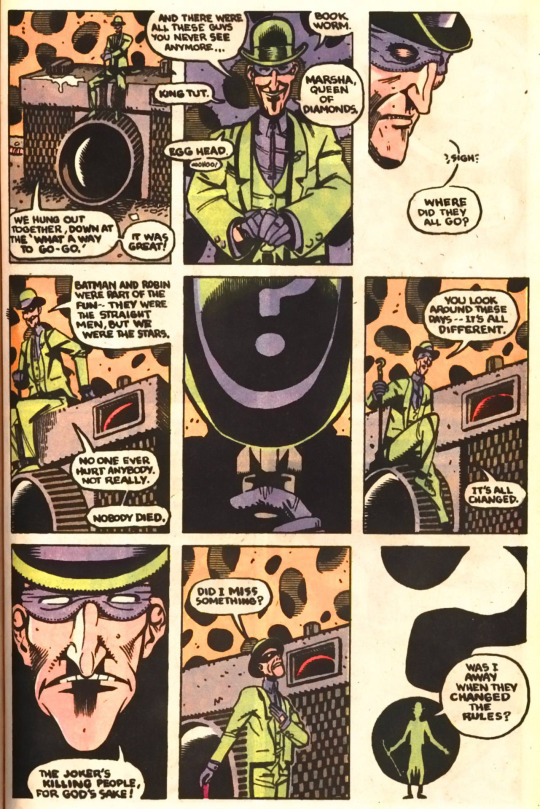
I absolutely hate this movie, but not because I think it’s bad. I hate it because it has enough good ideas where it should be the best thing ever, but it really isn’t. It’s a miserable slog of a film that does nothing to justify or earn its massive runtime whatsoever. It really does belong somewhere between 5 and 6 on IMDB, because I can almost see why people like it, but it just isn’t even remotely close to being how good its fan say it is. This is not a good superhero movie, and this is not how we should want superhero movies to be. There is a market for serious superhero fare of course, and there’s no reason that these films can’t engage with mature themes or anything, don’t get me wrong. But this is absolutely not the way to do it.
#Is it really that bad#IIRTB#Review#movie review#Batman v Superman#Dawn of Justice#Zach Snyder#Batman#Superman#DCEU
26 notes
·
View notes
Text
Consider this my magnum opus of why I love Booster Gold and why you should read these comics, but also: how Michael Carter and his family are connected to time travel. It’s kind of a hot mess because I run through a bunch of comics, but hopefully this makes sense!
Michael Carter, alias Booster Gold, is the first new hero introduced after Crisis on Infinite Earths. Booster is from the 25th century, where he was a college football player who got caught betting on his games and expelled, eventually becoming a janitor in a museum.

(Booster Gold (2007) #1)
At this museum, he befriends a security robot called Skeets. Eventually, Booster decides that he wants the adoration superheroes had in the 20th/21st century, and with future technology, he would be able to join up in the past. So Booster steals a Time Sphere, a suit, and a Legion of Superheroes flight ring. (Wait, the legion is from the 30th century, right? Yes. There are reasons this ring is in the past, and that’s mostly because Booster was always meant to become a superhero.) In the past, Booster establishes himself as a superhero, with a manager and number of sponsors. He’s about making money. This doesn’t necessarily make him a lot of friends. But he joins the Justice League International, makes friends with some heroes (including Ted Kord, the second Blue Beetle), and has a standard fare for a non-central character.
So flash forward to Countdown to Infinite Crisis. For those of you who haven’t read this one: This is a lead-in to the OMAC Project, and later, to Infinite Crisis, where Ted Kord notices a number of things that don’t add up. Unfortunately, Ted is not the most respected hero in the community, and no one quite takes him seriously. Wonder Woman says she’s busy but to keep her updated, and Oracle is trying to get him to pay more attention to other matters.
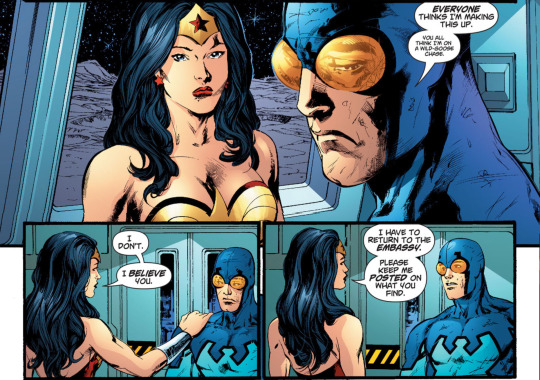


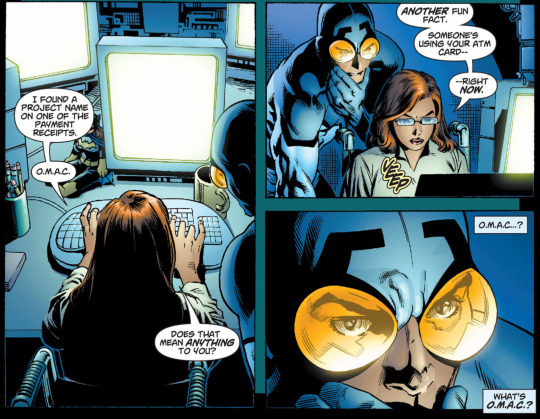
(Countdown to Infinite Crisis)
So Ted seeks out his best friend Booster to help. Booster, after some initial reluctance, joins up. There’s some noticeable moments where Booster hints that he knows some things about the future (particularly, that Ted is going to die, and the Scarab means that the new Blue Beetle, Jaime Reyes, is about to take over): Booster keeps staring at the newly found Scarab. He asks Ted when he found it. Ted, in his narration, hints that Booster knew Doomsday would kill Superman, and he still took the first punch.




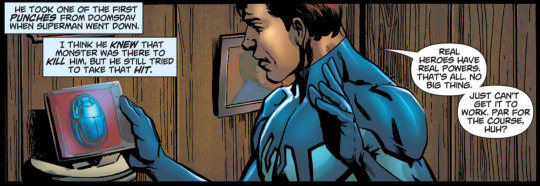
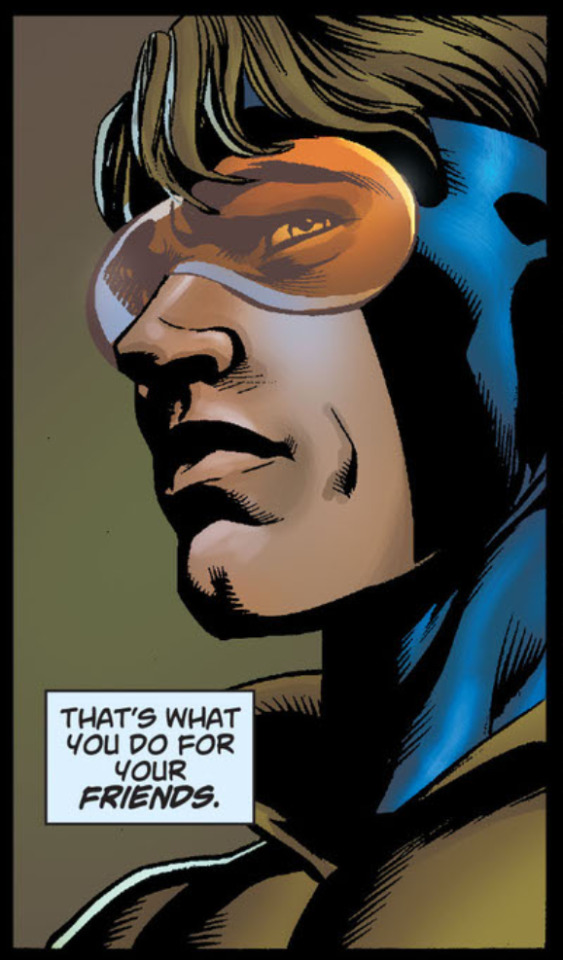
(Countdown to Infinite Crisis)
All of this parallels what happens next: Booster shoos Ted away from the computer and takes over. Booster gets hit by an explosion meant for Ted.

(Countdown to Infinite Crisis)
Consider: Later implications of time travel suggest that some small things can be changed, but the big things can’t. If Booster knew what was going to happen, did Booster only postpone Ted’s death?
With that, Ted does die at the end of this story, and a part of The OMAC Project is Wonder Woman and Booster investigating Ted’s death. But as much as I love Ted, we’re mostly talking about Booster and time travel today. So moving on!
In Infinite Crisis, Booster is the one who fetches Jaime Reyes. After returning to the 25th century to access historical records, he tracks down Jaime via the scarab. (Of course, this is another example of a potential change: Booster says he may be saving millions or billions of lives, but this is unsubstantiated.)
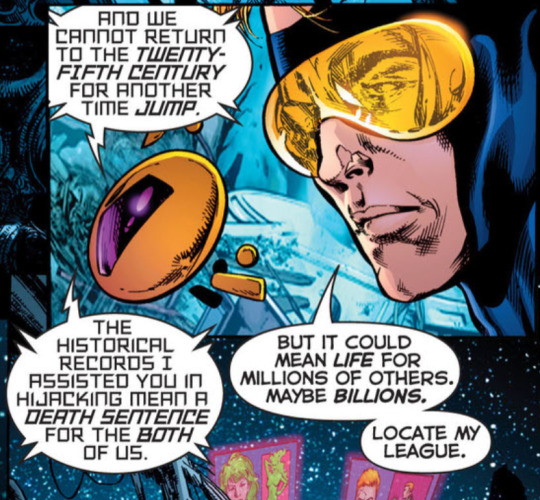
(Infinite Crisis #2)
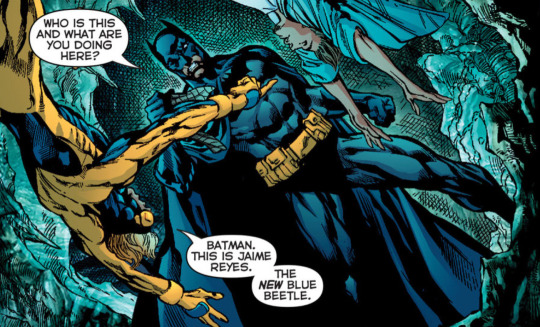
(Infinite Crisis #5)
So this brings us to 52, the fallout of Infinite Crisis. Booster Gold’s plot, while not obviously central in its introduction, plays a major role in bringing back the multiverse to the Post-Crisis continuity. Booster Gold, in the wake of the loss of his best friend Ted Kord, has sold-out again.

(52 #1)
With the help of Skeets, he’s returned to his origins. He wants to be a hero and make bank. Superman’s not around, so who else could Metropolis turn to?
Booster is on the outs though. First, with the heroes: Ralph Dibny blames him for not realizing his wife Sue was going to be murdered. Beatriz de Costa (Fire) shames him for how he’s acting after Ted’s death.

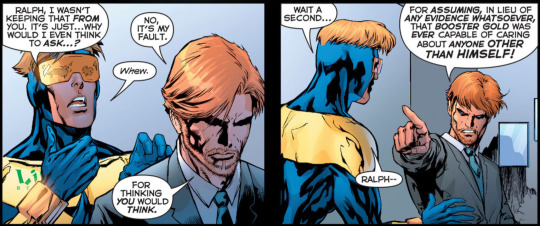
(52 #7)
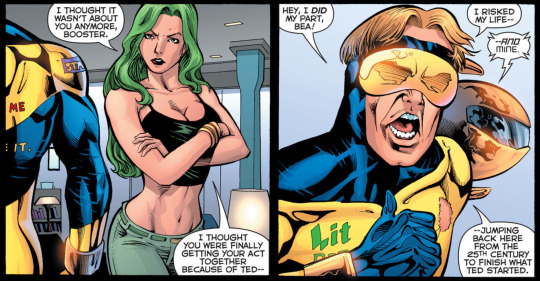

(52 #4)
Pay attention to that notepad. Booster writes the names of Rip Hunter and his fellow Time Masters, as well S.T.A.R. Labs Time Travel Division. Everyone but Rip Hunter is crossed out. Rip’s name is circled, but he’s noted as “unlisted?????”
Because he’s noticed a number of events that don’t line up with the history Booster and Skeets remember, Booster goes to visit Rip Hunter in his Time Lab in Arizona. Skeets has to hold the door open because of the lock, so Booster goes in by himself...

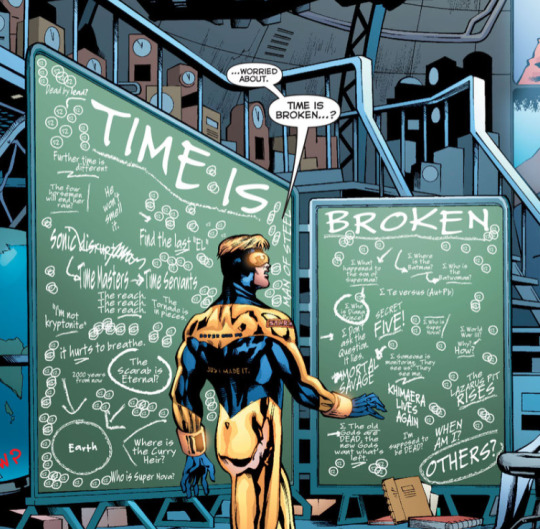
(52 #6)
...and sees this... (Feel free to read what’s on the chalkboard. A lot of it hints to happenings in both 52 and the One Year Later event, as well as other stories. It can be fun to make connections.)
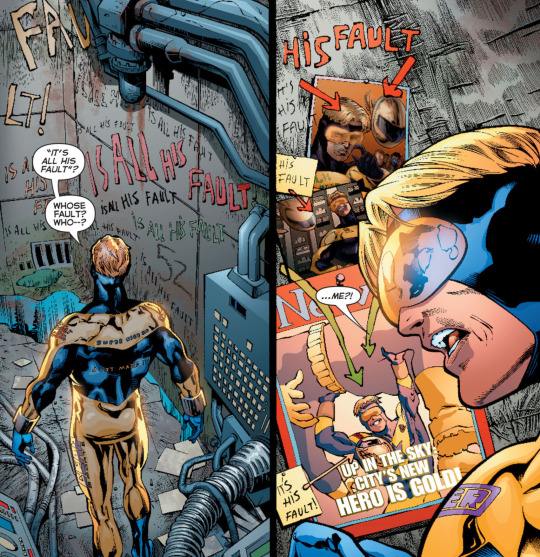
(52 #6)
...and this. Yikes.
We soon find out that Booster hired an actor to fake an incident on a subway. Why? Well... that answer’s not so clear. But considering the rest of the story, it’s likely Booster wanted to discredit himself.
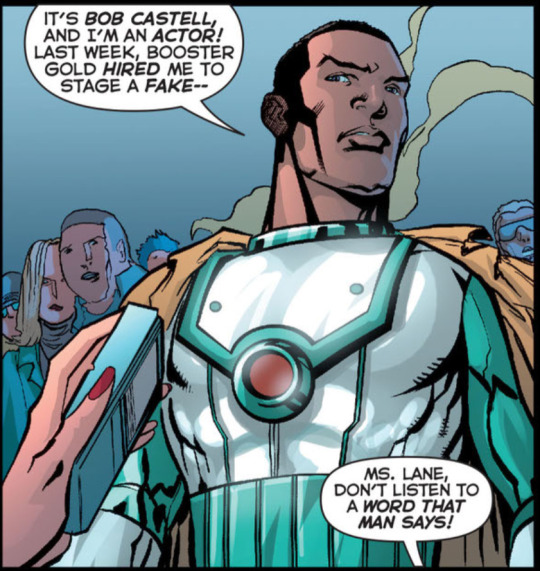
(52 #7)
Unfortunately for Booster, this ruins his reputation with the public, and he’s soon replaced by a new, more humble hero: Supernova.
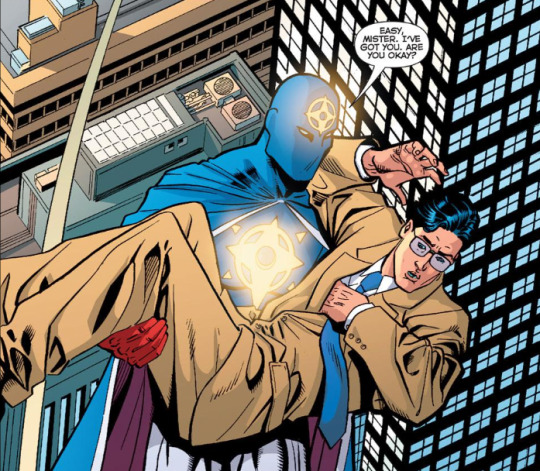
(52 #10)
And the public adores Supernova. Meanwhile, Booster’s sponsors pull out as his reputation goes down the drain.
Booster gets one last moment in the limelight, when he pushes too hard trying to upstage Supernova, and he dies... though he’s recognized as a hero for his tragic sacrifice.
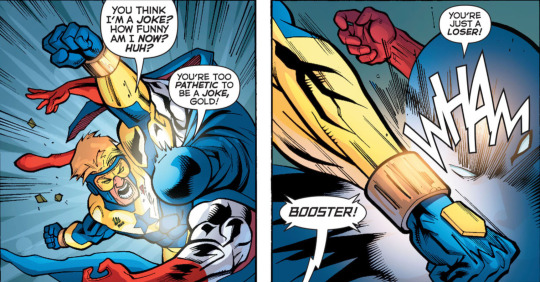
((Hold on if you haven’t read 52. You’re going to find this one funny.))

(52 #15)
So... Booster is dead. Ha. What next? Well, Skeets seeks out Booster’s ancestor, Daniel Carter, for help to get back into the Time Lab. After all, Booster didn’t give Skeets the details.
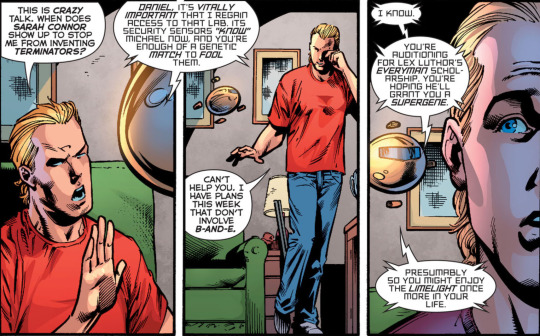
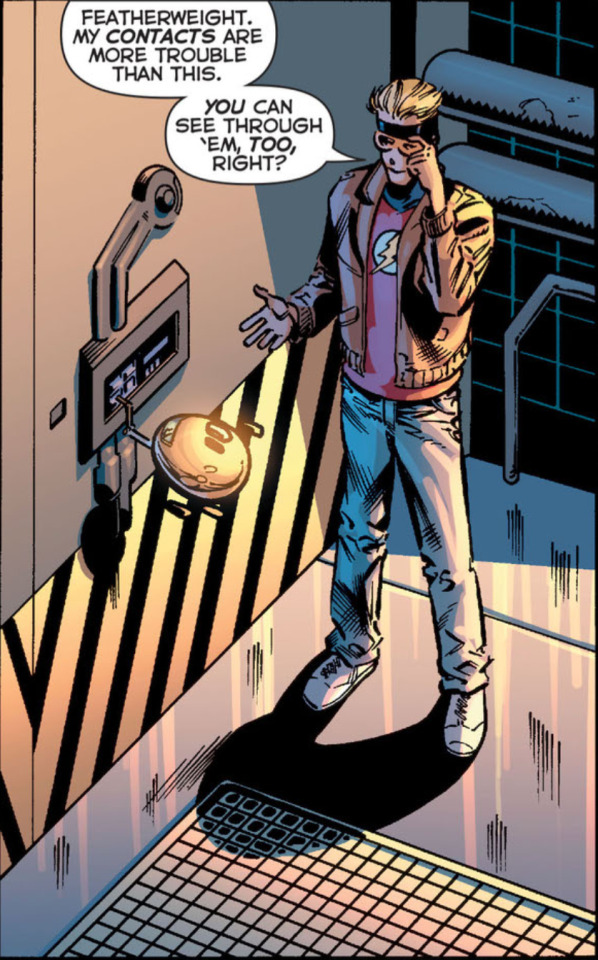
(52 #19)
Daniel lets Skeets see into the Time Lab, where Skeets finally sees the same things Booster saw.
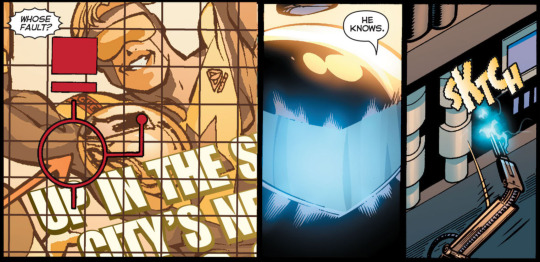
(52 #19)
Whoops! The real problem is Skeets. A little more menacing now, isn’t it? So Skeets abandons Daniel in the Time Lab, where he’s sucked into a vortex that’s part of Rip’s security measures. Meanwhile, Skeets is free to handle his evil plan. Whatever that is.
Back to Metropolis: Supernova is still out there, doing good. He’s also grabbing items that seem a little... eclectic.
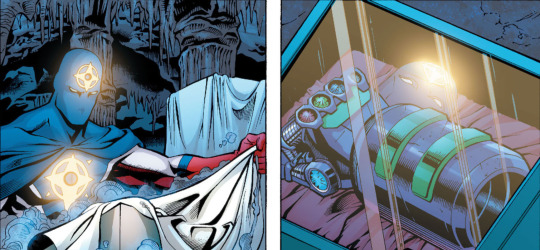
(52 #20)
And everyone is theorizing about who’s really under the mask. Cassie Sandsmark thinks it’s Kon-El. Lex Luthor thinks it’s Superman. Ralph Dibny puts the pieces together...

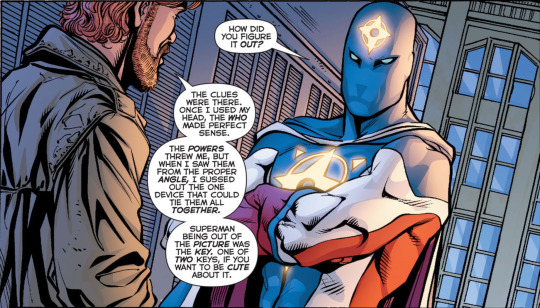
(52 #31)
But Supernova asks him not to say it out loud.
Later, we see that Supernova is actually working for Rip Hunter. Everything he’s gathered has been for Rip, who, as you can see, is really going through it. (Sad they never followed up on why Rip Hunter was affected like this, but I have my own thoughts that I might say later.)


(52 #36)
Where are they working anyway? In the jarred city of Kandor! Of course, Skeets can’t find them here, can he?

(52 #36)
Whoops. Spoke too soon.

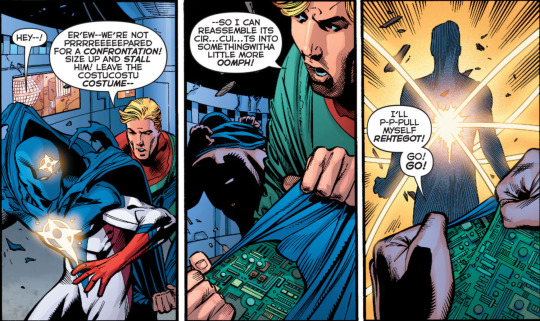
(52 #37)
But who is Supernova? That burning question we’ve had for all these issues?
It’s... Michael Carter! Booster Gold!

(52 #37)
So, as Rip asks, Booster tells him. Booster knew something was off with Skeets. At the Time Lab, he almost asked him. But Rip Hunter arrived and recruited him for the long con. Rip needed Booster to gather materials, but they couldn’t alert Skeets. However, using a suit Rip rigged, Booster could be in two places at once: through time travel. After faking his death (using his real corpse from the future), Booster was sent back in time twelve weeks to complete Supernova’s actions.
Now Rip, Booster, and Skeets are engaged in a battle that, uh... is not continued until Week 50 on panel. If you count this as continued. I just love this panel.
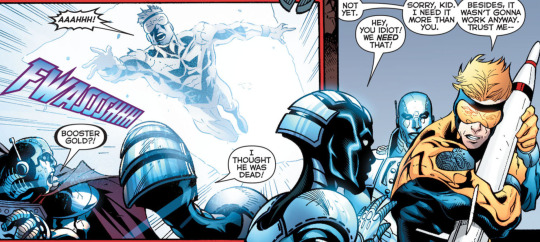
(52 #50)
Actually, Skeets follows Rip and Booster to a lab where T.O. Morrow has searched the Red Torado’s brain to find out the truth of the 52 that he’s been repeating throughout the series.


(52 #51)
Of course, it’s not actually Skeets. The real Skeets was used as a chrysalis for Mister Mind... who has become a horrifying moth hellbent on eating the new multiverse.

(52 #51)
Rip drags Booster out, back to the Time Sphere, where they travel back to the beginning.
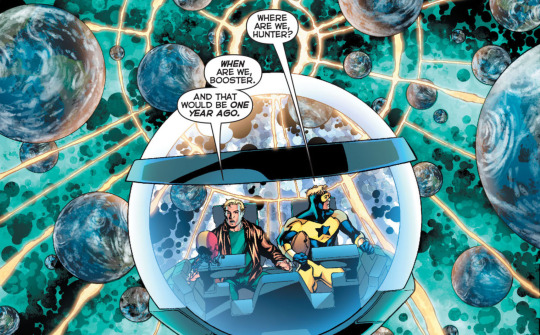
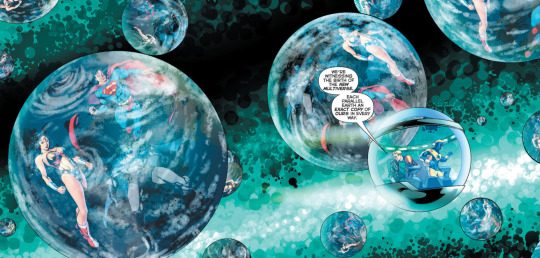
(52 #52)
After the events of Infinite Crisis, the multiverse was recreated. 52 identical Earths came into existence, and the same struggle has been taking place on all of them. These Earths are slowly aligning, and for some reason, Rip can see this, but Booster can’t. (Hold tight: Let’s keep in mind, for some reason, Rip was totally non-linear earlier. We’ll come back to this.)

(52 #52)
Rip intends to save all of the Earths, as they slowly settle into the new multiverse, with help from Supernova! ...This time, Daniel Carter, the Carter family ancestor that Skeets/Mister Mind used earlier.

(52 #52)
Bad news is that Mister Mind is still bent on eating a universe. As he eats parts of the various Earths, he changes their history, which leads to each Earth being unique.

(52 #52)
Booster has doubts about their ability to face something this big, but Skeets, now broken from Mister Mind, cheers him on... Booster heads back to the one place he knows to get the right power source, and Rip hints about Booster’s “glory days” soon to come. So now we know there’s a connection between Booster and Rip.
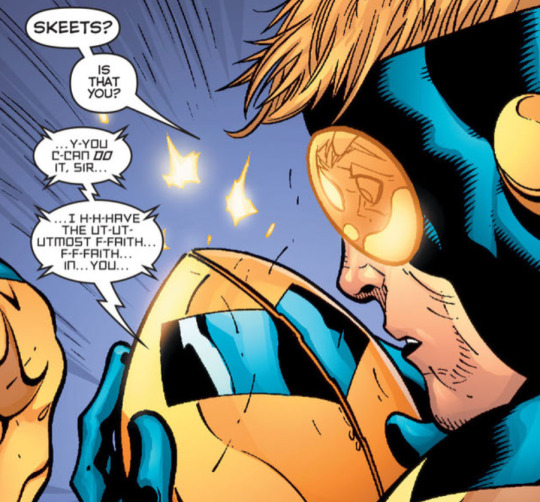


(52 #52)
But where is Booster going to get that power source?
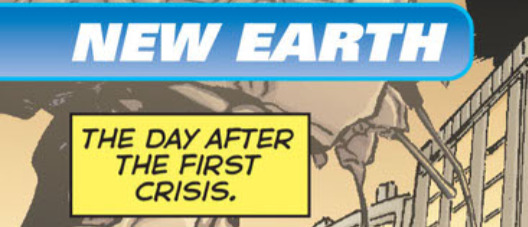
(52 #52)
The immediate aftermath of the first crisis, where he talks a little with very young Ted Kord. (Sad.) Now we have to wonder how Booster knows to go back here? How much about time travel does Booster know yet?
Anyway, together, Rip, Booster, and Daniel succeed in defeating Mister Mind, and the multiverse is restored. Rip is very optimistic!

(52 #52)
So... let’s cut to Booster Gold’s second solo. Notice the title of his first story is “52 Pick-Up.” Booster, after saving the multiverse, wants nothing more than to be a hero again. He wants to join the Justice League again! Unfortunately, he’s recruited by Rip Hunter once again, who makes it clear that Booster’s destiny lies in time travel instead. And the world needs to think Booster is an idiot.


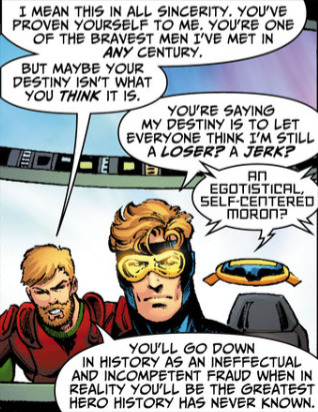
(Booster Gold (2007) #1)
Notice how Rip mentions his father? We’re finally getting somewhere.
Meanwhile, the other weird Time Stuff, that’s going on. Back at Rip Hunter’s Lab, Rip has written a number of interesting things on his chalkboard again.
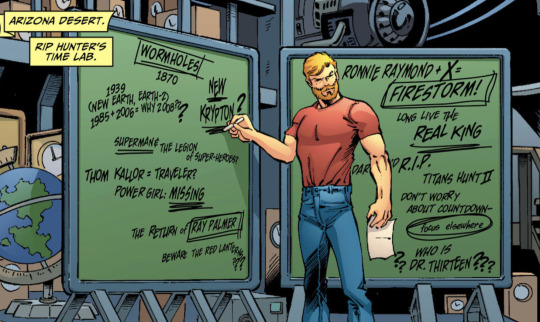
Notice how Rip notes 1939 (the year Detective Comics was first published), 1985 (Crisis on Infinite Earths), and 2006 (Infinite Crisis). This shows how the crises actually affect time in the DC universe. Rip is, of course, aware of it. Is Booster too? How else would he know about the first crisis?
What is the connection between Rip and Booster anyway? Why does Rip care so much about Booster? Well...
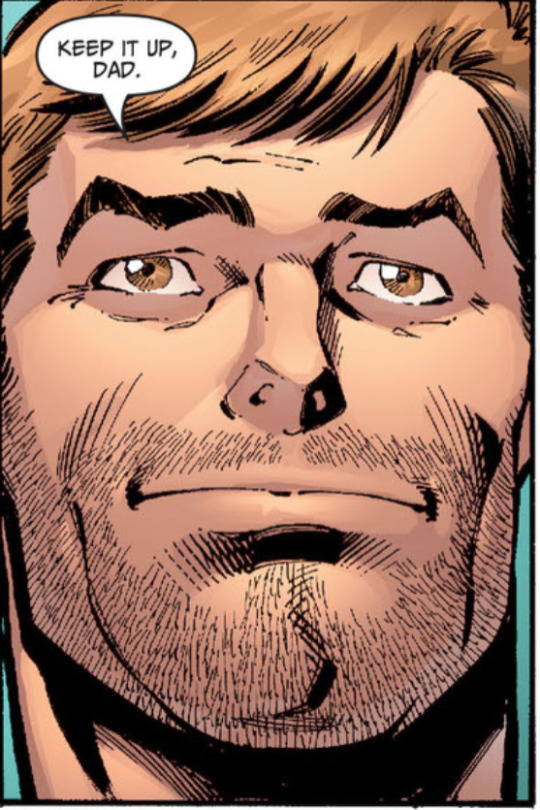
(Booster Gold (2007) #1000000)
That’s right! Booster is actually Rip Hunter’s dad! So a lot of stuff we’ve been over must make more sense now.
But seriously, the Carter family is heavily involved in time travel, and the way it interacts with them is interesting. We’ve already seen how Rip isn’t linear when the timestream is disrupted... but what about the other members? How does this all affect Booster?
Honestly, I’m not sure. And I just ran out of energy for this post. If you want to know more, send an ask! And read the comics. You will not regret it.
#megan liveblogs comics#well not exactly but this is pretty close ig#if i can make ONE person want to know more about booster and the carter family my job is done#i just spent hours on this mess and now i'm about to cry bc it's so bad i'm sorry
14 notes
·
View notes
Text
Zack Snyder’s Justice League vs. the Whedon Cut: What are the Differences?
https://ift.tt/38SVA8s
This article contains Zack Snyder’s Justice League spoilers.
Whether you love or hate his style, there is no denying Zack Snyder is an original. From 300 to Watchmen, and Man of Steel to Justice League, his characters often hover above the screen as much as occupy it. They’re mythic figures who’ve stepped off a Botticelli canvas, or at least Frank Miller comic book panels, and they’re imbued with such a sense of scale from their director that the aesthetic is nigh impossible to duplicate. That is only clearer now thanks to Zack Snyder’s Justice League, a restored four-hour edit of Snyder’s original vision for the DC superhero movie team-up and their universe at large.
Admittedly, you’ve seen the movie’s tale before, back when Warner Bros. released a truncated, heavily reshot version into theaters in 2017. But that two-hour theatrical cut of Justice League, assembled by director Joss Whedon, really is a night and day different film. It shares many of the same scenes and story beats, but it lacks Snyder’s singular grandiosity and tonal consistency.
Comparing all the significant changes between the two versions—which we’ll hereby distinguish as the “Snyder Cut” and “Whedon Cut”—creates a fascinating juxtaposition of the different choices filmmakers can make with similar material, as well as the drastically disparate visions the directors had for these six superheroes and the larger DC Extended Universe. So join us as we contrast all the major changes (and by and large improvements) made by Zack Snyder’s Justice League.
The Opening
One of the most surprising changes made by the Snyder Cut comes immediately. Back when the ostensible Whedon Cut of Justice League opened in theaters, one thing many assumed was unchanged from Snyder’s vision was the opening credits. With imagery clearly filmed by the director—including unused footage from the Superman funeral sequence in Batman v Superman: Dawn of Justice—the downbeat credits were edited to Singrid’s rendition of “Everybody Knows,” a cover of a song from one of Snyder’s favorite musicians, Lenoard Cohen. I’m also fairly certain only Snyder would film a homeless man with a cardboard sign saying “I tried” in a superhero movie (the destitute figure may still appear in the Snyder Cut in an overhead shot when Cyborg is later surveying the bleakness of the world).
Indeed, quite a bit of the Whedon Cut’s opening credits scenes are used elsewhere in Zack Snyder’s Justice League, including breathtaking imagery of the Superman symbol draped in black over London’s Tower Bridge. But the new edit foregoes a traditional opening credits sequence for a more restrained montage that returns to the climax of Batman v Superman, and to the moment when Henry Cavill‘s Superman dies. In pained slow-motion, we again experience the moment of Doomsday’s spike piercing Superman’s heart and see how his scream reverberates throughout the world.
The Snyder Cut is more directly linked to the previous movie with Jesse Eisenberg’s Lex Luthor, complete with hair, hearing Superman’s cries from deep in the bowels of the Kryptonian ship. Meanwhile the echoes of Clark’s anguish reverberate all the way past Zeus’ magical cloak to Themyscira where the Amazons (rather impressively) have an entire army guarding the Mother Box they obtained 5,000 years ago. When the Mother Box hears Kal-El’s death rattle, it begins to crack, drawing a terrified Amazonian closer to its new glowing light.
And finally, we end with the cries being heard by Cyborg. It is on the image of a hunched over Ray Fisher that Snyder chooses to include his “directed by” title card, indicating a strong sense of solidarity with the character and the actor who plays him after Cyborg was largely sidelined in the Whedon Cut. Clearly this is going to be a different movie.
Batman
Ben Affleck’s Bruce Wayne remains the focal point, at least in terms of leadership, of both the Snyder and Whedon cuts of the film. But right down to how they’re introduced, these are subtly diverging interpretations of the character. In the Whedon Cut, Batman has the first scene of the movie that isn’t shot on an iPhone. It gets Affleck in costume immediately and features archetypal Gotham City imagery as Batman uses a criminal as bait for a Parademon, an alien from the planet Apokolips that Batman is already familiar with. He’s so aware of these creatures that Batman ignores the thief spelling out the subtext of Justice League’s first act: With Superman dead, where does that leave us?
By contrast, you intrinsically feel that absence in the Snyder Cut. Whereas Whedon and WB got Batman in the costume faster for a tongue-in-cheek action sequence with screaming crooks and flying aliens, Zack Snyder’s Justice League ignores the Batsuit for a clean two hours. Instead, it opens with Bruce Wayne already “north” in a remote part of Europe near the arctic. We get the impression he’s been traveling for weeks on a horse and over mountains, sporting a bushy beard as he reaches the fishing village Arthur Curry (Jason Momoa) has provided supplies to.
The scene where Batman meets Aquaman is more or less the same, but tonally Snyder evokes a funereal quality by letting the scene breathe in Bruce’s desperation instead of Arthur’s flippancy. And rather than Bruce noticing an inserted mural of Mother Boxes being what upsets Arthur, it’s Bruce pulling a trick from Momoa’s on screen wife on Game of Thrones which sets Aquaman off: he reveals after his hosts have made fools of themselves that he too can speak Icelandic. (There is also no longer a joke where Bruce says, “I hear you can talk to fish.”)
This somber opening is strikingly different and a vast improvement (see the Aquaman section for more). After Arthur rebuffs Bruce’s request to team-up, Bruce’s defeated return trip home is also subtly changed. For starters, we see his journey to his private jet where Alfred is waiting. In the Whedon Cut, the pair’s conversation after Bruce has shaved is a reshot sequence with some admittedly amusing character-building dialogue, like Alfred saying, “I miss the days when one’s biggest concern was exploding wind-up penguins.” The Snyder Cut’s version is more expository and ominous. As neither has seen a Parademon yet in this version, Alfred doubts whether Bruce needs to build a team based on the ravings of a now incarcerated and visibly insane Lex Luthor. Batman says he isn’t just doing this based on Luthor.
“I made a promise to him on his grave,” Bruce broods about the Kryptonian alien he hounded to near death in the last movie.
The next time we see Bruce Wayne is in a scene that appeared in the Whedon Cut, if slightly different. It’s when Gal Gadot’s Diana Prince breaks into his “building” with million-dollar security. However, the Whedon Cut led viewers to believe this airplane hangar-like space was the Batcave (even though it visually looks quite different). The Snyder Cut confirms it is a decrepit warehouse near the docks in Gotham harbor. Gone also is the cheeky line, “Yeah, it looked expensive,” from Diana when Bruce mentions the cost of his security equipment.
Read more
Movies
Ben Affleck Talks Working with Matt Damon Again in The Last Duel
By David Crow
Movies
Ben Affleck Returns as Batman for The Flash Movie
By Mike Cecchini
In this off-site Batcave area, it’s also established by Alfred that he and Bruce Wayne have built new gauntlets that absorb energy (they come in especially handy later when they save Bruce from Superman’s heat ray vision).
The first time the gauntlets are used occurs when Batman leads a nascent Justice League beneath the tunnels of Striker Island in Gotham harbor. Up until that point, most of Affleck’s scenes remain the same, even if they breathe or are edited slightly differently. Batman recruits Barry Allen (Ezra Miller) to join the Justice League while talking about competitive ice dancing, and looks positively exhausted when Barry sees the Bat-Signal. The early Commissioner Gordon scenes are also the same, albeit now without composer Danny Elfman’s Batman theme from 1989.
In the tunnels, Batman’s scenes diverge again though. There is more of the misterioso act when Victor Stone (Cyborg) says, “I heard about you. Didn’t think you were real.” The Dark Knight answers, “I’m real when it’s useful.” Additionally, Batman doesn’t really mentor the Flash in this sequence or in any other going forward. Gone is the Flash admitting he’s terrified at seeing Steppenwolf and Bruce advising he “save one” person and will then know what he needs to do.
Instead, the Flash says, “I guess that’s the bad guy” in the Snyder Cut, and Batman stoically responds, “Good guess.” Bruce also drops his sense of humor, losing some solid bits like “Sorry guys, I didn’t bring a sword” when the Knightcrawler starts shooting up Parademons. Now he simply says, “My turn.”
However, Bruce remains the stoic team leader, harnessing a steadier team dynamic. There are no insert shots of Commissioner Gordon telling Batman it’s good to see he’s playing well with others after the Striker Island fight, and rather than berate Wonder Woman and his team members into bringing Superman back from the dead, Bruce and the rest come to the same conclusion, silently.
During the sequence where Cyborg reveals the Mother Box can bring Superman back from the dead, no one says Kal-El’s name out loud. The Flash even asks, “Is everyone thinking it or am I going to have to say it?” The camera pans around the table and lands on Bruce, who is watching Cyborg’s projected image of Superman’s cape. It’s a nice moment for Affleck, who looks much more alert in this version than the Whedon Cut. The dialogue in the Snyder Cut can often be perfunctory and expository, but the vast four-hour running time leaves room for the actors to indulge in quiet moments. The only person who doubts the idea is Alfred who in another scene warns Bruce, “If you can’t bring down a charging bull, then don’t wave the red flag.”
Batman counters, “I’m operating on complete faith now.” Quite the about face from the last movie.
The team otherwise staying on the same page, even after the Superman fiasco (more on that below), is a stark difference with the Whedon Cut. Here Bruce invites the team into the Batcave proper after they lose all three Mother Boxes, with teammates regrouping; in the Whedon Cut there is a strained attempt to create tension. Particularly between Bruce and Diana….
Wonder Woman
Gal Gadot has spoken in the past about how she was unhappy with the Justice League reshoots. While still not knowing the full details of what occurred behind the scenes, Zack Snyder’s Justice League makes apparent why she’d be disappointed with the direction of her added scenes.
To be fair, Wonder Woman is still objectified to a certain degree in the Snyder Cut. Her non-warrior attire still revolves around several low-cut dresses, and there is still a (much more understated) flirtation between Diana and Bruce. In an early scene of her and Bruce discussing their prospective teammates in front of a computer—with an awkward stab at humor where she coaxes out of Bruce that Arthur said no—there’s a moment where their hands trip over the mouse at the same time, like they’re in a teenage rom-com. Similarly, when Barry and Victor are digging up Clark Kent’s grave, Barry asks Victor if he thinks Wonder Woman would “be into younger guys.” Victor dismisses the thirstiness by saying, “Barry, she’s 5,000 years old. Every guy’s a younger guy.”
But these moments are few and far between. In the Whedon Cut, they’re constant with Alfred teasing Bruce about Batman inviting Wonder Woman to a candlelit team-up dinner, and a gross gag where Flash saves Wonder Woman during the Striker Island fight but then awkwardly lands on top of her body and gets flustered. Perhaps most frustratingly though, her character arc is reduced to a lot of flirting with Bruce, and coming to see he is right when he chastises her for “still being hung up” on Steve Trevor. She then helps him undress from his armor and shares a drink with him, like co-workers with a forced “will they or won’t they” chemistry.
All of that is gone in the Snyder Cut, which instead focuses on presenting Wonder Woman as the most ferocious and noble of the film’s six superheroes.
Her first scene is much the same as in the Whedon Cut, although it’s another film school-ready example for what a difference post-production makes. We see a group of eco-terrorists take a school group hostage, and Wonder Woman stops them. But in the Whedon Cut, the scene is nimble and brightly colored with a tongue-in-cheek quality, right down to the way Elfman uses an orchestra to play Hans Zimmer’s previously electric “Wonder Woman” theme. In the Snyder Cut, the sequence lasts nearly eight minutes in a desaturated, gray color scheme. The sadism with which the terrorists want to kill their hostages is belabored, and Junkie XL uses a fearsome version of Zimmer’s Wonder Woman theme while introducing one of his own, which relies on a haunting choral harmony.
In the new cut, Wonder Woman not only throws the bomb through the roof but jumps with it to make sure it explodes faar above the skyline. And when she returns, her power move to stop the head terrorist from killing the school children is to obliterate him into dust, with his hat blowing out the window and before the faces of shocked and unnerved London police officers. Meanwhile Wonder Woman then turns around after slaughtering this man (plus another terrorist who’s head she smashes into a wall) to rather jarringly smile at the school children. She leans down before one girl to say, “You can be whatever you want to be.” It’s actually sweeter than her saying “[I’m] a believer,” but I’m not sure it works given the new tone of the scene.
The next time we see Diana is a longer version of the scene where she discovers her mother has fired a burning arrow into the Temple of the Amazons in Greece. Snyder actually uses an impressive long one-take shot where Diana remains in focus, cleaning a statue at the Louvre, while her co-workers stay out of focus and needle her with questions. It’s a genuinely dryly funny, restrained moment, unique for this genre.
There is also an all-new scene of Diana going to Greece and retrieving the arrow from the temple. It’s one of the better additions that feels like a pseudo-Indiana Jones scene of Diana using the arrow to unlock a hidden chamber beneath the ruins, and then descending with a torch. Below she discovers a spooky room filled with spooky murals containing even spookier images of Mother Boxes and war… and a godlike monster DC fans will recognize as Darkseid.
Diana’s narration of what these images tell her is also different (more on that in the Darkseid section), with no lakeside chat with Bruce. Rather than using romantic imagery, Snyder favors to-the-point storytelling between colleagues as Diana tells Bruce in his new Batplane that the Age of Heroes defeated Darkseid. That age is over.
Read more
Movies
How Wonder Woman 1984 Treats Its Villains Sets the Movie Apart
By Rosie Fletcher
Movies
Zack Snyder’s Justice League: Why Wonder Woman and the Amazons Have a New Theme
By David Crow
While Bruce is recruiting Barry, Diana has a nice scene with Alfred about making tea before Victor Stone summons her by hacking the Bat-computer. She has no idea who he is in this scene (as opposed to having seen him earlier in the Whedon Cut), and there is no conversation where she convinces him to meet her. Instead, he designates location, summoning her. Their next scene together is more or less the same as in the Whedon Cut.
Overall, Diana has few added scenes and is honestly one of the less developed characters in the Snyder Cut despite being one-half of the team’s leadership. So the inclination of giving her more to do than discover Darkseid/Steppenwolf’s backstory was a prudent one, but all it left her with was smiling longingly as Batman drives off in the Batmobile during the third act. Ugh.
The Amazons on the other hand…
The Amazons
While Wonder Woman’s scenes in the Snyder Cut largely remain the same, the Amazons are given subtle but fierce new texture in their few added moments.
The movie opens with the Amazons tirelessly on guard when the Mother Box awakens. The next time we see them, Queen Hippolyta (Connie Nielsen) is arriving to inspect the phenomenon for a prolonged build-up to Steppenwolf’s attack. When one soldier tells their Queen maybe the box will go back to sleep, Hippolyta remarks, “Evil doesn’t sleep. It waits.”
Steppenwolf eventually attacks, leading to one of the best moments in the Snyder Cut. When he says his Parademons will feed off their fear, Hippolyta calls to her Amazons, “Daughters of Themyscira, show him your fear!” In a tribal yell matched by Junkie XL’s score, they chant back, “We have no fear!” Slaughter commences.
The battle is much bigger and more reliant on slow-motion, including shots of Hippolyta flipping off walls and hesitating to bury the other Amazonians alive. Yep, when she tells her sisters to seal the cave, it’s a death trap. The door collapses, and then the whole structure also falls into the sea. There is then A. Long. Beat. of Hippolyta thinking she’s killed Steppenwolf before he and his Parademons ascend from the sea to slaughter more of the Amazons.
The Amazonians’ defeat is largely the same, although there is now a long denouement, with the Amazons having a musical prayer that grieves their dead and brings magic to the arrow they’ll fire to warn Diana. The Amazons and Wonder Woman iconography are also much more heavily featured in flashbacks to Darkseid’s first attack on Earth 5,000 years ago. We get better shots of Zeus and Ares (David Thewlis from Wonder Woman), and Amazonian Venelia (Doutzen Kroes) being filmed like she’s one of Snyder’s 300 Spartans in the ancient war. But all of that is just background for…
Steppenwolf and Darkseid
Steppenwolf is one of the most dramatically improved characters in Zack Snyder’s Justice League. Beyond more spikes being added to his armor (and his chin being slightly shrunken from its ridiculous size), the Ciarán Hinds-voiced baddie’s motivations are wholly different. In the Whedon Cut, he was a generic “conquer the world” supervillain who was defeated thousands of years ago on Earth by an alliance of men, Amazonians, and Atlanteans. He then returns and refers to his Mother Boxes as “mother.”
While he still chases magic boxes he wants to use to conquer the world in the Snyder Cut, he’s at least a little more nuanced and a lot more despairing toward the whole endeavor. Steppenwolf is revealed to be a meek middle management malcontent with dreams of coming home. As we eventually learn in dialogue exchanges over BvS’ weird molten metal intergalactic telecommunication technology, Steppenwolf is a pariah back home on the planet Apokolips. Long ago, he was party to a failed coup against comic book creator Jack Kirby’s ultimate space fascist, Darkseid (Ray Porter). Think Thanos before there was a Thanos.
“I fall before you,” Steppenwolf moans during his first conversation with Darkseid’s minion DeSaad (Peter Guinness). “Let me make a plea that I may come home after I take this world in [Darkseid’s] name.” But DeSaad will not hear it, saying Steppenwolf is basically on probation for helping an attempted coup against Darkseid millennia ago, even if Steppenwolf then changed sides and killed Darkseid’s other betrayers. Now Steppenwolf has a debt of a 150,000 worlds he must conquer in Darkseid’s name if he wishes to return home.
Basically, Steppenwolf is a putz. Hence he can be both menacing and pathetic when he first attacks the Amazons and remarks of them, with a hint of resigned boredom, “Defenders? Defenders have failed a hundred thousand worlds. They always fail.” And it’s with exhaustion he decides to create his home base on an irradiated scrap of Russian land because it’s toxic.
Read more
Comics
Jack Kirby: Comics’ Greatest Storyteller
By Rand Hoppe
Movies
Justice League: New Snyder Cut Steppenwolf Draws Internet Fire
By Kirsten Howard
Darkseid, by contrast, is introduced to be Emperor Palpatine meets Sauron. Aye, there’s a real Lord of the Rings level of ambition to Diana’s flashback to the Age of Heroes. Rather than Steppenwolf, it’s Darkseid who first steps foot on Earth, turning some of the soil into the scorched cursive hellscape that Kirby fans will be intimately familiar with. We also get a better look of his foes, including an alien Green Lantern whom Darkseid personally kills by cutting off his hand. The green ring flies away before the fiend can grab it.
The sequence is filmed to mirror the opening moments of The Fellowship of the Ring, with Darkseid’s defeat harkening back to the glorious day the people of Middle-earth were victorious. However, personally speaking, it doesn’t reach that height, with Darkseid coming off like more of an overpowered Orc who’s out-flexed by Ares. Yep, David Thewlis’ villain from Wonder Woman is revealed to be the guy who whoops Darkseid’s ass in the end, planting an axe in his shoulder blade and leading the Greatest Evil to be carried from the battlefield, screaming.
Much later in the movie, Darkseid is introduced properly when Steppenwolf reveals he’s learned Earth is home to the Anti-Life Equation. It’s a pretty vague secondary MacGuffin in the context of the Snyder Cut, although Steppenwolf says it would give Darkseid power over the multiverse—it’s unclear why Darkseid did not know it was on Earth when he lost to Ares and the band of heroes, or why he never could come back for it.
However, Darkseid then appears on the telecom with Steppenwolf, causing the Spiked One to take off his armor for the first time and show his bare flesh in fealty to his space dictator. Darkseid promises Steppenwolf he can come home once he’s taken Earth and brings Darkseid the Anti-Life Equation.
We also get a glimpse of how Darkseid plans to use it. Elsewhere in the movie, Cyborg has an inexplicable vision the moment right before a Mother Box is used to bring Superman back from the dead: It’s of an Armageddon much darker than the Knightmare scene in Batman v Superman. The sequence begins with the Amazons finally off Themyscira. They’re burning Wonder Woman in a funeral pyre after putting two coins on her eyes for the boatmen. Hippolyta cries.
Elsewhere in a montage, Superman grieves over the scorched body that can only be Lois Lane (Amy Adams) and Darkseid appears to place a not-so-comforting hand on his shoulder. Later we see the ruins of the Hall of Justice that diehard Superfriends fans will recognize, with an evil Superman flying over it with heat ray eyes. Finally, we see Darkseid himself murder Aquaman with his own trident…
This appears to be an inevitable future of “the Snyder Verse.”
Aquaman
But that is not the destination of the current film. The Snyder Cut, after all, has to lay a lot of groundwork that’ll make us care about these characters in the here and now.
Aquaman is the first to get that treatment in his early scene with Bruce Wayne (detailed more above). The Whedon Cut includes Arthur Curry saying, “You’re out of your mind, Bruce Wayne” as he gets into freezing cold water to swim away. In the Snyder Cut, we don’t see him shoot off. Rather Arthur disappears quietly beneath bubbles between shots. Snyder’s desire to emphasize the godlike wonder of these characters is then underlined in neon when several villagers see him off by singing a worshipful Icelandic hymn in Aquaman’s honor.
If the point is missed, after several minutes of crooning, one woman walks up to caress the sweater Aquaman took off and sniff it, savoring his undoubtedly godlike musk.
The sequence of Aquaman saving a crew from a shipwreck is almost exactly the same in the Snyder Cut, although there are no added jokes about him calling the captain “Ahab” in the bar. Additionally, there’s a really nice grace note of Nick Cave and the Bad Seeds’ “There is a Kingdom” playing when Aquaman goes to brood stoically before a raging storm. It’s exactly the same as in the Whedon Cut, but Whedon makes it generic blockbuster filler with a White Stripes song playing in the background. Snyder goes for a mournful, reflective tone that resembles the better elements of his version of Justice League.
Afterward Aquaman makes his first of two trips to Atlantis in the film—meeting Vulko (Willem Dafoe) in a scene that was entirely deleted. It turns out the effect of Atlalnteans only talking in air bubbles was always a Snyder affectation, although what was lost in the Whedon Cut (and eventual Aquaman movie) is that all the properly born Atlanteans speak with English accents. Dafoe’s Vulko is a bit hammier, seeming adjacent to Dafoe’s wonderful turn in The Lighthouse. But Amber Heard’s Mera speaking her lines in a purely Posh London accent after a whole movie of her using an American one in Aquaman is a real trip.
Read more
Movies
Creating the World of Aquaman
By Mike Cecchini
Comics
Aquaman: The End of an Era
By Marc Buxton
What brings Arthur back the second time is Steppenwolf diving below the waves for the Mother Box. He learns of its location (which is unexplained in the Whedon Cut) by torturing Atlanteans whom Parademons have dragged from the ocean, reading the water dwellers’ minds with some gruesome sci-fi spider robot.
Steppenwolf’s actual attack on Atlantis is much more coherent in the Snyder Cut. With action beats given time to pause, and Steppenwolf’s surprise appearance underwater less hilariously cringe-inducing. Mera also gets a cool moment where the villain has her pushed against the wall and says she can’t run away, “I wasn’t trying to,” she responds. Previously, we saw her use superpowers to suck water out of air pockets; now she uses it to suck the blood out of Steppenwolf’s face. He of course throws her back into the water and almost kills her if not for Arthur’s chivalrous, splash-page rescue of his future love interest.
Most of Aquaman’s subsequent scenes play out the same, although he is much less brutish and frat bro-y. There are at least three fewer “yeahs” and “alrights!,” and there is no scene of him sitting on Wonder Woman’s Lasso of Truth, blurting out he’s scared and horny at the same time.
The Flash
Interestingly, the Flash is both the least developed of the superheroes in the Snyder Cut and also the most unchanged by Whedon. It appears that Ezra Miller’s seemingly improvised humor was the element of least importance to Snyder, and the most useful thing Snyder filmed for Whedon’s purposes.
Maybe that’s why the Flash’s first scene in the Snyder Cut does not occur until nearly 70 minutes into the film. It’s also a wholly different introduction scene to what we saw in the theatrical cut. In the restored sequence, Barry Allen is applying for a job as a dog groomer at a pet shop when the unnamed woman who just left—or as fans know her, Iris West (Kiersey Clemons)—is almost pancaked by a semi-truck. The driver, in a rather crude cliché, is a simpleton reaching for his food on the cab’s floor when he slams into Iris’ convertible.
Luckily, Barry sees it coming and slows things down for another somber needle drop on the soundtrack. The whole thing plays like a more wistful, alternative rock version to one of Quicksilver’s big scenes in the X-Men movies. In extreme slow-motion, Barry catches a hot dog from an exploding hot dog vendor, placing it in his pocket, and then catches Iris out of her shattered car. When time returns to normal, Iris realizes she was saved by this cute dork, who then rushes back in time for the pet shop owner to be unsure who broke her window in the blink of an eye. Barry’s feeding the hot dog to her canines.
Otherwise, by and large, the Flash’s scenes remain the same until near the end. Snyder has removed Whedon’s unfunny addition of Barry drawing glasses on the eyes of someone in line while waiting to see his dad at prison, but the Miller/Billy Crudup scene remains the same but longer. Bruce Wayne still breaks into Barry’s loft and tells Barry his superpower is that “I’m rich.”
In the Striker Island action sequence, rather than “save one,” the Flash leads an exodus of civilians to the surface. And when debris nearly falls on them, he creates a shield by running so fast he looks like lightning in the sky blocking the falling rubble. He also is wounded by a Parademon laser blast so sharp it leaves him bleeding from the side of his leg, temporarily hobbled.
The one significant change before the climax is Barry and Victor digging up Clark Kent’s grave. It’s a sincerely quiet moment that (Wonder Woman leering aside) is refreshingly earnest and hushed for a superhero movie.
“I could do this in a second,” Barry says. Victor responds, “Yeah.” The implication is they should take their time and give Superman the honor he deserves. After his body is exhumed and wrapped up, Barry says, “He was my hero.”
Cyborg
Of the main five heroes in Justice League, Cyborg turned out to be the most important by far. Whatever occurred behind the scenes between Whedon, the producers, and Fisher, the actor had reason to be frustrated simply because his character arc was removed. In its place, he was forced to say, “Booyah.”
The Snyder Cut restores Victor Stone/Cyborg’s importance from the opening credits onward. It begins by basking in what isn’t sad between Victor and his father Dr. Silas Stone (Joe Morton). Initially, we spend more time with Silas, as the father throws himself into his work at STAR Labs to better understand the Mother Boxes.
Eventually, Cyborg gets his own flashback to a time when he was more man than machine. Under an aching musical theme written by Junkie XL, it’s revealed Victor was a gifted genius (his dean even says so!) at Gotham University. Victor is so intelligent, while also being a football star, that he can get away with hacking into the school’s database and changing a friend’s grades.
We also meet his mother who defends her son’s kind heart from the dean in a sequence that’s intercut with his slow-motion football glory, plus a side of melancholy because daddy wasn’t there. Only mom shows up for the game. Afterward they argue in the car about whether Dad really cares about Victor. A car is then seen rushing (unsurprisingly) into frame, T-Boning their car.
The process of Victor becoming Cyborg is only hinted at in scenes through various other flashbacks. But we do see Silas being told his wife is dead and that he’ll soon have to let his son go, too. Hence the bad blood between the two nearly throughout the Snyder Cut’s whole four hours. When we see Silas come home to Victor at their apartment, the son will not even speak to his father. Instead he reluctantly agrees to listen to a recording his father left for him. On the tape, Silas tells his son that the fate of the entire world is now “in your hands, Vic.”
Thanks to the alien technology of the Mother Box used to resurrect Cyborg, Victor has superpowers, which we see him fumblingly try out by flying on his father’s Gotham rooftop. But that’s “just the tip of the tip” of the iceberg, according to Silas’ voiceover. Victor’s high-end computer body now gives him the ability to control the world’s nuclear arsenals and the world’s economy.
This is visualized in a CGI mind palace created in Cybrog’s digital brain. There Fisher gets to play Victor as whole, and without a red eye. Some of it is effective, like floating missiles above his head. Other bits are just ludicrous, like financial markets being personified by a CGI bear slapping a CGI bull. It’s… weird.
But there are nice elements too, like Victor choosing to use his superpowers to see folks suffering, and giving a struggling single mother $150,000 out of an ATM machine. Through it all, he remains hooded and lonely, catching glimpses of people staring at his glowing countenance. It’s why he destroys his father’s recording when Dad tries to stop talking about Cyborg’s powers and instead address Vic as a loving father.
What draws Victor out of his proverbial cave is of course his father being kidnapped by Parademons. He seeks Diana Prince’s counsel but ignores her when she says his powers are a gift—I did miss the line, “If these are gifts why am I always the one paying for them?” Still, as in the Whedon Cut, he shows up on GCPD’s rooftop to join the team.
The one big addition during all the fighting is that when Cyborg flies now, his famous comic book face armor that protects everything but his red eye is finally used on screen. Plus he gets to save his father. Silas is shocked his son came for him, but Victor only says, “You’re my father.” Nothing more needs to be said.
After the Striker Island fight, however, Victor again takes center stage when Aquaman accuses him of possibly being compromised by his alien tech body. Cyborg reveals in a visual flashback, which Victor walks through in his mind palace, that the Mother Box was acquired by the Allies during World War II, taken from the Nazis’ collection of occult goodies in 1944. For nearly a century, it sat undisturbed in the Department of Defense until his father Silas realized it was similar to the technology used by the Kryptonian ship in downtown Metropolis.
That’s how Silas discovered its power, and in a horrifying flashback, he uses it when he looks at his son’s body on a slab, Vic’s lower torso gone. When Silas uses the magic box on Victor, the son screams bloody murder.
It is Victor Stone who puts the pieces together for the nascent Justice League and gets the heroes to begin acting like a real team. He puts together for the others that the Mother Box can be used to bring Superman back from the dead, and projects an image of Big Boy Blue for everyone to see.
Vic leads the team into STAR Labs to do the deed. And when Silas sees his son, still not talking to him, walk by with Batman and other weirdos, Dad doesn’t call it in. In fact, Vic and Silas are why the heroes win in this version, because after the Superman resurrection is bolloxed up, and Steppenwolf arrives to retrieve the third Mother Box, rather than run away, Silas sacrifices himself by heating the box with a laser so hot, that Batman can conveniently track wherever it goes in the world.
One could argue Cyborg was the most crucial of the heroes in organizing a true team team. Well, him and the legacy of another…
Superman
One imagines Superman’s treatment by Snyder and screenwriter Chris Terrio in what we now call the Snyder Cut, and Batman v Superman before it, played a major role in Warners’ eventual lack of confidence in the filmmakers. The beginning of the Whedon Cut even starts by course correcting where Whedon might’ve thought Snyder went wrong. Hence the awkward smartphone video of Superman talking to some children with a big smile on his face (and mustache unconvincingly erased from it).
Honestly, though? The depiction of Superman in the Snyder Cut is at times quite heroic and sweet. Certainly sweeter than the abysmal “no one stays good forever in this world” line of dialogue from BvS. However, there are major caveats.
Someone who unequivocally benefits from the new version is Amy Adams’ Lois Lane. While she again has relatively little to do, the rare moments where she is on screen in the Snyder Cut count a hell of a lot more. For starters, there is a genuinely heartfelt sequence about grief—one that it’s fair to wonder if Snyder has added special emphasis to. We follow Lois as she begins her morning routine by getting out of bed, buying a cup of coffee, and going to spend an hour or so at Superman’s memorial in downtown Metropolis.
The soundtrack plays Nick Cave and the Bad Seeds’ “Distant Sky,” and the scene bleeds a dignified sorrow as Lois unfurls her umbrella in the rain and walks up to Superman’s memorial to lay flowers. The cop she gives her morning coffee to asks Miss Lane if she ever skips a day, and she says there’s nowhere else she’d rather be. This is the transition to the Superman flag in London.
Afterward Lois goes nearly two hours before appearing again in the film, while Diane Lane’s Ma Kent (who is seen early in the picture leaving home) vanishes for well over that amount of time. It makes their reunion scene in Lois’ apartment feel awkward and obligatory after such a long pause, but the restored scene is still better than the “Clark told me you were the thirstiest girl he ever met” in the Whedon Cut. At least until the Ma Kent of this scene is pointlessly revealed to be Martian Manhunter. (Sigh.) It’s almost as bad a bit of forced world-building as future Barry Allen warning Batman about Lois Lane in BvS.
Meanwhile the League all comes to the idea of resurrecting Superman at the same time, and there are no second guesses other than Alfred’s skepticism. Thus begins a resurrection sequence where it’s genuinely affecting to hear Zimmer’s Superman theme again as Kal-El’s body is placed into the Kryptonian ships goo-room. Similarly, Snyder achieves another grace moment when Lois sees Superman flying in the sky right after his resurrection. Before this moment, Lois made the decision in bed that morning for this to be the last time she’d visit and grieve Superman’s death at the memorial. We’re also teased to the fact she keeps a pregnancy test on the nightstand. So she made her final trip to his memorial.
And on the same day, Superman came back.
Read more
Movies
Men of Steel: 11 Actors Who Have Played Superman
By Mike Cecchini
Movies
Superman Reboot: Ta-Nehisi Coates Can Get Character Back to His Essence
By David Crow
Unfortunately, his return is much the same as it was in the Whedon Cut, with the gloomy gray cinematography and the outright sinister version of Superman who’s apparently forgotten his identity. In fact, he’s more menacing than the familiar footage of him smacking down Wonder Woman and Aquaman. Now he takes time to study his monument before still coldly attacking the other superheroes and using his heat ray vision to try and murder U.S. soldiers stationed by his memorial.
If not for the interference of Batman, Superman would’ve killed servicemen. For what it’s worth though, he tries to kill Batman too. Gone is the “do you bleed?” callback to the previou cut. Instead Superman uses his heat ray vision to try and cook Batman inside his own cowl—which is only stopped by Bruce’s special “energy absorption” gauntlets.
As with the Whedon Cut, Bruce’s death is prevented when Lois shows up, but now of her own volition, and she and Clark fly away to Smallville. And once there, Superman’s soul returns and we get nice Americana scenes of Clark Kent watching a butterfly land on his hand, and Lois joining him in the wheat field.
“I’ll take that as a yes,” he says of the engagement ring he planned to give her before his death, and which she keeps on her hand. Soon Ma Kent joins them and it’s a lovely moment of reconciliation with the women in his life. It’s also far more emotionally effective than the version of Lois apologizing to Clark for “not being strong” after he died in the Whedon Cut.
And yet… it’s compromised by the constant foreshadowing of another heel turn in Superman’s future. The Kryptonian ship keeps warning, pleading even, with Cyborg that there is “no turning back from this action” as he prepares to resurrect Superman. Only then does he have a vision of an evil Kal-El drifting over a smoldering Metropolis. This muddle created by these conflicting sensibilities—folksy domesticity versus foreboding doom—do not mesh. At all.
At the very least, Clark returns to the Kryptonian ship to find there was a black Superman suit hidden all along in the corner. Additionally, he hears both of his dads’ voices, Jor-El (Russell Crowe) and Pa Kent (Kevin Costner). Some of it is old audio about “they’ll join you in the sun” from Man of Steel. Some of it is new recordings, which don’t really make sense as both men are dead. But we hear Pa repeat, “Fly son” and Jor-El intone, “Love them as we loved you.”
Black-suited Superman then flies into the orbit, taking the same Christ pose he had in Man of Steel, visually suggesting the Lord is risen, hallelujah. Superman then flies to the Batcave and meets Alfred, who tells him where to go… for the end of things.
The Ending
It is the ending, when everyone comes together, where the Whedon Cut and Snyder Cut perhaps most definitively diverge. It’s still technically the same ending: the five main members of the League show up in a nondescript Russian town to fight Parademons. Superman returns at a desperate moment and they all prevent the Mother Boxes from becoming one ungodly MacGuffin that would destroy Earth, knocking Steppenwolf on his CG ass.
Yet how these elements are incorporated, and where they leave the DC Extended Universe, are like on different planes of existence. From the top, the gore level (as with the Striker Island fight) is just more extreme in the Snyder Cut. Batman shoots Parademons with his Batmobile and then later uses the aliens’ own plasma guns against them; Wonder Woman beheads and cripples more computer generated baddies than all the armies of Gondor combined. Even Aquaman’s trident tastes blood.
There is also a much stronger sense of teamwork in the Snyder Cut. Batman’s suicide play of driving headlong into carnage makes more sense in this version as he crashes his plane into one of Steppenwolf’s magical machines, which brings down a force field and lets the team enter beneath the villain’s dome. And instead of Wonder Woman coming alone to Batman’s rescue, the whole team fights alongside his Batmobile for a freeze frame worthy of a splash page. It really is bizarre that Whedon, who was so good at these kinds of images in his Avengers movies, took this one out.
Once inside Steppenwolf’s evil lair, things are also far more exciting. There are no civilians (or randomly shoehorned in Russian family) to save. But there are enormous stakes as Cyborg has to stop the Boxes by merging with them. In the process, he enters his proverbial mind palace to face the three boxes in the flesh, as they’ve turned into literal witch crones. At first they appear as his dead parents, promising mom is ready to be reunited with her “broken boy,” but it’s a ruse that torments Victor to an even greater degree.
Meanwhile Steppenwolf has opened a Boom Tube portal to Apokolips where Darkseid, DeSaad, and Granny Goodness are waiting to take over Earth and claim the Anti-Life Equation. It was always “save the world” stakes in both versions, but you actually feel them in the Snyder Cut, particularly since… the heroes fail.
In a development that maybe would’ve left a Flash solo movie with nowhere to go, Darkseid and Steppenwolf briefly win, the three Mother Boxes merging despite Cyborg’s best efforts. The world instantly begins being ripped apart by a CG blur which presumably will turn Earth into a hellscape. The Flash, who is further afield from the action and bleeding from a gruesome wound in the side of his stomach, knows he has only one choice: to run backwards in time fast enough to reverse the flow of time.
It’s a trick that is expected to play heavily in DC Films’ upcoming Flashpoint inspired film, and Barry executes it here to undo the heroes’ defeat. Running into a seeming tornado of blue computer generated lightning, Barry undoes the damage and gives Cyborg a little more time, with Superman’s help, to stop the boxes from combining.
The action prevents the world’s end and allows Aquaman to skewer Steppenwolf like a fish on a hook. In the Whedon Cut, Steppenwolf is slashed by Wonder Woman and unsatisfyingly undone by becoming so fearful that he triggers his Parademons’ scent, and they eat him alive. Essentially, it’s a dippy retread of The Lion King where Scar is devoured by his own hyenas.
While certainly more bloodthirsty, there’s no denying there’s a satisfaction in Aquaman stabbing Steppenwolf, Superman punching him, and finally Wonder Woman beheading him. That is justice for her fallen Amazonian sisters.
Afterward, the whole direction of the DCEU still pivots toward darkness in Snyder’s vision. The Boom Tube to Apokolips stays open long enough for Steppenwolf’s head to return home. Darkseid crushes it beneath his foot. He also accepts that, for whatever reason, they cannot reach Earth through the Boom Tubes due to this defeat. “We will do things the old way,” Darkseid hisses. He summons the armada to head to Earth, setting up a very different future for the DCEU.
Epilogue
Continuing on the divergent paths between the Whedon and Snyder Cuts, the epilogue of the latter (complete with a title card) essentially presents the road not taken in the DCEU. Many of the elements we saw in the Whedon Cut remain, such as Bruce and Diana opening up Wayne Manor to become the headquarters for the Justice League by building a table “with room for more;” we also see Barry tell his incarcerated Dad he got a job at the Central City crime lab; and of course there’s Superman’s beloved shirt rip.
However, there’s so much more added on by Snyder. Some of it is very intriguing, such as Diana taking the arrow from her mother and looking out at the horizon of the Aegean Sea by the Temple of the Amazons. The implication is she’s begun yearning to return home. Could this have once been the plot thread of Wonder Woman 2? Could it still become the plot thread of Wonder Woman 3?
The most effective element is, again, Cyborg as he reconstructs his father’s broken audio recording and hears Silas’ love as a “father twice over.” It’s bittersweet Victor never got to verbally reconcile with his papa, but just saying, “You’re my father” might’ve been enough.
Read more
Movies
Joker: 6 Actors Who Have Played the Clown Prince of Crime
By David Crow
Movies
The Dark Knight: Why Heath Ledger’s Joker is Still Scary Today
By David Crow
Yet the epilogue ultimately becomes a teaser for what Snyder’s original vision for a Justice League trilogy might’ve looked like. In the Whedon Cut, the sequence of Lex Luthor on a yacht with Deathstroke (Joe Manganiello) comes as a post-credit sequence. In the Snyder Cut, it’s part of the body of the story. The build-up to Lex’s escape is longer, and once on the yacht he has no quippy joke about “forming a league of our own.” But he does tell Deathstroke that Batman’s secret identity is Bruce Wayne.
That captures Deathstroke’s attention and seems to set up potentially catastrophic events for Bruce’s future in Affleck’s now defunct The Batman movie. It also would appear to further set up the Legion of Doom Justice League sequel with Deathstroke and Luthor.
But that’s pittance compared to the far bigger stinger for the future. In one more “Knightmare,” and another vision of a future where Darkseid has turned Earth into a Mad Max apocalypse, we once more see Affleck’s Batman as a road warrior in a desert, this time with Amber Heard’s Mera, the Flash, Deathstroke, and Cyborg as his road trip buddies. Clearly Cyborg’s vision earlier in the film came to pass, with Mera swearing she’ll kill Darkseid in order to avenge Arthur.
The biggest bombshell here though is that this is where Jared Leto reprises his performance as the Joker. I wish I could say it was better than this grubby, grinning, awkward reshoot moment where he talks about giving the Batman a reach around. Bruce’s dialogue isn’t much better as he mumbles, “When I held Harley Quinn, and she was bleeding and dying, she begged me with her last breath that when I killed you—and make no mistake I will fucking kill you—that I do it slow.”
We’re a long way from Adam West, eh? The sequence ends with Evil Superman appearing with heat ray vision, coming to kill all of them. This clearly stands as a trailer for Justice League sequels that almost certainly will never be. It’s also a vision for the Justice League trilogy Snyder originally planned with Terrio that’s making its rounds across the internet. Part III was meant to be about Batman and the Flash in the ruins of a destroyed Earth traveling back in time so Batman could make sure that Lois Lane never died—sacrificing his life so Superman never turned to evil. Again.
I can’t say this scene adds a lot to this movie, any more than the final, final tease of Harry Lennix’s Martian Manhunter showing up one more random time to give Bruce Wayne a pat on the shoulder. He says your parents would be proud of you and that he wants to join his team. Affleck’s Bruce is strangely not perplexed by any of this and gives off a general “Cool story, bro” vibe.
Martian Manhunter travels into a future we will never see, setting up a sequel that has been abandoned. It’s a shame, but it is so brazenly, defiantly Snyder’s vision—and so far removed from the Whedon Cut’s goofy ending on Superman and Flash having a happy go lucky race to the Pacific—that one can at least give this to to the director: He did it his way. There’s something to be said about that.
cnx.cmd.push(function() { cnx({ playerId: "106e33c0-3911-473c-b599-b1426db57530", }).render("0270c398a82f44f49c23c16122516796"); });
The post Zack Snyder’s Justice League vs. the Whedon Cut: What are the Differences? appeared first on Den of Geek.
from Den of Geek https://ift.tt/3eTEkDF
4 notes
·
View notes
Text
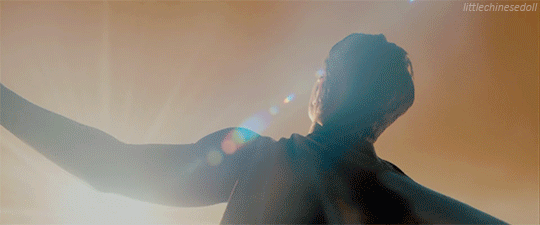
Character Name: Kal El
Alias: Clark Kent // Superman
Age: 41
Face Claim: Brandon Routh
Species: Alien - Kryptonian
Home Earth: Earth-49
History:
Kal doesn't remember much from his time before the Kents found him. His journey to Earth was a blur of nothingness, interspersed with vague memories of the lessons his father recorded in the ship's memory. As far as he's concerned, his history began when he crash landed outside Smallville, Kansas. Being brought up by the Kents was one of the best things that happened to him, on the farm he learned the value of hard work, the strength of family and stong sense of right and wrong. Of course it wasn’t always easy for them, especially when he first began to develop his powers. Learning to tone down his speed and strength when at school -especially whilst playing sports- was one of the hardest things for young Clark. Knowing he was so much more robust than everyone around him weighed heavily on his mind and the fact that despite all his powers he hadn’t been able to save his father, Jonathan, was what sparked him to become Superman.
Kal spent a decade building the Fortress of Solitude and studying there to become the hero he was destined to be. Learning about his home world and the abilities he had been given thanks to his alien metabolism interacting with Earth’s yellow sun. When he was ready to return to civilisation, Kal headed to Metropolis, back in his Clark Kent persona and found employment as a reporter for the Daily Planet. There he meets and befriends Jimmy Olsen and Lois Lane. He falls for Lois almost immediately, but unfortunately as Clark, he doesn’t gain her attention in that way at all. Superman, however, has much better luck, and Lois is smitten by him after he rescues her from a falling helicopter. Kal allows her to interview him in his hero guise and even takes her out for a romantic flight. Lois is the first to call him Superman, and the name sticks.
Kal didn’t only meet friends in Metropolis, Lex Luthor also crossed his path there. The “criminal mastermind” saw Superman as a threat to his masterplan (hijacking two missiles and blowing the San Andreas fault to destroy the west coast) and as such lured him into a trap. After obsessive research, he located a meteor from Kal’s home planet and mined the Kryptonite ore contained within it. Luring Superman to his lair with a phony threat to gas the population of Metropolis, he traps Kal with the kryptonite and throws him into his pool to drown. Eve Teschmacher, Luthor’s assistant, helps Kal escape asking him to stop the decoy missile first to save her mother, who happens to live in Hackensack. Once free Superman diverts the decoy as promised then flies into the earth to fix the break in the fault that the second missile made. Though this stops the major disaster of the west coast sliding into the sea, there are still terrible aftershocks. One causes a breach in the Hoover Dam, and while Kal is busy with this Lois is caught up in another quake, trapped in her car she is pulled into a crevasse and crushed. Overwhelmed by grief and anger, Kal travels back in time by flying faster than the speed of light, reversing it to prevent the dam breach and fixes the fault line to stop the crevasse from reaching Lois’ car. He stops the reversal at the point the earthquake began and flies back to find Lois, who is alive and well. Once certain she is okay, he disappears to capture Luthor and his henchman Otis, delivering them to prison.
A few months pass and Kal settles into his roles as both Superman and mild mannered reporter, Clark Kent. Saving those in need and getting on with every day life in Metropolis. Until he finds out that Lois is on assignment in Paris, where terrorists have taken control of the Eiffel Tower and have threatened to level the city with a hydrogen bomb. Superman flies in to save the day, launching the bomb into space where it detonates. Unfortunately the shockwaves release Zod, Ursa and Non from the Phantom Zone and the three Kryptonian criminals head for the closest planet; Earth. Meanwhile, Lex Luthor escapes prison with the help of Ms Teschmacher and using his alpha wave tracking device, they go north to find Superman’s base. When they arrive Luthor activates the Fortress’ control panel and learns about the three Kryptonian villains who have escaped. He decides to collaborate with them to defeat Superman and take over the world. Clark and Lois are sent to Niagara Falls for a story and while there Lois suspects that he might be Superman. She jumps into the Niagara river, to prove her theory, but Kal remains in his Clark guise (even though he uses his heat vision to cut off a tree branch so Lois can hold onto it). This convinces Lois that he isn’t Superman, but just hours later his secret is revealed when he retrieves his glasses from an open fire barehanded without being burned. after some hesitation, he finally tells the truth and takes Lois to the Fortress. He decides to give up being Superman so he can live a normal life with Lois, despite his Father’s disapproval. A chamber containing the power of the Kryptonian red sun removes his powers, destroying the control panel in the process. He and Lois then sleep together.
Zod, Ursa and Non attack a NASA-Soviet moon mission and head down to Earth where they cause the destruction of East Houston. When the military become involved, they quickly overpower them and demand their surrender. The General refuses, saying his commander is the President, Zod then decides to make the President kneel before him and heads to Washington. Clark and Lois see Zod’s demand on tv on their way back from the Fortress, and the President’s call to Superman for help. Kal realizes that life with Lois can never be, and decides to erase Lois’s memories of all events surrounding Zod’s arrival, including her knowledge that Clark Kent is Superman.
When Astronomers claim to have found evidence of Krypton, Kal builds a new ship and embarks on a quest to find his home world. Once he arrives, all he finds is a desolate, partially destroyed planet, which begins to make him sick. Distraught by what he has seen and felt, he returns to Earth, crash landing back at the Kent farm -his true home. Five years had passed on his adopted planet during his voyage, his mother had almost given up hope of seeing him again, but assured him that though he was the last of his kind. He would never be alone. Deciding to reconnect with his life on Earth, Kal travels back to Metropolis and his old life as Clark Kent, Reporter at the Daily Planet. Life had moved on without him, Lois had a son and had won her Pulitzer, for her article “Why the World doesn’t need Superman”. He attempts to change her mind by granting her an exclusive interview and allowing her insight into what it is to be Superman - hearing the Earth crying out for a savior hour after hour.
Lex Luthor is also free from jail, having been released early, Superman was called as a witness for the release trial, but of course had not been able to attend, so Luthor walked free. The criminal was still obsessed with Superman, and conned a rich woman out of her fortune by marrying her, using the money to fund his second expedition to the Arctic, and the Fortress. Learning all he can about the crystals used to build the Fortress, he steals them from the console and schemes to create an island off the coast of America - once again meaning to use land as a commodity to hold the world to ransom. Lois investigates the power outage caused by Lex’s first experiment, which leads her to Lex’s yacht. She is trapped aboard with Jason (her son) , but manages to fax a sos to the Planet.
Kal (as Superman) flies out to the coordinates she gave, meaning to rescue her, but the aftershocks from the Island’s creation cause havoc in Metropolis and he has to deal with the disasters there before he can get to her. He saves Lois, Richard (Perry’s nephew) and Jason from Lex’s sinking yacht and sends them off in the seaplane Richard used to fly out there. Heading to the island, he walks right into Luthor’s trap, realising too late that the island contains pieces of Kryptonite. Luthor gloats over him in his weakened state, kicking Superman to the floor and allowing his gang to almost beat him to death. While he was trying to pick himself up off the ground, Luthor delivers the final blow, and stabs him in the back with a shard of Kryptonite. Kal defiantly manages to stand, despite the incredible pain, but falls off the island’s edge and into the ocean.
Lois saves his life by pulling him from the ocean and removing the shard of Kryptonite from his back. Though she asks him to fly back to the city with Jason, Richard and herself, Kal knows he has to deal with Lex and his Kryptonite island. He manages to fly the island into space and pushes it out of Earth’s orbit before succumbing to the effects of Kryptonite and his wounds. Falling to Earth, he is unresponsive and the world waits outside the hospital for any sign that Superman is alive. While he is unconscious, Lois visits and explains that Jason is his son. The next evening, Kal wakes and visits Jason and Lois, letting them know he will always be there for them.
A few years later Clark and Lois are married, Kal sharing his secret with her again. Together they bring up Jason who shows more and more superpowers as he grows, just as Kal had.
Positive Traits: Compassionate, Heroic, Benevolent
Negative Traits: Odd, Melancholy,
3 notes
·
View notes
Photo
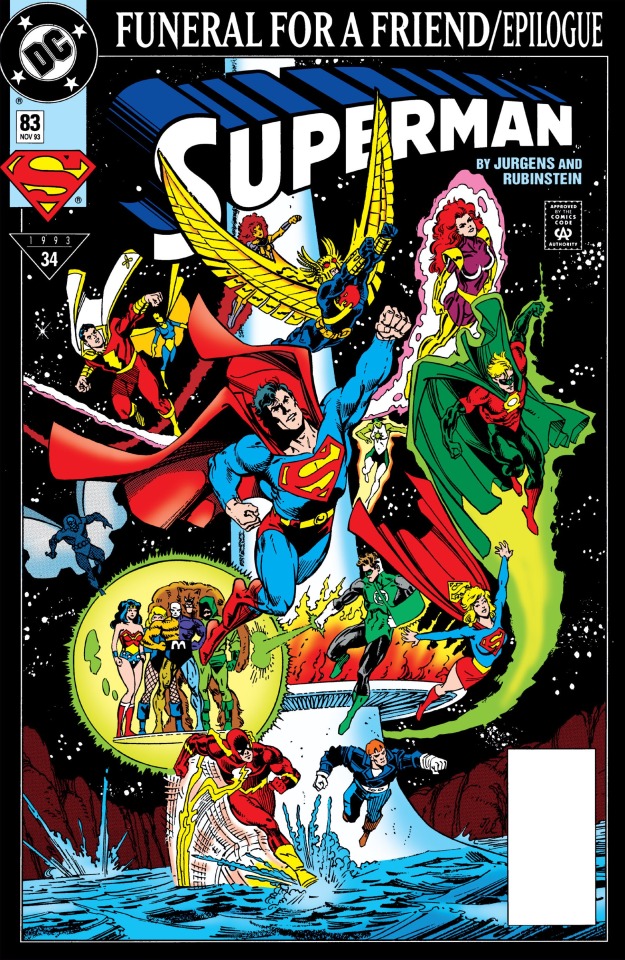
Superman #83 (November 1993)
Funeral for a Friend: uh, that one Green Lantern supporting character who died when Coast City got blown up (Joe? Gary?). In this issue DC’s superheroes pay tribute to the tragedy of Coast City while also deciding what the hell to do with the giant engine that’s now in its place. Weird early ‘90s Hawkman! Dr. Fate with boobs! Already-slightly-psychotic Hal Jordan! EVERYONE IS HERE.

(Nice one, Guy.)
Meanwhile, Lex Luthor Jr. is also sneaking around Engine City, supposedly to prevent it from falling into the ocean and killing some of Aquaman’s friends, but in reality he just wants to look into the Cyborg Superman’s computer to see if he can find a recipe for making kryptonite. As the heroes argue about what to do with Engine City (Hal says drop it into the water, screw the fish), some leftover Warworld aliens start attacking them, like the holdout Japanese soldiers who never found out WWII was over.
The attack precipitates the city’s fall into the water and the heroes have to think fast to prevent a fish holocaust. Their solution is for all the Green Lantern-related characters (Hal Jordan, Guy Gardner, Alan Scott, Alan’s daughter Jade) to “detoxify” the debris with their powers before it falls into the ocean. And it works! These guys should totally open a carpet cleaning business.

As for Lex Jr., he does find the recipe for kryptonite inside the crumbling city, but just as he’s about to write it down (he wasn’t carrying any floppy disks, apparently), Supergirl yanks him out of there to prevent him from burning alive. What an unsupportive girlfriend. Anyway, Superman then takes some of the debris and builds a giant memorial for Coast City’s 6,999,999 anonymous lost souls, and Gary. Sweet Gary. You will be missed.
Creator-Watch:
If the art looks different that’s because this is the first issue inked by Joe Rubinstein, ending Brett Breeding’s classic two and a half year run as Dan Jurgens’ main inker (so classic that it feels a lot longer than that). Breeding will be back for Superman/Doomsday: Hunter/Prey and other stuff, though. As for Rubinstein, Don says: “At the time, I had trouble with the transition, being soused to Brett Breeding’s finishes over Jurgens’ pencils, but looking at it now, the art looks great. It doesn’t look as smooth or blocky as Breeding’s finishes, but Rubinstein’s hatchier style serves Jurgens pretty well, even if it takes some getting used to.”
Plotline-Watch:
At the start of the issue, Superman goes to pick up Batman to take him to Coast City, only to find him wearing a different costume, acting differently, and sounding like a different guy. That’s because that’s not really Bruce Wayne in the suit anymore, but the replacement he got after Bane broke his back. That’s right: freakin’ Psi-Phon and Dreadnaught.
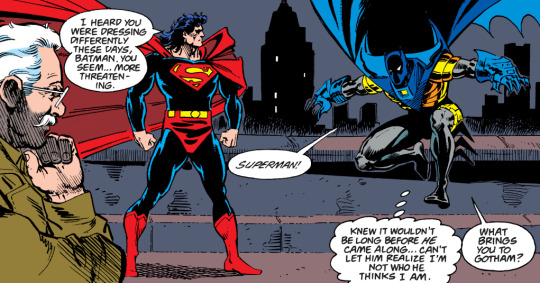
Superman gives a speech about how superheroes must work together to prevent another tragedy like Coast City from happening, but when Guy asks him if that means he’s going back to the Justice League, he’s like “uh, not yet.” Wisely, he’s gonna wait for Grant Morrison to get there first.
Hal Jordan’s characterization in this issue is interesting. In Green Lantern #47 (which came out the same month), he’s bummed about Coast City but still hopeful and serene, while here he’s already going Parallax on us. Wonder if Dan Jurgens knew more about what DC was planning for Hal than the other comic’s writer.

There’s a cute scene where Superman is flying by Kansas on his way to Coast City and quickly drops some flowers for Ma Kent. (That, or Flash picked this moment to hit on a random older woman.)

Former TV exec/crime boss Morgan Edge has released an autobiography where he trashes the Daily Planet’s Cat Grant for using her sexiness (and, you know, sex) to get dirt on him and send him to jail. He also accuses Cat of being a crappy mother to her son Adam. He kind of has a point there, because what kind of mom would let her kid play with an Atari in the early ‘90s?! The SNES and the Genesis were already out!
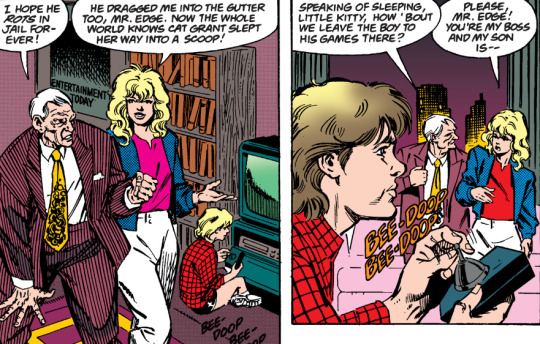
Believe it or not, Morgan Edge’s pervy dad in that screenshot above isn’t the creepiest thing in that scene. Don: “Very spooky how the guy dangling outside of Cat’s apartment goes without mention. An ominous foreshadow of one of the very few missteps of Jurgens’ run.”
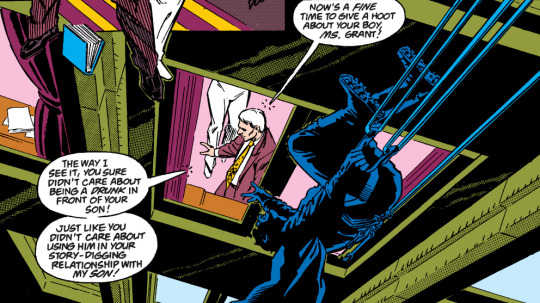
But the most ominous part of the issue is at the end, when Clark Kent accepts Jimmy Olsen’s offer to become roomies, since Clark lost his apartment on account of being dead and all. Don wants you to know that “Jimmy is still in that towel by the way” in the scene below. I hope.

Patreon-Watch:
Shout out to our patrons Aaron, Murray Qualie, Chris “Ace” Hendrix, britneyspearsatemyshorts, Patrick D. Ryall, and a warm welcome to Samuel Doran! Last month our patrons got to read an article about Superman’s bizarre first Elseworlds appearance ever, the Kamandi: At Earth’s End miniseries, and got a veeeeeery early look at this post you’re reading right now (since Don finished his part way before I did mine). Right now I’m preparing this month’s Patreon-only article, which involves Superman wearing pointy ears and Luthor wearing make up. Find out more at https://www.patreon.com/superman86to99
Oh, and in case you missed it, we’ve been posting Don’s new commentary for older issues on the Patreon as free posts (click above and scroll down to see them). EVEN MORE from Don after the jump!
Art-Watch (by @donsparrow):
Another classic issue, and such a nice wrap-up to the "Death and Return" storyline (as well as being a much-needed check-In on the DC Universe at large). We start with the cover, and it’s a very good one, letting the reader know right away that it’s a big team-up issue. (It also is a real showcase for 90s costume design, and how weird the JLA lineup was at this point).
The opening splash is a neat image of a rarely seen pairing, Superman and Commissioner Gordon. Jurgens draws James Gordon a little heavier and more Pa-Kent like than I’m used to seeing him, but it’s still neat to see him interacting with Superman. A page later, we get another rare pairing—the returned Superman with the imposter Batman, Jean-Paul Valley. The tension in the interaction between “AzBats” and Superman comes across well in their exchange, as does Superman’s doubts about who he was really speaking to.
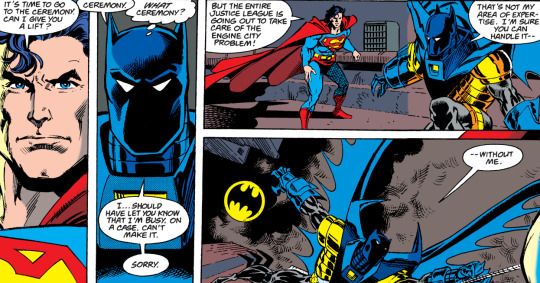
It’s a dreamy looking Superman crossing the country from Metropolis to Coast City, and I daresay that they’re trying to channel Dean Cain a little as he approaches Kansas.
The best panel of the issue though is the two page spread of all the heroes gathering at the wreckage of Coast City, and there’s so much to love here. The body language, and facial expressions speak volumes about each of the characters: Superman looking swashbuckling and upbeat, Green Lantern brooding like a man barely holding on, Green Arrow all attitude and shadow. Just a great spread.
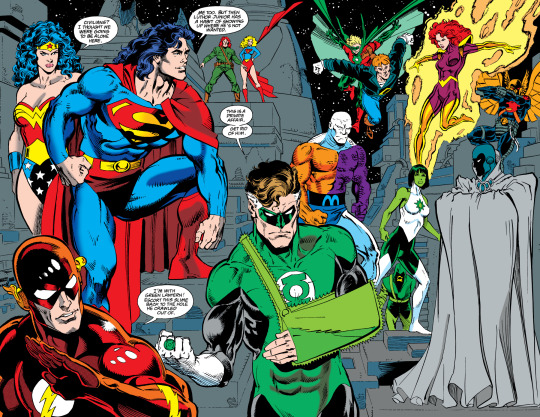
Another cool image is Aquaman showing up late, and emerging very royally in protection of his ocean (undercut masterfully by a legitimately funny couple of lines from Guy Gardner). Page 14’s Hal Jordan is a great drawing, and this whole storyline seems like a table setter for the "Emerald Twilight" story coming up.
The sequence of a firelit Luthor at the computer is a good look at his madness, but it does beg the question of just how little Supergirl seems to take in. He was JUST talking aloud about Kryptonite, and she emerges seeming not to hear. The image of Supergirl flying Lex away as he struggles against her psychic grab is a good one, even if her uniform is depicted as a little clingier than I imagine it to really be.
Superman floating above his obelisk with his arm in front of his face like Dracula is a cool look, even if it is a little dramatic.

Lastly, the image of Clark turning up the stereo is a good one, even if his hair length is wildly shorter here than in Coast City (and I usually dislike it when they mention real world bands, as it comes off trying too hard to be hip).
STRAY OBSERVATIONS:
I have to love how meta it is to have Superman outright saying that Batman is dressing more “threatening” these days, on page 2. I guess he couldn’t come right out and say “you have an extreme new look, and it’s totally badass! Batman the next generation!”
Last we saw of Supergirl she was storming out of the party on Lex’s Zeppelin after Lex II was getting all horned up at the sight of Lois Lane, but it appears here they’ve mostly patched things up as they fly to Coast City.
More meta-stuff: Jimmy clunkily complimenting Lois on her new hair by saying she “oughta be on TV or something!”. This whole exchange is very expository, really, “Clark must be pretty mad… though he’s busy worrying about where he’s going to bunk…” Anything else to get in there, Jimmy?
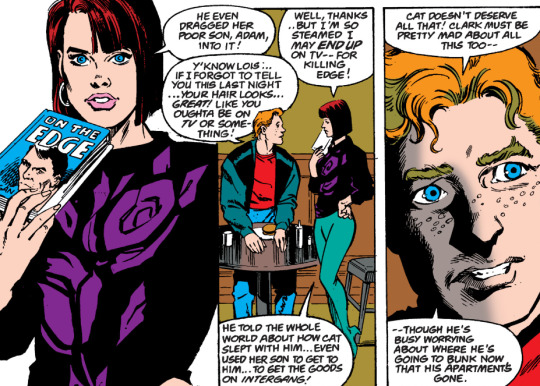
The harshness some of the heroes have for Lex Junior seems a little out of place, especially since he’s still known to most of the heroes as an ally from "Panic in the Sky", and the "Doomsday" storyline. Superman’s comment was borderline, but where is all this anger Flash is showing coming from?
Being as familiar as we are with these writers, there are certain phrases or ideas that a certain writer will go to way, way too often. Byrne had a number of stories where Superman would “ionize” something with his heat vision, and it occurred to me that maybe he just liked that word. I would submit that Dan Jurgens likes the word “atomize”. It was used by the Cyborg Superman when talking about Doomsday, and is used a bunch just in this issue.
I find it hilarious that Hawkman appears so prominently in this issue, but doesn’t get any lines. This issue is an interesting time capsule—I had almost forgotten about the de-aged Starheart powered Alan Scott era.

Speaking of lines, they don’t give Captain Marvel much to do in this issue, but I always like seeing him, even if his only contribution is the odd “Holy Moley!”
Colouring error on page 12, where Hal’s ring has a red centre (maybe the colourist had Alan Scott’s red and green look on the brain?)
A raging Hal standing by Green Arrow is a sad foreshadowing of their confrontation to come in Zero Hour.
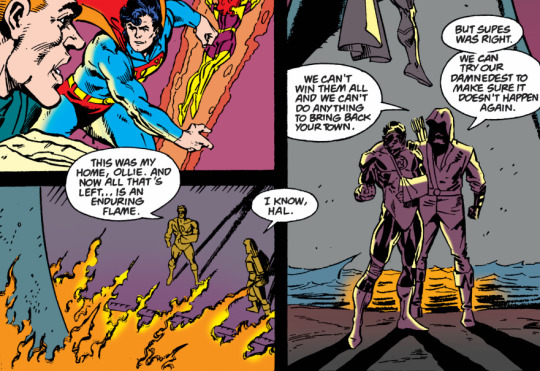
#superman#dan jurgens#Joe Rubinstein#jim gordon#batman#supergirl#morgan edge#ma kent#vincent edge#cat grant#adam morgan#toyman#hal jordan#aquaman#guy gardner#justice league#maxima#hawkman#flash#green arrow#new teen titans#wonder woman#metamorpho#jade#obsidian#dr. fate#captain marvel#coast city#van halen#flash loves gilfs
16 notes
·
View notes
Text
Super Heroes are a HUMAN power fantasy Part 2
Super Heroes are a HUMAN power fantasy Part 1
Master Post
There were several points a bit more tangentially connected to my arguments in part 1. As a result I decided to leave them until now and hit them up in bullet points.
These are arguments against the superhero genre chiefly perpetuated by the tryhard trinity of Osvaldo Oyola , J. Lamb and Noah Berlatsky.
On the topic of the genre portraying ‘might making right’, the truth is this is part of the ancient inspirational aspect of these figures and can be found in stories like Rama and Sita, Rama of course ultimately never giving up his quest to be reunited with his lover. Which was not a Western influenced story.
Yes the genre involves ‘punching as conflict resolution’. I’m sorry, but that is part and parcel of the genre and the wish fulfilment/fantasy/narrative entertainment value of the stories. If you DON’T like that then frankly it’s like complaining that a romance story involves kissing.
It has been claimed that a black hero wouldn’t punch someone but again, the genre is entirely about people with powers using them to help people by preserving their life. And if they have no other choice but to K.O. a mugger who’s going to stab someone then a black person, or any decent person, would/should do it. But examining the meaning and repercussions of that realistically given the fact that they aren’t white in a white society is something that could benefit the genre.
A common critique of the genre is that crime happens sometimes because of a racist system, therefore fighting crime innately supports racism. Look, obviously we should remove institutionalised racism from the law. At the end of the day though if someone of any race is committing a crime which HURTS people they should be stopped, the reasons which drove them to that should be taken into consideration, but Spider-Man shouldn’t NOT stop a mugger because they’ve been driven to do that through desperation. There is often no time for that and without being able to talk to or trust strangers he or other heroes need to act in the moment.
Superhero fiction on one level is childish, but on a deeper level they’re representative of universal truths and desires which are often boiled down to fairy tales or simple stories. The above shitheads also claims that superhero fiction is written and consumed by children, when the truth is that in the last 20-30 years the opposite has been more true. THAT is partially why sales have been dwindling over the years.
Superman’s values are innate to the heroic and altruistic desires and ideals ALL humanity has expressed throughout its history. They are not inherently ‘white’
Apparently superheroes are white constructs because they reinforce the ‘status quo’. To quote the Atlantic article (see part 1) again:
“What status quo do superheroes reinforce? These heroes fight because everyone is entitled to life, liberty, and the pursuit of happiness. The only fascists here are the supervillains who disagree.”
Also Superman, Batman and Wonder Woman were created specifically to change the status quo of the fictional worlds they were created in. At the same time the entire Marvel pantheon were about changing the status quo of the genre by introducing people who were flawed and different and more human than the DC heroes
Superheroes, despite the assertions by the above fuckwits have at times interrogated the justice system. But generally their lack of interrogation is I think for the same reason their science is so wonky. They don’t know better. They just boil it down to the simplest terms. Muggings and villain threats abound. Hero prevents those. They don’t know enough to tackle something much deeper than that. This ties into the fundamentally flawed aspect of most critiques wherein they are looking to superheroes as intellectual pieces of academic and critical study when...that’s not what they are...at all…
One of the above douchebags once said:
An African American Superman, with kinky, close-cropped black hair, thick, half-reddened lips, high cheekbones, and wide nostrils all bathed in dark Lindt chocolate, resists White supremacist logic, negates Black inferiority mythology, and threatens the established order. Superman’s disconcerting physicality, tempered by his omnipresent cheerfulness calmed and invited White comic readers to imagine themselves as gaudy Caucasian perfection, the Anglo-Saxon ideal. Static in panel, without speech bubbles or thought balloons, Superman Black warps the absurdly developed skeletal striated muscle and eternal hopefulness fans rejoice into a clear and present danger to the American experiment, an unholy figure derived from Tea Party paranoia, Barack Obama’s calculation and Terry Crews’ musculature. Public Enemy’s prescience abounds – were Superman Black introduced on the game-changing Action Comics’ cover, White America would have yet another reason to fear a Black planet.
This entirely depends upon who is doing the perceiving. To someone of a different mindset a Black Superman could be just that. The same thing Superman is except he happens to have black skin.
Also, the author needs to take a major chill pill, Jesus Christ.
Here is another quote from one of them:
Only in White male power fantasies can people blessed with skin privilege and bodies carved from living marble wield heat vision or super speed or unbreakable claws against indigent criminals from broken homes who lack high school educations.
This is again grossly incorrect because the idea of individuals having superhuman abilities and using them to fight criminals predates American society, and if one accepts figures like the Hydra to be stand-ins for threats to human life then the superhumans have been fighting what the criminals represent for eons before the advent of American society. The criminals they use their abilities against are rarely stated to lack education or come from broken homes, but yes okay let’s say that they are that.
Having super humans go up against them and defeat them isn’t a white male power fantasy because their abilities are used to subdue and NOT kill. Injure perhaps but in real life sometimes force is sadly necessary and if someone is robbing a bank or holding a gun to someone in an alley it is justified no matter what skin colour anyone involved in is, or what society you find yourself in, for the perpetrator to be stopped in order to safeguard life. Just because the perp resorted to what they did due to social ills beyond their control, that doesn’t justify their actions at that moment. Stealing someone’s money or trying to murder them is never ever going to be acceptable no matter if we live in a white society or not.
Only in White male power fantasies would women display abundant porcelain cleavage or don starry microskirts to fight crime.
Yeah um, preeeeeeetty sure that actually that’s more of a male SEXUAL fantasy and less than a WHITE male POWER fantasy. That was never the topic of conversation.
Shuttle diplomacy or natural resource husbandry rarely bring metal-faced technological sorcerers to heel in superhero comics; superheroes often save planet Earth through fantastic violence judiciously applied.
Yeah, that’s part of the narrative FANTASY element of the genre that is intended to be escapist. Condemning it for being otherwise is asinine.
More than this, guess what, there are people whom Dr. Doom is a metaphorical stand-in for. And an awful lot of them legitimately can’t be negotiated with. I am of the belief that in the REAL world we should negotiate and use force when there is no other choice and even then only use what is necessary. But the Dr. Dooms and Lex Luthors of the comic book world represent grander themes of evil and social ills, whilst at the same time existing to challenge the heroes physically and mentally. They represent the unmovable types of evil that legitimately can only be dealt with via physical means.
This was the type of circular logic I talked about before. It is looking at the villains as stand ins for EVERY type of situation and therefore the super hero’s use of violence as ‘problematic’, when in reality the superheroes’ use of violence isn’t problematic because it is justified by the extreme circumstances they find themselves in.
Because those situations don’t exist in real life...like in World War II...which was literally about people using force in the face of failed negotiation to halt the advance of fascism…
I submit that the superheroic reflex to subdue evil with violence directly descends from Thucydides and Alexander, from Richard the Lionheart and Dwight Eisenhower.
Yeah...except it isn’t. Again...it came from the same place as Hercules and Sun Wukong, and those came from the natural human biological imperatives to survive.
Superheroic morality requires Western Civilization’s literary canon and political history to justify its callous disregard toward collateral damage. To be clear, superheroes routinely consider innocent noncombatants’ lives (if not their property) when they confront cosmic despots or sociopathic steroid abusers, but comics document the never-ending battle in colorful tomes largely sold after Nagasaki and My Lai, after the time when total ignorance of American military supremacy was vogue. When Wally West as the Flash pulls a hysterical single mother out of her overturned silver 2001 Honda Civic and carries her to safety from Apokoliptian cannons at breakneck speed, comic fans favorably regard his heroism; any dialogue from the frazzled thirty-something file clerk will remind readers how grateful she is to escape otherworldly horror with her life. Superhero comics don’t care about the destruction of this woman’s sole transport; when the gas tank explodes behind the Flash’s blurred strobe, this woman loses her credit cards, her driver’s license, her insurance documents, her six-year-old daughter’s vanilla birthday cake with its beloved artificially flavored strawberry icing. The comics don’t recognize the heroism of this brave woman’s seven-month struggle to rebuild her finances and maintain her identity following Darkseid’s incursion; all we know is for that poor woman, the Flash saved the day. He’s a superhero. Isn’t she grateful?”
Collateral damage and the disregard for it IS regarded. Hence the existence of Damage Control. Furthermore, that is AGAIN part of the escapism and fantasy element of it. THAT is the suspension of disbelief element of superheroes and taking it THAT realistically and criticising it for it is frankly just mean spirited and simply looking for an excuse to hate it.
Furthermore the reason the rescued woman isn’t focussed upon is because it’s not HER story. If you write a story about a protagonist THEY are your focus. Everything is for their benefit. That’s true of older non-white folktales as well.
And yeah readers are supposed to regard the Flash as heroic and the woman grateful because her kid’s birthday cake isn’t realistically as important as her life!!!!!!
This is criticising superhero fiction for being unrealistic even when it is being actively so The woman WOULD probably be grateful that she’s not fucking dead!
I wouldn’t mind seeing the survivors of something like this try to rebuild their lives. And superhero fiction has focussed upon that from time to time, but again...that’s not the point of the story. Criticising the genre fro this is like criticising Harry Potter for having the audacity to focus more upon Harry’s trauma in the wake of Cedric Diggory’s death than his parents’. Harry is the star. He gets the focus.
Superman is a White boy. Superheroes are White people. Superhero morality exacts the Melian Dialogue’s ‘might makes right’ overwhelming force realpolitik with every onomatopoetic Biff! Bam! Pow! gut punch and karate chop combo.
See what I’ve said before about how superheroes are not fascists and how force is often necessary
There exists no genetic propensity for group violence in the human genome. None.”
Er....yeah...there kinda is...that’s part of why wars happen.
racially-informed vigilantism.
This phrase in one of the articles itself sums up it’s own contradictions. Racially informed vigilantism is just one type of vigilantism, a type the superhero doesn’t subscribe to. A superhero would sooner join the likes of the Joker than the KKK style vigilantes and would be all too happy to apprehend them.
One of the articles seems to be conflating basically ALL criminals super heroes fight with people who’re labelled criminals due to racial profiling. Yes superheroes operate to an extent like police officers but you can’t truly complete the analogy whatsoever.
Few of them have legal sanction, which is partially why so many refrain from actually killing anyone as officer’s are allowed to do under certain circumstances. More than this when they take down criminals their methods are entirely different from regular cops. Apart from very loud and overt super villains who may or may not be on a rampage, most of the time when they tackle regular criminals it’s due to them either being informed of a crime that is going to happen (like a hijacking or something) or they literally see something happening whilst on patrol. They don’t profile people beyond what their super sensory abilities or logical observations tell them. Which is to say if someone is following someone else a little too closely then maybe, just maybe they are planning something. If their Spider-Sense or super hearing or something alerts them to something they will act.
Taking that, ignoring it, and then supplanting the superhero for a regular cop who would racially profile people and/or supplanting the criminals they tackle for racial minorities because those are the people who (stereotypically in the real world) would be targeted as criminals is very inappropriate. Not least of all since superhero comics obviously don’t present a wholesale realistic depiction of the real world so what they present isn’t entirely interchangeable with that. And what is more, erasure of minorities was so prevalent that overwhelming majority of all the criminals they ever encountered were themselves white, so again exchanging those for racial minorities who’re profiled as criminals is highly questionable.
It’s all just such a MASSIVE reach!
But I think the panels also work to point out that Miles himself “does not belong” in the superhero tradition. He, like most black and brown superhero characters in mainstream comics, is an outlier. In other words, people like Miles or Trayvon are unfortunately more likely to be victim of a “heroic” vigilante than to be one.
This is conflating the superhero vigilante with the majority of real world vigilantes who are overly violent (and frequently hard conservative) individuals who do take overly simplistic views of the law and use those to profile people. And it’s doing so whilst taking superheroes too literally, bringing their own personal interpretations to the mix and then overlaying them onto the superhero concept before finally accepting it as fact.
Police officers use violence against racially profiled people who exhibit unrest due to a societal system stacked against them. Well shit, Batman punches the Joker. It must be the same thing obviously!!!!!
Look. Without our stories, without the true nature and reality of who we are as people of color, nothing about fanboy and fangirl culture makes sense. What I mean by that is, if it wasn’t for race, X-Men doesn’t make sense; if it wasn’t for the history of breeding human beings through chattel slavery, Dune doesn’t make sense; if it wasn’t for the history of colonialism and imperialism, Star Wars doesn’t make sense; if it wasn’t for the extermination of so many indigenous nations, most of what we call “first contact” stories don’t make sense. Without us as the secret sauce, none of this works, and it is about time that we understand that we are the Force that holds the Star Wars universe together. We’re the Prime Directive that makes Star Trek possible. We are… in the Green Lantern Corps? We are the Oath. We are all of those things. Erased, and yet without us? We’re essential. This is an incredibly important project, because it puts front and center, not only a community that has long consumed and given power to these practices and consumer categories, but it’s a community without whose suffering and struggles, none of [these narratives] would make sense.
I agree with a lot of this but there are some problems with it.
a) X-Men makes sense also because they are a stand in for almost ALL marginalised groups. Racial minorities, disabled people, queer people etc.
b) Actually Star Wars makes complete sense with or without colonialism or imperialism, at least the kind which directly relates to the issues of racism. Imperialism, conquest, these are things which are much older than American society, dating back to even before Ancient Rome. It’s about freedom fundamentally and freedom is a desire shared by ALL human beings innately because at the end of the day we are animals who wish to be free and not caged. Being caged metaphorically within a tyranny is thus something we abhor
c) The Star Wars universe doesn’t begin and end with the story of imperialism. It’s about how Democracy can be turned into an dictatorship and how that has to be prevented, or re-addressed once it happens
d
When white comics readers claim that they did not need white characters to relate to and enjoy comics (as a way to argue against positive race-bending), that point to their love of Luke Cage or Spawn as evidence of their ability to enjoy characters across race, what they are failing to note is how black, Latin@, etc… identities in the superhero genre are framed by a system of white supremacy.
Again I don’t understand this one. I as a white reader can enjoy Luke Cage rescuing someone from a burning building because doing that is part of white supremacy????
It presumes a white power fantasy is inherently different to a black one. But the power fantasy element of the superhero relates to them having powers and using them to help others and defeat villains. A power fantasy by another race would still have that because it is inherent to the human power fantasy. Non-white power fantasies would logically have all that and more!
Much like Noah Berlatsky explains in his book Wonder Woman: Bondage and Feminism in the Marston/Peter Comics, 1941-1948, part of what made Marston’s original Wonder Woman stories so wonderful, was his expectation that girls and boys would identify with the heroine, to value and idealize her compassionate strength and victory through submission, rather than through cyclical and ultimately futile fisticuffs of male dominion.
Many female readers enjoy the action scenes. Action scenes are good because it enables us to have a healthy outlet for aggression without taking it out into the real world. It is also NOT an inherently male dominion thing. Again this is THEIR projection. Fighting and violence is innate to human beings because we are animals biologically programmed towards it for the sake of survival. That goes for males and females. Furthermore far from fisticuffs just being about male ‘dominion’ the Wonder Woman, Batman and Superman comics were a reflection of impending war. A war that sadly required violence to be solved. That’s what the superhero typifies. Wish fulfilment action in situations where violence was (usually) a necessity. Diplomacy is good and should be our first resort. In life though sometimes things do come down to necessary violence.
There are many ways to craft a racial minority superhero, but if we consider racial authenticity as a foremost concern, today’s Hollywood is simply not prepared for that intellectual labor. The real diversity conundrum isn’t how to include the minority metahuman in the existing comic framework; that’s an art project, a casting decision solved by calling Michael B. Jordan’s agent. The real question is how to write that superhero in a way that moves the medium forward, past the Reaganomics antiheroes of Alan Moore and Frank Miller and past the hyper-emotive Silver Age redux of Geoff Johns and Brian Michael Bendis. Respectable, authentic diversity in superhero comics should redefine the nature of the meta-protagonist to his powers and his audience, with exhaustive attention to cultural detail. I’m not convinced that a Black superhero would wear tights. I strongly doubt that a Black superhero would solve conflicts with his fists. The Black superhero knows that his community watches him religiously, and that any false move will have public repercussions he cannot expect or control. If anything, the Black superhero template plays out on our nation’s cable news channels at all hours. President Barack Obama, with all his clipped vocal inflections and measured language and natural equivocation and faulty dealmaking and perfect family and limitless patience is the closest public figure to a Black superhero America has yet experienced, an international celebrity unthinkable before his ascent. Watching President Obama today, one feels expectation crush into his bones like a gravity well. No matter the political stimuli, Republicans oppose him. The concept of the Obama Presidency struck American conservatives like a Bernard Hopkins’ kidney punch, and in return, President Obama absorbs the vitriol of our coarse public debates more than any President to date (and progressives never tired of calling his predecessor a National Socialist). The agony and the ecstasy of Grant Park has given way for many Americans to the sobering fact that American authority, her global military supremacy and international economic primacy, is controlled and represented by a Black man. Disliked, hated, or worse, the Establishment is Black. I need the Black superhero in print and/or on-screen to reflect that paradigm shift. Superheroes in the popular imagination are Establishment figures; if the Black superhero I’m presented can’t interrogate what it means when the Establishment is Black, of what utility is her story?
A minority hero wouldn’t wear tights or punch people...why?
What do tights have to do with anything? As for solving problems with his fists this is conflating the threats superheroes face with ANY threat, when they are almost always situations which legitimately do require necessary physical force to resolve. If the black superhero patrols an area and sees someone about to stab someone else, yeah he should punch the stabber to save the innocent person if there is no time for anything else.
This is basically asking for the core foundation of superheroes (which transcends racial constructs and is innate to human wish fulfilment and mythic tradition) to be scrapped in favour of something else entirely. Barrack Obama isn’t a superhero. He is many, many things but what Mr. Lamb here is asking isn’t so much for a different template but for something just wholesale different. He doesn’t actually WANT a superhero story in the first place!
Super heroes aren’t establishment figures. Superheroes don’t uphold the law regardless. They uphold the law in so far as a greater need to safeguard innocent lives. Conflating them as inherently establishment figures ignores their origins and over literalises what they do.
At the same time the utility of their story is first and foremost as a story: to entertain and inspire.
It is inherently worthwhile for a little black kid to sit down and open up a comic book where someone who looks like them is being a good person, is helping people, is defending the weak. I agree that minority heroes shouldn’t just be white heroes who happen to have different skin colours. I think they need to reflect the realities of what it means to be black or Asian or Pakistani in white society is necessary and a superhero should do that and should have that inform how they interact with their powers. It doesn’t mean the whole genre needs to abandon what it fundamentally is or that those minority heroes should not do the things a superhero fundamentally do.
Ultimately, yeah these characters were created within a white context, but my point is fundamentally the same thing was created in non-white contexts as well throughout history.
Super Heroes are a HUMAN power fantasy Part 1
Master Post
#Osvaldo Oyola#Noah Berlatsky#Marvel#DC#DC Comics#Marvel Comics#Super Heroes#Superheroes#Wonder Woman#Robin Hood
12 notes
·
View notes
Text
All-Star Superman #2
A scant year to the day since part 1!
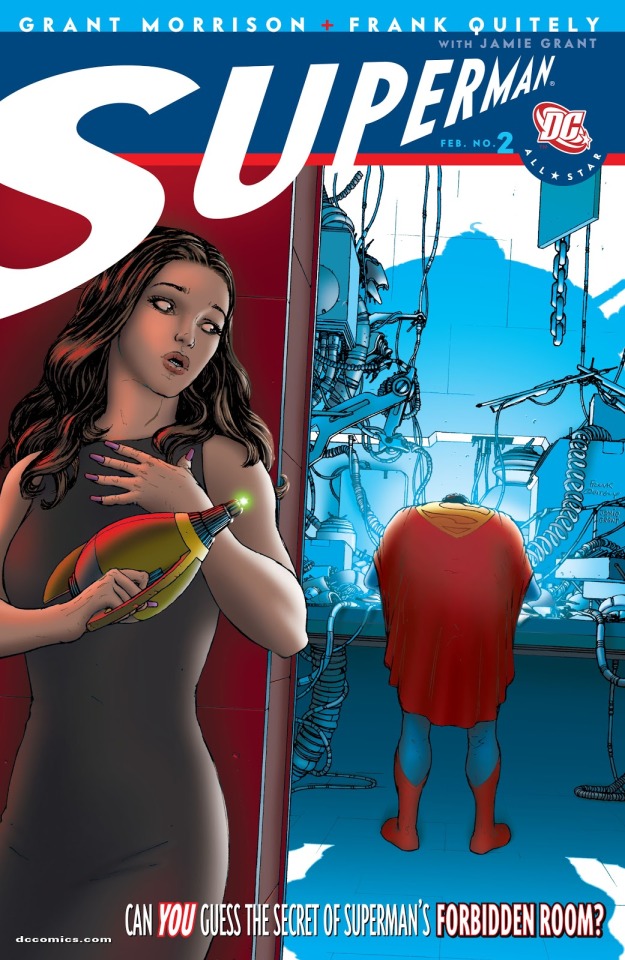
All evidence to the contrary I actually have always wanted to go back to this, especially since I keep getting asked if I’ll do so and it stirs my omnipresent sense of guilt over my lack of productivity, and also the last year has not resulted in a mass turnaround of people realizing it’s a for-real good book and not just comfort food so this remains necessary. This isn’t going to be quite as in-depth as the first go-around - both that as the introductory issue and that as the introductory recap had a lot of groundwork to lay - but still plenty to cover, as this issue sets up Lois and Superman’s arcs for the series, which is rooted (amazingly, especially right off the bat, given the book’s reputation of being about how amazing Superman is) in how badly Superman’s let his fears and shortsightedness poison the most important relationship in his life.
If the first issue is the big classic Superman material - Superman saving the day from the monster! Lois and Clark and the rest of the Daily Planet crew! Lex Luthor’s sinister schemes! A ticking clock to doom! - this scales all the way down to the uncomfortably, stiflingly intimate. Classic archetypal Superman stuff gives way to the most Silver Age issue: casual huge ideas, relationship drama, misunderstandings, last-minute reveals that recontextualize the entire issue, and baaaarely latent psychodrama bubbling up at the edges. In service of that the visual framing here is not unlike a stage play, a limited set of physically connected locales as a pair of figures bounce off one another. Quitely and Grant’s work is therefore comparatively subdued next to issue #1, keeping to traditional panel layouts and wide or medium shots with a background color palate of mostly blacks and whites and grays with a handful of other colors popping out...until Lois starts to lose her shit at the end of the issue and we get close-ups and full black and white panels and eerie glowing and dutch angles and that unsettling abstract image of her clenched teeth, as the story starts to squeeze us like Lois’s gut.
She’s right to be unsettled for that matter; she’s alone on Superman’s turf (the one issue where that’s the case other than #6, and that one’s about how Smallville stopped being his home), the weird antiseptic alien lair of the ultimate super-hobbyist, and all the baggage of their relationship is spilling out into the open as she has less and less reason to think the best of this odd man who’s been lying to her for years. Unlike the Silver Age tales this is referencing, she’s absolutely on the money with her complaints about him: he’s been dicking around with her forever and thinks it can all be okay now (His little “What?” on the second page when she bursts his bubble says it all), and he’s awkwardly overcompensating trying to fix it.

While the Fortress tour serves to peacefully acclimate us to how utterly bizarre Superman’s world really gets past the traditional rescues (the little cubic starfield we don’t know the meaning of yet, trophies are floating rather than physically suspended, the glowing flowers in Lois’s room, “The Phantom Zone map room’s pretty dull unless you can see radio-negative anti-waves”), Superman himself is...humblebragging isn’t the right way of putting it, but it feels like he’s working way, way harder than he ever will again in this book to be cool and impressive and assuring. He’s a dope in love, but he can tell something’s up and that super-brain of his isn’t putting the obvious pieces together, or noticing that this is just putting her off further and further until, like Bluebeard’s wife before her, she stumbles through the threshold of the door she was never meant to, even of course in the end he’s still Superman and there’s a perfectly good reason. Not a good enough reason, however, for her accusations at dinner to not hit home - his mind may be expanding, but he’s still way up his own ass here in a genuinely unpleasant way that’ll be elaborated on momentarily. For now he’s left stammering that she should trust him and it’s limp and phony, especially compared to his big entreaty for someone to trust him in #10 (which’ll be right after he finally comes clean with her); while Superman may not be considered a savior figure by his friends in here the way he often is in the mainline comics Lois seems to be the only one who doesn’t look up to him at least a little bit, but that clarity means she’ll call him out where no one else will.
Across the next two pages it’s all laid out, and we get to the roots of where things have gone wrong between the two of them. Lois is paranoid, certainly, the panels are literally squeezing in on her, but with Superman seeming so out-there and alien like never before she would have every right to be even sans alien chemicals. But notably there remains throughout a part of her assuming the best of him wondering if maybe this is just another big misunderstanding or that he’s simply been mutated by the solar overexposure. And in her heart of hearts, she admits that maybe she wants this to be another big damn trick with a completely sensible justification, because the alternative is that this is the new normal and she has to accept that he’s a flawed mortal man. It’s ugly and it’s mean - especially since she likes Clark - and it’s human as hell in the worst, most understandable way. It’s not going to be until said mortality is staring her in the face that she’ll be able to accept it.

Superman, meanwhile...someone could write a thesis on these panels as an articulation of the Superman/Clark dynamic. The Mirror of Truth is actually preexisting, centerpiece of a Jerry Siegel/Curt Swan joint in Action Comics #269 that was later adapted into the Superman newspaper strip where Lois uses it to figure out Superman is Clark Kent until he tricks her into believing the mirror can lie, after which he tosses it in a volcano; here it’s survived, and curiously shows him as Superman rather than Clark, when in the original tale it displayed Kent even though that was fully the era of Clark as a disguise. In here too it’s Superman who’s the ‘true’ identity of the two and which this time is reflected in the mirror, yet as in #1 it’s Clark who says what he’s truly feeling. In that light, the final panel of the abandoned glasses reads like nothing so much as Superman using the mirror as affirmation that the truth of the solemn, steadfast Superman identity gives him licence to deny the uncomfortable emotions his squishy human farmboy side is dredging up, ‘lying’ to him in a way he had to fake in the source material. Those emotions however knock right on the door of what he can’t grasp here: Clark’s so wrapped up in his own head trying to do the ‘right’ thing that he’s overlooking how his attempts at self-sacrificing selflessness are hurting the people around him. Throughout the series he’ll come to rely on others, first at his lowest points with Jimmy and the Bizarros, until at last he comes to invest true trust in Lois, and the Kandorians, and Leo Quintum, and even Lex.
For now though Lois is deep in a hole, a brief but memorable meeting with the Unknown Superman of 4500AD - everything Superman seems to be becoming to her even before she wonders if it’s literally him, cryptic and masked and with a big ‘ol question mark right on his chest instead of the familiar comforting logo, even his gutbuster of a question reinforcing his distance from a recognizable human experience - leading her all the way to reimagining her Silver Age ideal happy ending of marriage and family with Superman as a Cronenbergian horror. It’s still a Superman story, it turns out he had the very best reason possible for wanting to keep her in the dark, but right through to the end he remains just a little condescending in his reassurance, and his gift of essentially bringing her up to his ‘level’ isn’t going to solve the problem. While the next issue lets us see the two of them properly in love, it won’t be until the elephant in the room comes out that they can come to terms.
Additional notes
* God Quitely is so good. Look at the way the seatbelt curves in the first panel! Lois’s bemused little disbelieving smirk!
* Pages 2-3: Aurora Borealis?!
* Lois is the only character other than Superman who gets to have actual narration (in both cases as looks at their in-text writing), the only one whose viewpoint is thus privileged in the same way as his.
* The key is the realization of this series’ aesthetic in a nutshell: the old-school idea in a sleek, shiny, clever new way that doesn’t take away from the fantastical toyeticness of it all. For that matter, the key is the centerpiece of a later bit with Superman that could be fairly described as the long-term goal of the book book as Morrison’s hoped-for perennial: “One day some future man or woman will open that door, with that key. When they do, I want them to know how it felt to live at the dawn of the age of superheroes.”

* This is A. The first note of a larger DC universe existing offscreen, something that I’ll go into more when discussing #8, B. A brilliant, concise, fun little summation of his place in Superman’s world, and C. Absolutely hilarious given Morrison suggested in his exit interview that this could be seen as much later on in the same universe as All-Star Batman & Robin The Boy Wonder, which entirely rewrites the tone of that moment.
* Already discussed the key but the muscles in Superman’s hand tensing a bit at picking it up is another great detail.
* The glimpse of the Fortress here is excellent: the statues of his friends and enemies instead of pictures because he does things bigger with the yellow electric something crackling at the end of it, the off-model but curious-looking robot appearing to glance at Kandor (are it and the bigger robot with the seats on top of it trophies, or Superman Robots with different designs tasked for specific purposes?), the classic Bad Penny Good For One Crime, the Legion time bubble that establishes his time-traveling credentials for later, the Titanic where he and Lois will dine when their relationship hits a proverbial iceberg, and most strikingly the space shuttle Columbia, his apparent rescue of which I have to imagine is a reference to Astro City’s Superman analogue Samaritan debuting by averting the Challenger disaster.
* It’s next issue that has my actual favorite Superman/Lois moment of all time, but “When we’re married fifteen years, when I’m sagging and he looks just the same, will he still meet me and say things like...” “These are for you. I picked them on Alpha Centauri 4.” is right up there.
* The technological aesthetic of the Fortress is so different than P.R.O.J.E.C.T., sleek and solid and cleanly-lit and antiseptic, beautiful and advanced but a little cold in its own way. As stuffed with wonder as this place may be, there’s something hauntingly empty about it, suiting both the tone of the issue and as a physical embodiment of Superman’s emotional state. The one part that goes against it is the forbidden room, it even has beakers and test tubes to sell the mad scientist vibe...though if you were to stretch it, it much more close resembles the human technology seen at P.R.O.J.E.C.T., and this is meant as a gift for one.
* The cosmic anvil made it along with the key into the CWverse, Lois used it in Elseworlds! I may not be expecting All-Star quality from the upcoming Superman and Lois, but it’s good to know the powers that be are using it as a reference point (beyond how it inspired Supergirl’s take on Cat Grant, a connection I discussed in a post that seems to have vanished into thin air). The whole page is perfect, Superman at his most joyfully benign and beautiful and godlike; it’s the one bit where Lois’s skepticism cracks a touch watching him feed his adorable little Lovecraftian abomination from beyond the stars.
* While he never appears physically aside from a statue Brainiac hovers over this series from beginning to end in name and deed, the ominous ultimate enemy of Superman’s past, the great trial overcome even as the scars forever remain. Morrison mentioned in the exit interview that he didn’t appear in here because he and Quitely already used him as the villain of JLA: Earth 2, but that if he had it would have borrowed Superman: The Animated Series’ take on him as a Kryptonian AI gone rogue. Personally I like his place in here as-is, a little totem parallel to the Justice League references indicating the breadth of Superman’s history between putting on the cape and Luthor’s final scheme.
* A pair of minor notes: Lois points at Superman with the pointy fork when asking him pointed questions, and while it’s not immediately clear on first read she does in fact ask the Unknown Superman exactly 3 questions (“Kal Kent?” “Will Superman and I ever marry and have children?” “What do you mean?”) before he replies with his own, as promised.
* “Oww.” and “Tickles.” literally could not be more perfect Superman moments.
* Worth taking a moment to marvel at just how many future plot elements are seeded here. There’s the obvious bit of Superman thinking about having a partner setting up the next issue, but we also for issue #6 have our first look at Kal Kent and Lois wondering “What if (the Unknown Superman) was really (Superman)?” when Clark will indeed pose as him, for #10 we get our first look at Qwewq, and for #11 not only is the Sun-Eater introduced but so is Robot 7′s malfunction as a result of Luthor’s tampering.
* The structure of the series according to Morrison is a solar cycle, beginning and ending at midday with nightfall in the center. If last issue was the sun at its brightest we begin the descent here, with Superman remaining larger-than-life and ultimately trustworthy but with his classic persona and habits held to an additional, unflattering degree of scrutiny.
#All Star Superman#Superman#Lois Lane#Grant Morrison#Frank Quitely#Jamie Grant#Phil Balsman#Art#Silver Age#Clark Kent#Batman#All Star Batman & Robin the Boy Wonder#Fortress of Solitude#Astro City#DCTV#Brainiac#Opinion#Analysis
38 notes
·
View notes
Text
Best of DC: Week of January 1st, 2019
Best of this Week: The Flash #85 - Joshua Williamson, Christian Duce, Luis Guerrero and Steve Wands

Amidst everything going on in the DC Universe right now from Year of the Villain to the end of Doomsday Clock, there’s been a lot of really underrated books that DC’s been publishing and Flash Definitely falls into that category for me. Of course, Flash is no low-tier character, but as it stands, there’s not a big conversation surrounding Joshua Williamson’s run with the character like there is for the up and down runs of Batman and Superman, but there should be!
Joshua Williamson and his revolving art team of Christian Duce, Scott Kolins, Rafa Sandoval and Carmine di Giandomenico have pulled off some of the most consistently fantastic Flash storytelling in recent years. From the Speed Force Storm to Flash’s “Final Showdown” with Captain Cold and finally here with Rogues’ Reign, these stories have only seen Flash become an even better character with depth after he’s been tested over and over with insurmountable odds and overpowered enemies while still being riddled with doubt.
This issue of Flash acts as the penultimate issue to the Rogues’ Reign storyline and sees us learning a bit more about some of the Rogues as individuals while at the same time, breaking them apart even further. This book is less centered on the various speedsters, but more around their lack of control over their powers and Flash continuing his rivalry with King Cold to the bitterest end.
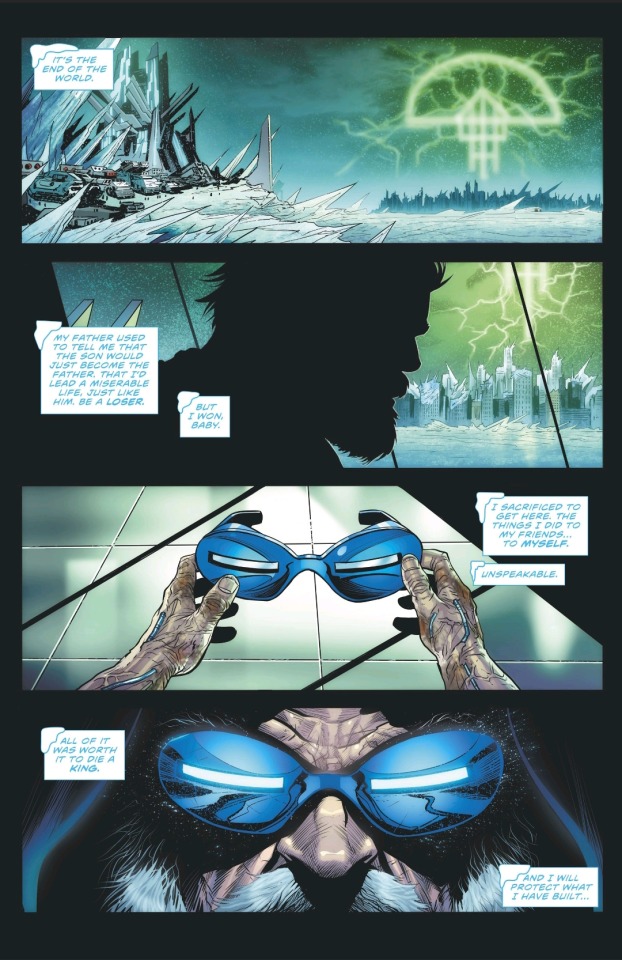
The book begins with four panels of King Cold, Leonard Snart, monologuing to himself. We get a great big focus of the Symbol of Doom in the sky as Snart says that it’s the end of the world, but at least he’s going out like a winner, unlike his loser of a father. One of the many defining characteristics of Cold up to this point and in other stories has been his hatred of his father and his aversion to become anything like him. However, he’s become nothing more than a self-fulfilling prophecy because his life is nothing more than misery because of the sacrifices he made to get to where he is.
Cold helped Luthor’s ascension and the rise of Doom by accepting Luthor’s Gift and allowing himself and his Rogues to become ultra powered, but in doing so, has alienated himself from his friends and family now that they all have what they want. Duce frames all of this excellently by first placing Cold in shadow before he looks at his glasses, as if reminiscing about his old life before putting them on and looking towards his death at the end of the world.
Soon after, we cut to Kid Flash and Avery receiving training from two unlikely sources; Heatwave and Weather Wizard. Though they were seen as reporting in to King Cold a few issues ago, it was brief and mostly to air some small grievances that they had with the way that Cold was running things. Here, we get the reveal that they’d been working with Golden Glider since she broke off from her brother and Mirror Master under their noses. In a brilliant double page spread by Duce and Guererro, we see that they’ve been helping the speedsters keep their speed under control.

It’s a pretty warmhearted scene followed by more where Gold Glider comforts Flash about their presence. Williamson makes Heatwave and Weather Wizard come off as two men that have suffered hardships in their lives, leading them to the life of crime, but still managing to have hearts. Glider tells Flash how Weather Wizard wanted to escape the life of crime that his family was involved in when he was a kid, but never could which lead to him hurting people he loved. Heatwave suffers similarly from his pyromania being the reason his parents died, but it’s painted more as him having a sickness he can’t control. Glider tells Flash that they want to stop Cold so that things can go back to the way that they were.
Duce draws these scenes with a surprising intimacy. Amidst all of the intense action, Duce draws Heatwave with a sense of pride as he watches Kid Flash control his speed better, Weather Wizard stare in his lonesome because of everything going on and shows the kids eating with their teachers after a long day. On top of all of this, Flash has a nice scene where Golden Glider teaches him how to ice skate after he asks her to get back into what was one her hobby. Guererro colors all of these scenes with warm tones, even in the ice which is primarily blue and white. Flash and Glider’s colors give off something of a happy feeling.
One of the recurring themes of this run has been relating to the Rogues in meaningful ways and Williamson does an excellent job here of contrasting all of them to an amazing degree.

After Flash makes a bad joke to Golden Glider, causing her to become morose, Weather Wizard steps in and tells them that they’ve found where Mirror Master has been hiding and the entire crew go to find the last two pieces of his great mirror. Kid Flash asks Golden Glider if she used to date him and she confirms this, stating that she didn’t know why, but that she knew all of his tricks.
Mirror Master has always been one of the Rogues of lesser renown because well… he's an idiot. Only in the sense that he's never used his powers to a degree where people needed to be afraid of him, but thanks to his upgrade they need to. In actuality, his access to an entire Mirror Dimension makes him one of the most dangerous people in the DC Universe as a potential spy or thief because A LOT OF SURFACES REFLECT. Flash and the other Rogues learn this the hard way when Mirror Master springs a trap on them, revealing that he knew that Glider and the others betrayed Cold.
When the Rogues and Speedsters finally encountered Mirror Master, he looks absolutely devious with a wide grin and his wide grin as they did everything they could to stop him. Duce’s poses were dynamic and captured how intense the fight was, the furious facial expressions were very well done and crystalline backgrounds were beautiful. Guerrero’s colors stood out in how distinct each of them were. Mirror Master’s glossy white clashed with the other characters, especially Flash’s vibrant reds and Weather Wizard’s dark greens. By easily besting all of them, he showed just how dangerous he could be.
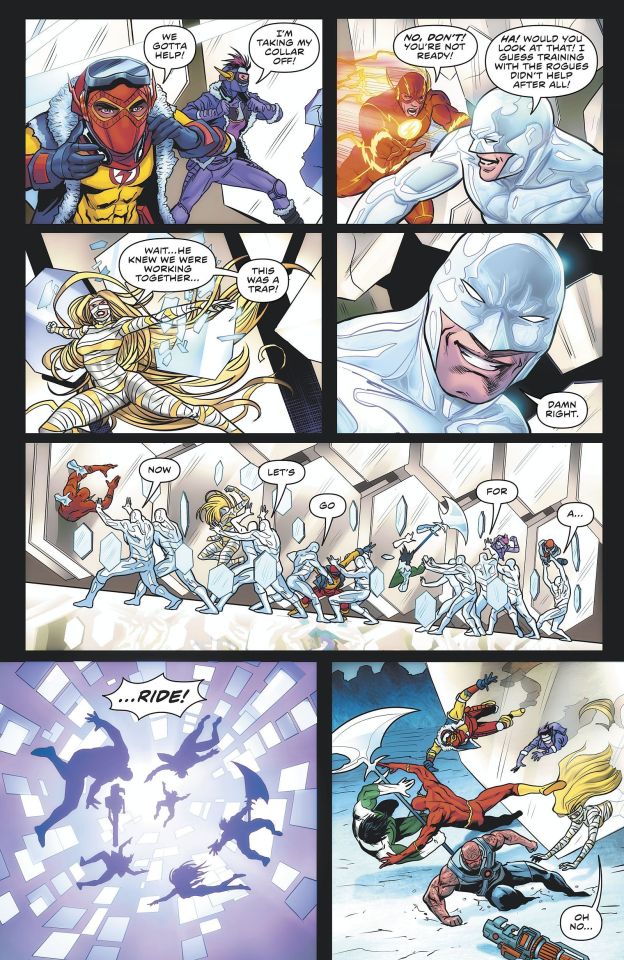
He teleports them all to the King and Snart notes how disappointed he is and how the Rogues could have ruled the world together. This causes Glider to snap at him, saying that he never told the Rogues what that would entail - the end of the world under Luthor. At this point Captain Cold is so far gone that he just doesn't care anymore and Williamson has been leading him down this path since the beginning.
In Rogues Reloaded, Cold had the idea for the Rogues to get one more heist over on The Flash before retiring completely and that was foiled with all of the Rogues being defeated. In Welcome to Iron Heights, Snart decided he'd run an operation from prison but Barry Allen and his former ally, Godspeed foiled that plan too. Because Cold had murdered another inmate to throw off the scent, this led to a fist fight between Cold and Flash which saw Cold's defeat and transfer to Belle Reve Penitentiary. Obviously the defeat had an adverse effect on Cold because he was so sure that he would overcome, but didn’t. He lost again.
Captain Cold has always been one to hold family in high regard since he's never quite had a functioning one side from the Rogues, so his time on the Suicide Squad was devastating to him. I mentioned in past Flash reviews that watching teammates die mission after mission must have done something to his psyche and Lex Luthor took advantage of that when offering him and his actual friends a way to win against The Flash. All of that led to this.
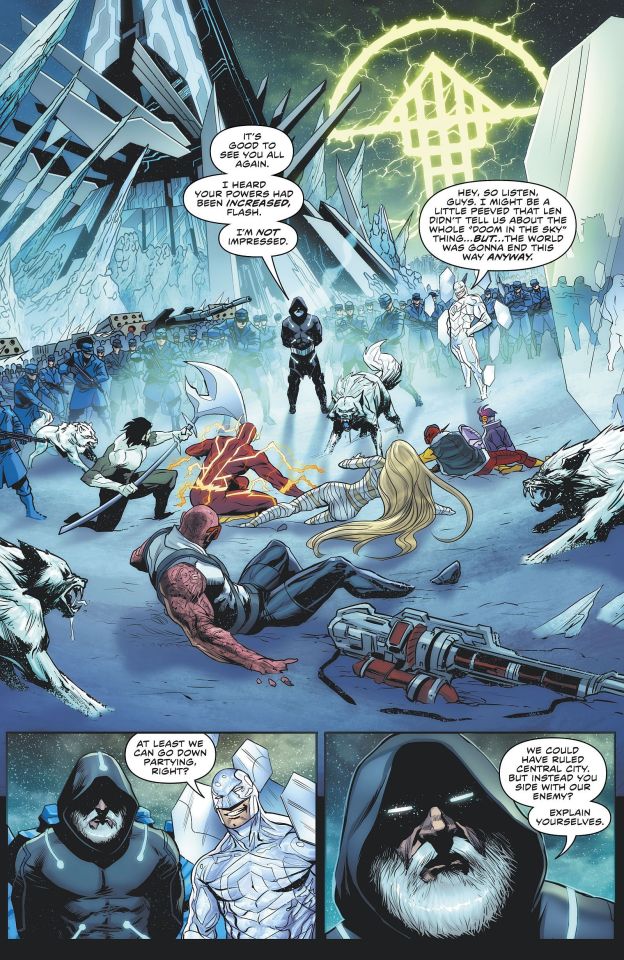
King Cold, feeling betrayed and pissed off, freezes his former friends and sister, leaving only The Flash to fight him one on one again. In their last fight, Cold wanted it to be one on one without any powers, but he lost that fight because of Flash’s iron will. As he removes his cold weather clothes, he reveals that Luthor’s Gift wasn’t just improved gear, but it was a supercharge of power implanted into him. Their final face off will be hand to hand with powers.
This final shot is absolutely poster worthy. Duce conveys the rage emanating from both of them with jaws wide as if they were yelling at each other. Fists are cocked back, ready to pummel their opponent into the ground, especially Cold as he has frozen his arms up to the elbow for maximum impact. What makes this even better is the Symbol of Doom hanging over them in the background like a terrible omen. Guerrero manages o make so many colors fit together in a brilliant display. Flash and his signature red and bright yellow makes him look heroic, the underdog in a fight shrouded in dark greens and cold greys. Cold is paler, his normally blonde hair turned completely white and his arms as blue as his cold blood.
I absolutely loved this.

Duce and Guerrero killed the art in this issue. On the scale of Flash artists for me, Duce is high up there. They manage to blend high intensity action with nice character moments to get the reader invested in character’s emotional states through visuals. Guerrero accentuates this by coloring scenes so that they fit each individual mood and can blend these all together when there’s a clash of ideology or character. Of course, Steve Wands is the glue that holds all of this together his letters are perfectly placed, distinct for each character and give every situation the proper weight to individual lines.
The Flash is an underrated hit that everyone should be reading, especially in regards to the Flash/Captain Cold saga. Their rivalry has been a grand center point on the level of Batman and Bane’s right now or Superman and good storytelling (zing!) I can only wonder where things go from here and what will happen to Captain Cold after this because this is probably the highest he’s ever flown, so how will he fall?
#the flash#barry allen#captain cold#leonard snart#golden glider#year of the villain#dc comics#comics#joshua williamson#christian duce#luis guerrero
12 notes
·
View notes
Text
Why I’m Excited for “Crisis On Infinite Earths”
With the premier of the “Crisis On Infinite Earths” fast approaching, I recently began to reflect on why I’m so excited for it. Sure, I’m an avid Superman and DC comics fan and Crisis is an iconic story, but it’s more than that.
If you were to ask me “When did you know you were a Superman fan?” I would say, “Somewhere between 7 and 8 years old when my upstairs neighbor gave me his copy of The Death of Superman trade paperback.” Of course, at that age, I didn’t know what a “trade paperback” was. To me, it was a comic book; and like so many other children have done with their favorite comics, books, and toys, I carried it everywhere and read it to the point that I nearly had it memorized. I still have it. It’s beat to hell; but it’s bagged, boarded and stored in a safe place.
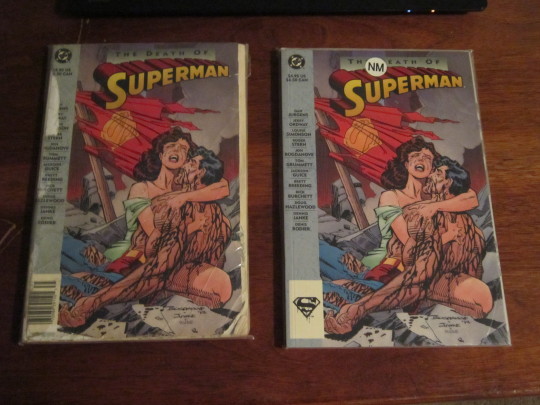
My copies of The Death of Superman TPBs. The one on the left I took everywhere with me when I was a boy.
If you asked me when I became a serious Superman fan and collector I would tell you “My 14th birthday, February 2000.”
My Aunt Susan gave me the Superman Masterpiece Collection for my birthday that year. The set came with a reprinted copy of Superman #1 (printed to the exact specifications of the comic books of that era), a hardcover book chronicling Superman’s Golden Age, and a limited edition statue designed by Alex Ross, made available only with that set.
I still have that, too. It’s a little worn along the edges and corners, but otherwise in excellent shape. I keep it on top of my bookcase. It’s one of my favorite pieces of memorabilia.
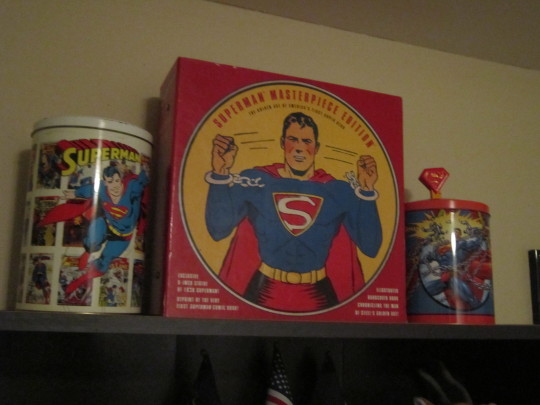
Even then, as much as I enjoyed comic books, I only saw them as a form of escapism; another way to keep people entertained. With explosions, science fiction, action, adventure, and romance; it was the modern version of the Greek mythology stories I read as a boy. They were a great way to keep myself entertained but not much else.
That perception changed when shortly after I graduated high school in 2004. I had received, among many other gifts, Barnes and Noble gift cards at my graduation party; and when I redeemed them, there were only two books I had my eye on:

Crisis On Infinite Earths (1985) and Kingdom Come (1996)
Crisis on Infinite Earths brought a new perception to these fictional characters that I had never before considered. There was depth, drama, and serious world-ending – in this case universe-ending – stakes. Universes were literally obliterated from existence , beloved characters were killed off, and the DC Universe was never the same again.
George Perez even introduced a character, Pariah, whose sole purpose was to witness the destruction of every universe, particularly every Earth, with no way to warn or save anyone. I even remember my jaw dropping at the beginning of the story when Earth 3, the home of the Crime Syndicate of Amerika – evil alternate versions of the Justice League, kicked off the story by being destroyed.
Crisis on Infinite Earths saw the teaming up of characters of the same name from different Earths with similar, but still different, backstories and abilities. The Superman of Earth 2, for example, was the Golden Age Superman; who’s abilities are limited to that of early Superman stories, “faster than a speeding bullet, more powerful than a locomotive, able to leap tall buildings in a single bound.” While the Earth 1 Superman was the modern incarnation with all of the abilities we are familiar with today, namely flight.
What made Crisis so successful, however, wasn’t just that there were variations of the same characters fighting side-by-side to save the multiverse from being wiped from existence, but that no one is safe. One of the most iconic covers of all-time is Crisis on Infinite Earths #7.
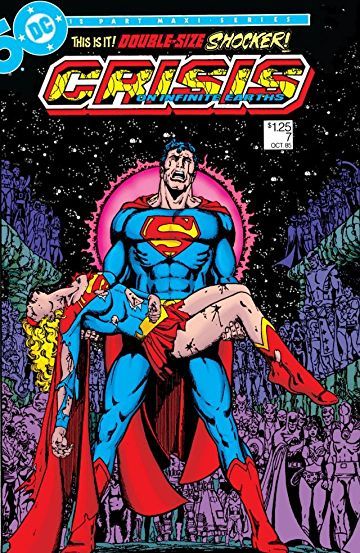
Cover of Crisis On Infinite Earths #7.
That basic design, a hero holding the body of a partner/friend/lover, has been used all throughout comic books; but Crisis on Infinite Earths #7 remains iconic not just because it features the world’s most powerful hero holding the dead body of his cousin, who’s abilities are nearly equal to his, reduced to a groveling mess, but because it was proof that absolutely no one was safe. By issue 7, everyone knew the stakes, and the heat was on.
What made Supergirl’s death so memorable and iconic, however, wasn’t just that she died in battle, but that she sacrificed herself, knowing what she was doing would kill her.
Following Crisis, DC rebooted the entire universe and in that reboot, they intended the Superman to be the last Kryptonian rather than the last son. So rather than letting Supergirl become another faceless casualty, she received a hero’s farewell by protecting her cousin - the entire reason she was sent to Earth in the first place.
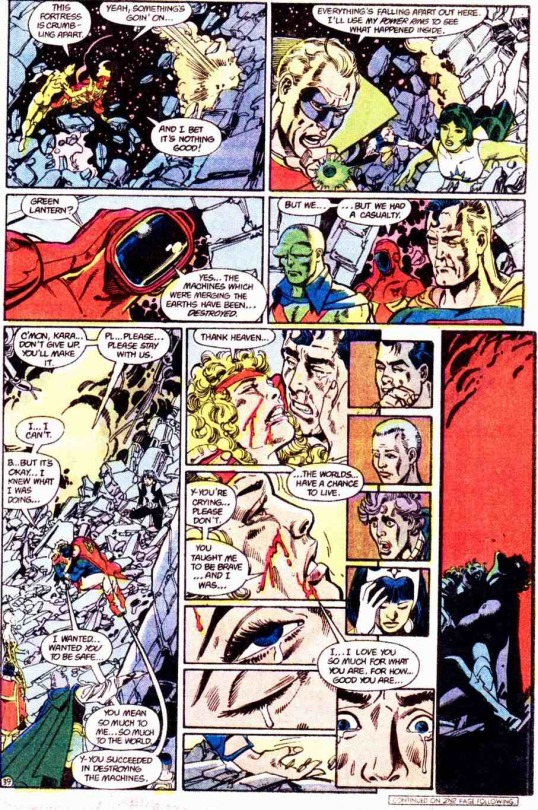
The death of Kara Zor-El.
The story didn’t slow down there, either, the following issue saw the death of Barry Allen, A.K.A. The Flash. While the cover isn’t nearly as iconic as the previous, Barry’s death is because it, again, involves self-sacrifice.

Cover of Crisis On Infinite Earths #8.
Throughout the story, Barry’s “ghost” would occasionally pop up, looking less and less ghastly each time; and that was finally explained in issue #8 when Barry ran to create a speed vortex that would draw power from the weapon designed to destroy Earth. The power became too much for his body to handle and he literally ran backwards in time until he disintegrated and became the very lightning bolt that gave him his abilities.
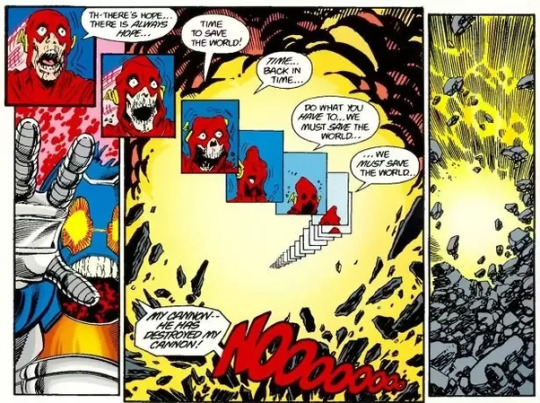
The Death of Barry Allen.
Crisis On Infinite Earths upped the ante in comic book storytelling. It showed that just because the characters aren’t real doesn’t mean they’re immortal and, more importantly, it shows that we can feel connected to them just like we get with a character in our favorite TV show. When I finished reading Crisis I began to take a deeper look at comic book characters and was able to identify what made each character great and different in their own way. Sure, Batman has the money, gadgets, and the car - but it doesn’t mean he won’t long for his parents anytime he sees Superman with Jonathan and Martha. There is much more to comic books than colorful costumes and wacky villains; and it was Crisis On Infinite Earths that helped me realize that.
After Crisis, I picked up Kingdom Come.
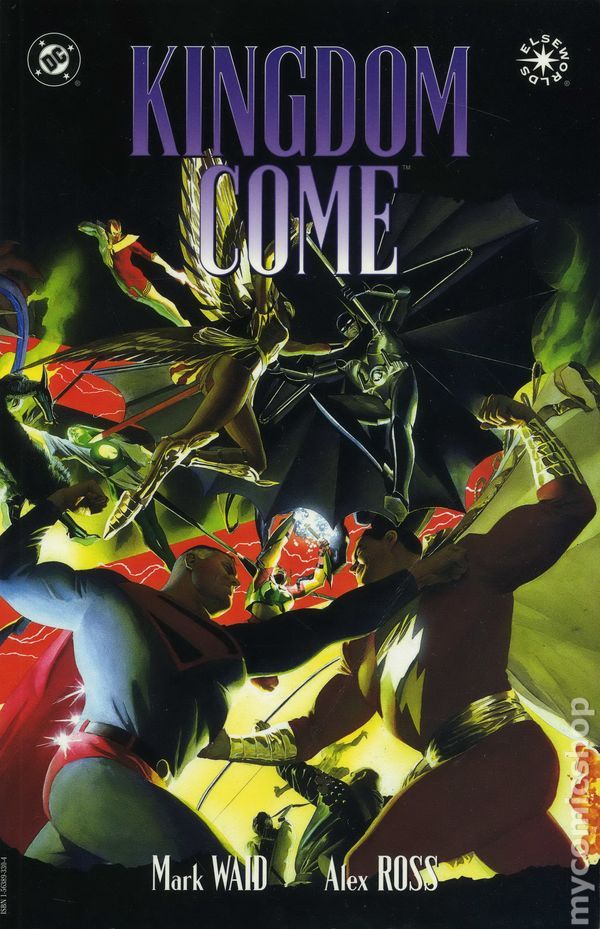
Wow.
Let me say that again.
Wow.
Putting aside the writing for now. The art alone is enough to sell the book. Alex Ross is a legend, and his art speaks for itself. I had only ever seen his work in single images, not in comic book panels and I was in awe with how well everything seamlessly flowed together. To this day, Alex Ross’ work in Kingdom Come is among my favorites and will always hold a very special place in my heart.
Now. The story.
Mark Waid could walk into a convention and my heart would stop.
He ranks among some of the very best comic book writers and when you read Kingdom Come, you’ll see why.
Like Crisis On Infinite Earths, Kingdom Come opened my eyes in comic book storytelling that I had never before considered; this time with politics. In my last YouTube video, I talked about how comic books have always been, in some way, political. As children we don’t notice it as much but when we grow, mature, and begin to notice how the world works, we finally become aware of topics we were blissfully unaware of as children. Politics in comic books is one of them.
With Kingdom Come the politics covers not only generational gaps between yesterday’s heroes and the story’s current heroes, but we also see the government get involved out of fear of the destruction the two groups of heroes could cause should they not resolve their differences. Within that narrative was the conflict occurring among the primary characters. Superman and Wonder Woman, while working together, did not see eye-to-eye, Batman wanted nothing to do with their efforts while (shockingly) assembling his own team in accordance with his own plan that involved Lex Luthor and other classic supervillains, and a brainwashed demigod as the wildcard.
Most of all, the story portrayed a war and how the biggest victims aren’t those fighting in it, but those they claim to be fighting for; the unintended casualties. Sure, we feel for the casualties of the war, but it wasn’t until an enraged Superman nearly brought the roof down on the government who did what they did not out of malice, but fear.

Superman nearly loses control in Kingdom Come #4.
Kingdom Come is easily one of the most powerful stories I have ever read and remains in my top 3 favorite stories. It’s one that I would recommend to anyone, even if they aren’t a comic book fan. Hell, the first Superman shirt I ever bought for myself was Kingdom Come.

I need to get a new one.
Then there’s Brandon Routh.
Routh (rhymes with “south”) was cast to play Superman in 2006’s Superman Returns. While the movie itself was a bit of a disappointment and divisive amongst fans, Routh’s performance as the Man of Steel was not.
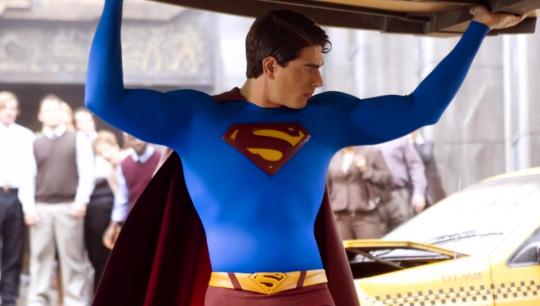
Brandon Routh as Superman in 2006’s Superman Returns.
I was 18 and in my first semester of college when the news of Routh’s casting hit. I was excited. Excited that he was an unknown actor. Excited that he was young and that a franchise could be built around him, excited that he grew up a Superman fan, excited that – like me – he grew up in a part of the country where Superman’s values are ingrained in everyday life. I was truly excited, even if other Superman fans weren’t.
Brandon Routh received, in my opinion, an unfair amount of criticism when he was cast, when pictures of him in the suit were released, when trailers were released, when the movie was released, and even to this day. Honestly, I feel fans and critics weren’t willing to give him a fair chance because he wasn’t Christopher Reeve and was compared to Reeve before the first picture of him in the suit was released. I was one of those fans who tirelessly defended him on the internet. I was insulted by fans, my family was insulted, called names, I was even accused of not being a “real Superman fan” because I was giving the movie my support. I was young, though, and didn’t realize then how pointless it was to argue over the internet; so I kept at it.
I was so excited for the movie I ordered my ticket for opening day the day tickets went on sale. I set out the Superman shirt I wanted to wear to the movie, drove an hour and a half from Limon, CO to Denver to see it, and arrived early to make sure I got a good seat. I had waited my entire life to see Superman on the silver screen and nothing was going to stop me from making it the best experience possible.
I’ll be honest. I enjoyed the movie. I was a bit underwhelmed because I had hoped for more action sequences and felt the story could have been stronger; but that didn’t stop me from walking out of the theater with a smile on my face, seeing it a second time, or looking forward to what the sequel had in store. Hell, at the time Superman Returns came out, I was an aspiring actor and I DREAMED of being cast as John Corben, also known as Metallo, in the Superman Returns sequel and going blow-to-blow with Routh’s Superman.
Ultimately, I think the premise had more to do with my excitement than anything else. I loved – LOVED – the idea of Superman being gone for 5 years and returning to a different world; especially with everything the world had been dealing with between 2000-2006.
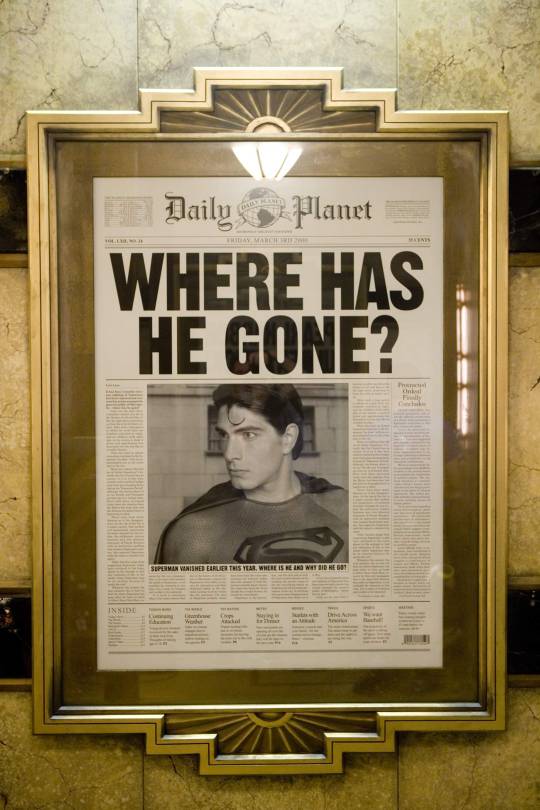
From Superman Returns. The date of the article is March 3, 2000.
What if we had Superman on 9/11? What would have been different? How many lives would have saved? Would he have stopped the second plane from hitting the south tower? Would he have prevented it altogether? There was so much that could have been done with that premise that, I feel, was left on the table.
To this day, I believe that instead of being a continuation of the Christopher Reeve films (a decision I supported at the time) I think Superman Returns should have featured a young Superman who fled back to Krypton when he heard the rumor it might still be there. Jason should have been Lois and Richard’s child, Martha should have died while Superman was away, Lex Luthor or Cadmus Labs (both?) should have been trying to clone their own Superman that would turn into Bizarro, Superman should have spent less time pining over his lost love with Lois, and I have always, and firmly, believed there should have been a scene of Clark sitting alone in the Daily Planet film room, glasses in hand and tears in his eyes, watching footage of the September 11th terrorist attacks. Those elements would not only have given Superman Returns a stronger story, it would have made him much more relatable to the casual moviegoer and still would have provided plenty of action for fans.
Despite all of that. I still enjoyed the movie. I enjoyed it so much that when it was available for pre-order on Amazon, I bought the Two-Disc Special Edition.

I still have it.
When Routh made an appearance at Rose City Comic Con in 2018, I made damn sure I met him.

He signed my copy of the Superman Returns comic book adaptation and I’m still geeking out about it.
Of everything I enjoyed in Superman Returns, the plane sequence, the bank robbery, Kevin Spacey’s Lex Luthor, Superman flying around saving the city; if I had to pick one thing that I enjoyed the most in the film, it would be Routh himself. While his portrayal of Clark Kent was clearly inspired by Christopher Reeve, his Superman is where he shined. He stood tall, walked and spoke with confidence, and could intimidate someone by his presence alone – until he smiled that warm Superman smile and said something that would calm even the most nervous person like he did with an upset Lois Lane on the roof of the Daily Planet.
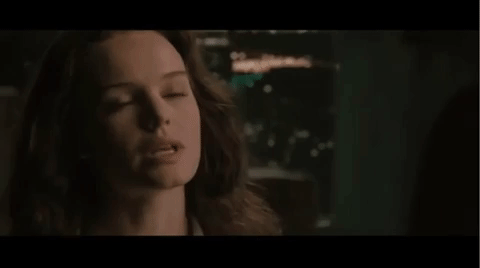
“Will I see you around?”
“I’m always around.”
Because Superman Returns didn’t fare as well in the box office as the studio had hoped, the sequel never happened and that was the end of Routh’s tenure as Superman. I was disappointed, but I understood. It’s a business. Making money comes first and Superman Returns, while profitable, didn’t make nearly enough.
Time marches on and we got more comic book adaptations. Smallville continued for another 5 seasons, ending its run after season 10 and inspiring a spin-off series about the Green Arrow, inspired by Justin Hartley’s popularity of the character in Smallville. Arrow, set apart from the Smallville series, came out swinging and quickly rose in popularity. Then in season 2, came future superheroes as recurring characters: Barry Allen, played by Grant Gustin, and Ray Palmer, played by Brandon Routh.
I was SO excited to see Routh back in the comic book medium. The only thing that would have made me happier was if they brought him back to play Superman; but alas, I knew it didn’t fit with Arrow’s reality.

Routh’s performance as Ray Palmer was different than I expected. Ray always came off as a serious character in the stories I read, not as the “Aw shucks” kind of person Routh portrays him as. It made sense, though. Stephen Amell’s Oliver Queen had enough serious to go around for everyone; there needed to be a lighthearted superhero to balance that – like Superman is to Batman.
It worked too! Routh became popular on the show and before too long, was starring alongside other actors who portrayed those lesser known heroes in Legends of Tomorrow. As the Arrowverse continued to up the ante and bring in other shows and characters, so did the expectations; and like the comics the shows are based on, annual crossovers became a thing.
They started small with the first 2 being two-parters with The Flash and Arrow, then expanded across all four shows for Invasion! and Crisis on Earth X, dropped to a 3-parter with Elseworlds while also setting up the Batwoman series, to an epic five-part series based on one of the most iconic stories of all time that showed me how serious comic book storytelling could be.
Then there’s Brandon Routh.
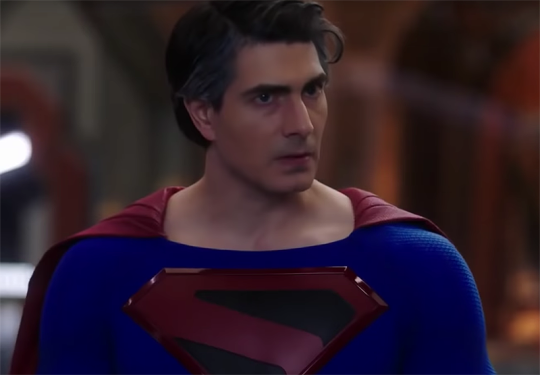
Not only is he returning to play Superman, he’s playing the Kingdom Come Superman!
I can’t take it anymore. Seriously.
The first actor I ever saw play Superman in theaters – the first Superman actor I have ever met in person, is playing the version of Superman that helped me realize the kind of message that comic books can tell, in an adaptation of an iconic story that showed how serious a comic book can get. Both of those stories, Kingdom Come and Crisis On Infinite Earths, made me into a comic book fan. Not just a Superman fan, but a comic book fan.
Now I have another comic book that I need to get signed by Routh the next time he visits the Pacific Northwest:

It’s gonna happen – and I’ll be sure to get a picture with him while wearing a Kingdom Come Superman shirt.
Fans can always remember what made them fans of their fandom. Crisis on Infinite Earths and Kingdom Come is that for me. Add the casting of Brandon Routh as Superman in Superman Returns shortly after reading those two iconic stories, and It was a done deal for me.
Seeing all of these impactful moments that helped mold my fandom being rolled together like this is, to say the least, emotional. Never in my life did I expect to see any type of live action adaptation of Kingdom Come or Crisis On Infinite Earths; and I certainly never imagined I’d see Brandon Routh play Superman again. It really is a fanboy’s dream come true.
The only thing that could make it better, for me anyway, would be if Routh’s final line as Superman is his best line as Superman:
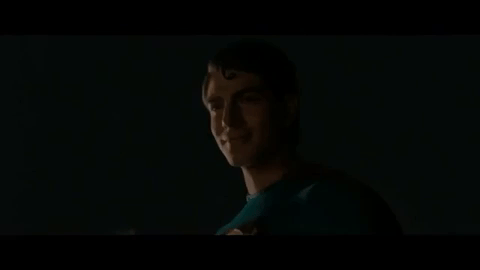
“I’m always around.”
#crisisoninfiniteearths#kingdomcome#superman#supermanreturns#arrowverse#arrow#flash#supergirl#legendsoftomorrow#brandonrouth#deathofsuperman#raypalmer#theatom#dccomics#cwtv#dctv#dcuniverse#dcmultiverse
2 notes
·
View notes
Text
Comics I read this week (8/26 - 8/30)
Hey anyone and... anyone I guess. For all those looking to get into comics or who are already comics readers but don’t know which books are good, here’s an opinion on just that!
Give it a read, let me know what you think, light some pitchforks, whatever you like:
Justice League #30
I was conflicted reading this week’s issue of Justice League: while I’m really liking the direction that Scott Snyder is taking the story, I’m really getting sick of Jorge Jimenez’s art on the series.
While Jimenez was a breath of fresh air on the “Superman: Rebirth” series with his CG texturized drawing and smooth surfaces, his ultra-stylized and cartoony figures are starting to look more plastic and stretchy as this series goes on. He’s got a bad habit of smoothing over his character’s proportions, which make these heroes that are supposed to be cut and strong look flat and almost doughy. It’s starting to grind on me more as each new issue comes out, and maybe it’s time for an artistic switch-up on this title.
In terms of the story though, this was a good set-up issue for the Justice/Doom war that Snyder and co. have been building up to on this run. We’ve got all the pieces in place: a gathering of forces by both sides; a romp through time which sees the League meeting with both Kamandi and the classic JSA; and everything going awry right from the get-go!
The only thing I’m slightly concerned about storywise is that Catwoman was in the Doom lineup, and with the rekindling of Bat-Cat in the latest Batman issues, I’m hoping this isn’t a portend for another breakup in King’s run. My heart couldn’t take another.
Superman #14
Let me be clear on one thing before I start in: I’m a fan of Brian Michael Bendis. His work on “Ultimate Spider-Man,” “Daredevil,” and “Alias” are some of my favorite comics, and his more recent work with “Naomi,” and “Event Leviathan” has been really good. With all that being said... man, this Superman comic has sucked hard since he took over.
Let’s just start at the story:
It’s felt like Bendis has been really looking forward to getting started on his upcoming run with the new “Legion of Superheros,” which is something to potentially get excited about for the near future. What’s not exciting at all is the realization that this whole Rogol Zar arc has been a poorly thought out lead-in to the Legion’s return. SPOILER WARNING FOR ANYONE WHO WANTS TO READ THIS GARBAGE FIRE: the Legion show up at the end of the issue to invite Jon to join, as a commemoration of the day the United Planets was formed. This is fine, and could be an exciting new direction for Jon that harkens back to the classic comics. BUT did we really have to suffer through weeks of nonsensical story just to get this?
Just to recap this arc: Rogol Zar appears out of nowhere, looking like Lobo, Doomsday and a garbage disposal with a bland imagination all had an orgy and he was the deformed kid that came out of it. This beefed-up piece of blandness comes out of the sky to fuck up Superman cause he heard there were some Kryptonians still alive in the Universe and apparently he’s a space-racist.
Superman struggles against this remnant from the 90s while the worlds shittiest not-dead Grandpa, Jor El, is off in space traumatizing Jon and stressing him out so much he ages up to a teenager.
But it’s ok guys! Jor El knows who Rogol Zar is, they have a connection of sorts! And Rogol Zar caused the destruction of Krypton! But now he’s allied with Jax Ur, and also now Zod maybe? And the Thanagarians are involved? So are the Guardians? Wait, now Rogol Zar is also effected by Kryptonite because he’s a Kryptonian? And now he’s just captured like that, but Thanagar’s under attack, oh wait just kidding it’s not?
Those last 2 plot points literally happened in 3 pages this issue, right after each other. So this story is confusing and non-sensical and ultimately doesn’t mean anything, because the whole point turned out to be that Bendis needed something, some plot device to make it so Superman could say “we can’t have secrets like this tearing apart worlds like Krypton, we need a United Planets.”
None of this crap story is helped by Ivan Reis’ art, which I know some people love, but to me it looks like everything bad with the 90s except with better backgrounds and textures. But even if I didn’t hate his art, his page and panel composition is often confusing, especially during fight sequences, which doesn’t help when the story is confusing to begin with.
After reading this week’s issue, I want nothing more than to die in the garbage fire Bendis has lit and take this whole comic with me.
The Terrifics #19
Shouts out to DC for finally figuring out how to write a Fantastic 4 comic, maybe they can show Dan Slott how it’s done. But seriously, “The Terrifics” has been the exact kind of science-adventure story that needs to be around in comics, as the landscape needs it’s fare share of science-criminals and heroes to balance things out.
First thing to note for this week, the art is great. Max Raynor (first time I’ve seen their work) has a great kind of cartoony playfulness to his characters and line-work, while at the same time keeping the models tight and well detailed.
I’m glad that the writers of the story realized that the Terrifics function best when they’re dealing with light-hearted cross-dimensional adventures, and this new one seems like it’ll be great from the start. In keeping with the “Year of the Villain,” Lex Luthor has made an offer to Bizarro (the one for the HTREA, not the one from the Outlaws), giving him a time-machine device to reek some havoc with.
I don’t want to spoil the issue too much, as if you haven’t read the Terrifics you really should give it a go, but let’s just say that it involves Bizarro at one point destroying Algebra, and a Bizarro Terrifics team known as “The Terribles” breaking through to the main DC dimension to challenge their Terrific rivals.
If you’re looking for something fun, cheesy, but heartwarming and action packed, definitely give the Terrifics a try.
The Flash #77
Look, I’m still not digging this whole “Force War,” or “War of the Forces,” or whatever the Flash team is trying to build up with these new force users. It felt like the DC Creative team was trying to retcon Flash to be more mythical with “Flash: Year One,” pitting the Flash against the Turtle and creating this whole mythology around the Forces of the Universe to make it seem like this clash was inevitable.
But what this has done for me is just make the Flash feel smaller and less special. These forces and the grander narrative behind them have just diminished the Speed force, which was still shrouded in some mystery after all these years in the DC Universe, to just one force, just A force.
There are two silver linings from this week’s issue, one more bittersweet than the other. First off, the art has gotten ten times better than it’s been in weeks. Rafa Sandoval’s pencils are crisp and clean, and though his action feels static sometimes, he’s miles better than what we’ve been seeing for a few months now.
Second, though this Force War already feels like a dud, a cool concept was introduced in a throwaway line. Flash fans, feel free to crucify me, but with the Black Flash’s appearance this week, Commander Cold talked about how he was acting like an anti-body for the Speed Force in trying to eliminate these new force users. If that’s true, it makes the Speed Force almost like a living creature that feel’s like it is under attack. But this also makes me think that, wouldn’t it have been cooler if you had the same motivation for the appearance of the Black Flash, but instead of the Force users, it was Speedsters it was targeting?
What if all of the new Speedsters were putting a strain on the Speed Force, hurting it in some way that awoke the Black Flash? It’d still give Barry a reason to reconcile with Wallace and Avery, but would also replace this Force War with a Speed War? Spitballing here, but that sounds cooler to me.
Ice Cream Man #14
And now we break up the superheroes for something a little more horrific. For anyone who doesn’t know what “Ice Cream Man” is, the best way I can categorize it is a horror anthology series.
The story, setting and characters change from week-to-week, except for one presence: the Ice Cream Man. Even when he’s not in whatever nightmare is being doled out that week, his fingers can be felt all over the story, and they dig into the fears you try to hide and pry them open.
The theme of this week’s story was communication, and maaaaaaaaan does this comic have a way of making you feel depressed and scared all at the same time.
The two main characters are a husband and wife, the former who is deeply dissatisfied and finds escape in crosswords, the latter who is so starved for communication and intimacy that she makes problems out of nothing just to have something to talk with her husband about.
I don’t want to spoil too much, as I think everyone should be reading this book, but things take a turn for the hellish when the husband goes out to buy more crosswords and finds himself trapped in one, while his wife finds out that her delusions may have been true, and worse than she thought.
For long-time readers, the biggest thing from to take away from this issue is that perhaps the Ice Cream Man’s influence is spilling out into the world more and more, and things will only get worse from here.
Spider-Man: Life Story #6
For any fans of Spider-Man, go out and buy this book. Doesn’t matter if you’re a new fan or a hardcore fan, this is a story for anyone who has any love for Spider-Man in any shape. This story isn’t perfect all the way through, but man is it an incredible ride.
For anyone who hasn’t heard of this comic, writer Chip Zdarsky took the gargantuan task of creating one long-form story out of the entire continuity of Spider-Man, from the 1962 till 2019, and showing how this life that we’ve seen Spider-Man live would actually play out in real-time.
This comic took some of the best and worst arcs, from “Kraven’s Last Hunt,” the birth of Venom and “The Superior Spider-Man,” to “The Clone Saga” and the Inheritors (god those pseudo vampires were dumb), and not only makes them work within this different world that Zdarsky has made, but makes them work as a part of the larger narrative.
While it’s not perfect all the way through, seeing the characters we know and love, especially Peter and MJ, live their lives with wrinkles and all feels like something special, and I encourage anyone who is curious to go out and cop this 6 issue series and join the ride.
Runaways #24
For all manga fans out there, I’m a huge fan of the “slice-of-life” genre. For any non-manga fans, slice-of-life stories are ones that celebrate the everyday little moments that make up most of our lives. Riding bikes with friends, going to the movies, starting a new hobby, or even just going to the store and deciding what to get for dinner, these are all the kind of topics that a slice-of-life narrative covers. With her run on “Runaways,” Rainbow Rowell has essentially made a superhero slice-of-life comic, and I’m really liking every moment of it.
This week’s issue focuses almost entirely on Karolina and Nico spending a night out “superheroing.” Except it becomes apparent pretty early on that neither really knows what they’re doing, and whatever little problems they run into (fender bender on the 405, potentially lost children, etc.) are better left to themselves, as they either wouldn’t be able to help or would actually get in the way. It’s weird to say that watching superheroes be ineffective is really entertaining, but that’s exactly what I’m saying, and I think that is in large part to the good character writing that Rowell has done on her run, and the warm art of this series that helps you feel safe and cozy.
My favorite part of the issue is when Karolina and Nico stop for a bite to eat, and Karolina feels like she has to apologize for wasting Nico’s time. Nico just laughs it off and tells her that she was just looking to spend time with her partner, so in her eyes tonight’s mission was a success. It’s cute, it fits with the characters and how we’ve seen them grow over the run, and I like it a lot.
That’s not to say there isn’t any action in this issue. By the time the story is done there’s a super-powered dance fight and a mysterious new superhero debuting on the scene. I’m excited to see where both of those threads go heading into the next issue.
Justice League Dark #14
Since the Rebirth of this team this has been one of the comics that I look forward to the most each new issue, and this is quickly becoming one of my favorite iterations of the team. While Batman’s gothic-detective aesthetic fit well with the team, he always felt too based in technology and the modern world to really embrace magic. On the other hand, Wonder Woman is a walking myth, a demi-god on earth, someone who is made of magic. Her role as the leader of this team alongside heavy hitters like Zatanna and Swamp Thing, along with smaller characters like Detective Chimp and Man-Bat, has felt natural and authentic.
Another great part of having Diana on the team rather than Batman is that her personality stands out. Whereas Batman and most of the magical characters in DC are generally tragic, Wonder Woman is a symbol of hope and optimism, someone who fights to see the best in people and bring that best version out of them. This works especially well with her band of misfits, who despite having much more experience than Wonder Woman in the world of magic, have far less experience in being part of a team, let alone in being “superheroes” in the traditional sense of the word.
As for this issue, it’s a set-up chapter that ticks all the right boxes. We’ve essentially got the “Dark” Justice League Dark coming together, led by a newly powered up Circe, who are raring up to wage a Witching War against their good counterparts. While their final players are coming into the fold, the villains have already managed to plant a couple of seeds of doubt into the team which will certainly bloom into dissension. Can’t wait to see where this goes next.
Friendly Neighborhood Spider-Man #11
Tom Taylor gets Spider-Man.
It’s a simple statement, but as we’ve seen over all of the years with Spidey, not a whole lot of writers have really understood what makes Spider-Man so spectacular, amazing, superior, etc. It’s a testament to how well Tom Taylor is writing Spider-Man in this series that he’s telling small scale stories without a whole lot of action, death-defying adventure or real conflict, and yet this is some of the best Spider-Man I’ve read in years.
The opening pages set the tone for the story right away, with one of the simpler but most honest statements I’ve seen in a Spider-Man book:
“See, Captain America is Captain America. Thor is Thor. But Spider-Man...
Spider-Man is Peter Parker...
And Peter Parker is my responsibility.”
That’s the thesis statement for this story, detailing a day in the life of Mary-Jane Watson, the often under appreciated girlfriend of our titular web-head.
The story from then on is pretty much in her hands, with occasional monologuing from a sleeping Peter, as Mary-Jane goes about what we can only assume is a pretty typical day in the life of the girlfriend of one of NYC’s premier heroes.
Small scale stories are essential in superhero comics in order to break up long events and arcs. They’re breathing room, time for the readers to catch their breath and assess the new status quo before things get wild again. But they’re also often the stories which show us the foundations of who these heroes really are. It’s been said that power doesn’t corrupt, it reveals, and when characters with as much power as Spider-Man aren’t up against the wall and forced to make a decision, the decisions they do make show us that much more about the person beneath the mask.
Tom Taylor has managed to show us just who Spider-Man and the people in his life really are underneath their masks by lowering the stakes. The stories are small and simple, the consequences often equally so, but what’s been created is true to the characters more than almost any stories I’ve seen before, and it’s lovely. This is one of the best books being written right now, and if you’re not reading it yet, you need to go out and fix that right now.
Detective Comics #1010
It feels like there isn’t much to say about this week’s issue. We’ve still got the stranded billionares on the island, who are now clearly being held hostage by Deadshot. Meanwhile Bruce is rescued and patched up by two WWII fighter pilots who have been stranded on this island since the war, neither knowing which side won.
I’m a big fan of Deadshot when he leans into his nihilistic killer persona, and this “The Most Dangerous Game” setup with a tech-deprived Bruce and Deadshot duking it out on an island seems interesting. Tomasi has been generally pretty good with his run on Detective Comics, so I’m excited to see how long he runs with this arc of Bruce and Deadshot trying to outsmart each other in this deadly game of cat and mouse.
1 note
·
View note